
Pontoon Boat vs Catamaran: What’s the Difference?
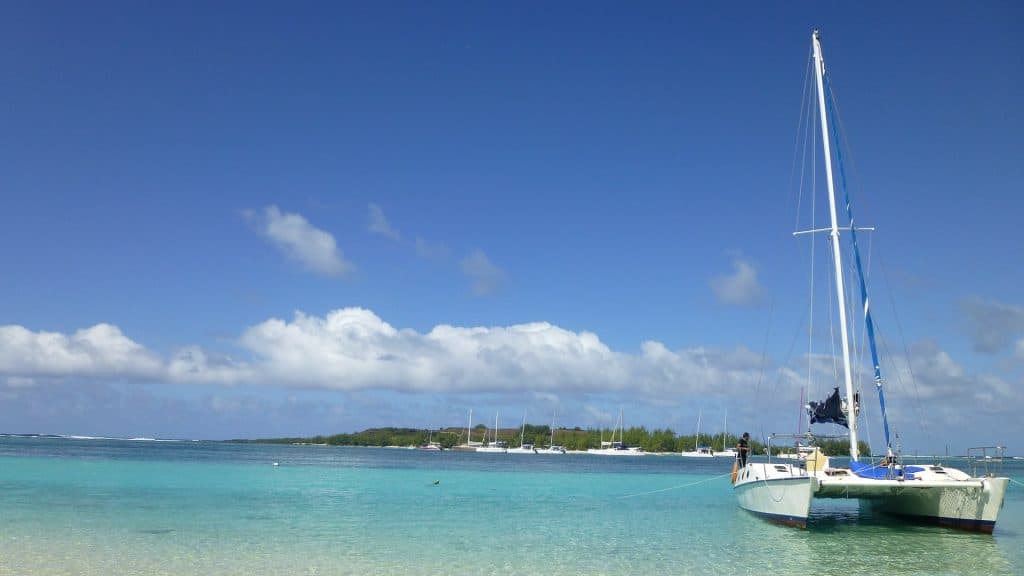
There are many types of boats. Despite sharing many similarities, some boats are better than others for a specific use, and after scouring every source of information, maybe you still can’t find the right guide regarding the topic of a pontoon boat vs catamaran.
Well, say no more, because this is the one you’re looking for.
We’ll take a look at which is which and what the better choice is for a potential buyer. So let’s get down to the basics first.
What makes a pontoon boat a pontoon boat, and what makes a catamaran a catamaran.
Pontoon Boat
A pontoon boat is a type of boat focused on recreation. It's easily identifiable by its unique hull structure, and large deck area. The boat itself does not float on water but rather sits on top of a set of floatation devices called pontoons hence its name.
These pontoons are filled with air inside and are air-tight like a balloon. Also they are practically unsinkable due to their design and they work amazingly well even when in shallow waters .
The pontoons themselves have high carrying capacity and give a sense of security to the owner knowing that he/she can carry a lot of passengers and gear. For reference, military-grade pontoons can even carry fully loaded armored tanks, so yeah pontoons are amazing.
Pontoon boat manufacturers just add a deck , a roof, and other amenities and accessories on top of these pontoons. Think of a living room stacked on top of a set of hotdog-shaped lifebuoys, add an engine to that and that’s pretty much what a pontoon is.
A catamaran is a type of boat that is also easily identifiable due to its unusual hull design. Unlike a common yacht or fishing boat that has a v-shaped hull, a catamaran takes this one step further by having two v-shaped hulls, one on either side and connected by a bridge deck.
This has several benefits including increased stability, a larger deck space, can be used on shallower water, and has better fuel efficiency since less of the boat is in contact with the water.
Imagine two boats side to side, with a living room connecting both of them, and that’s pretty much what a catamaran is.
Pontoons vs Catamarans

Both have unique hull designs, both are stable and both have massive deck sizes. So they’re practically the same boat right?
Well, no. Despite being similar in many aspects, they are designed with different purposes in mind, and thus are better in their respective roles.
But before we head down to what makes a pontoon boat better than a catamaran or vice versa, let’s focus on the differences between them in each criterion the average boater should have knowledge of.
Pontoon boats are great for relaxation and cruising. They have a wide-open deck that is well suited for these types of activities. If you love feeling the wind in your face as you move through the water at a relaxing pace, then a pontoon boat is perfect for you.
Catamarans are designed with sailing and open water cruising and thus have a more luxurious indoor setup, but also have a high visibility upper viewing deck for sightseeing. If you’d like to bring an entire house with all the amenities on those marine adventures, catamarans are one of the best options for this.
Hulls and Deck Access
Earlier we’ve introduced that pontoon boats do not have a hull of their own but rather a set of pontoons, commonly two of them with a special case being tritoons which as the name suggests have three pontoons keeping the deck afloat.
Pontoon boats have a high amount of buoyancy due to their design and are capable of shallow water travel, high carrying capacity, due to the increased surface area in contact with the water.
The moment you step onto a pontoon boat, you’re already on the deck. As these boats are known for their wide-open and flat deck, climbing on top of one is easy enough as the deck itself is just a few inches above the waterline. Pontoon boats also have multiple access points which are easy enough to maneuver through.
A catamaran, on the other hand, uses the standard v-shaped hull but has two of them side by side and is connected in the middle by the bridge deck. Using a v-shaped hull means that a catamaran can travel at speed, and since it has two of them, the increased buoyancy allows it to travel on shallow waters and have reduced hydrodynamic friction leading to more speed, stability, and a better fuel economy.
Deck access on a catamaran is a bit more difficult compared to that of a pontoon, as it requires you to use a series of steps and ladders to reach the upper deck because it lies a few feet above the waterline in stark contrast to the few inches a pontoon decks height rests at.
Catamarans have rooms and thus larger doors which may be uncomfortable to fit through for some, but it does have luxury and security in mind and has a limited amount of access points compared to a pontoon boat.
Pontoon boats are recreational by design, and thus they are of a smaller size. They lie somewhere around 15-50 feet, which is plenty of room for whatever short-term activity you have in store for it.
Catamarans in comparison to pontoon boats have massive berths because they are designed for luxury cruising and can handle a wider variety of weather conditions. You can’t take a pontoon boat out on the open water, but a catamaran can handle both open and shallow water. These vessels range from around 40 to even 145 feet in length.
Intended Use
Pontoon boats are great for short-term social gatherings, fishing , and watersports like skiing and tubing . They are intended to be used as recreational vessels and they are absolutely outstanding in that regard.
Catamarans are meant for travel while being at the highest tier of the luxury and performance side of things. Thus if you’d like to have everything on your boat, because you travel from one place to another, yet want to maintain comfort, speed and then some, then catamarans are for you.
Propulsion is the method by which a boat moves forward, thus we’re going to be comparing the catamaran and the pontoon boat in this aspect. But before that, we need to understand that the catamaran and pontoon boat are designed differently and there will be a clear winner in each category.
Catamarans are mostly powered by sails. High-end catamaran boats do have engines, but they use these sparingly and only in emergencies. Being powered by sails, engine noise is not an issue for catamarans.
Pontoons, on the other hand, can be mounted with multiple engines of varying horsepowers, and a solar-powered version can even come with an electric engine if you prefer a more silent ride.
Sails rely on wind and can be powerful when used correctly, unfortunately, there will be some use cases where there are no winds, and using the catamaran’s engine just doesn’t cut it. That said for long-distance travel out in the open water, nothing beats the efficiency of being able to move your boat for free.
As pontoons have their own dedicated engines, power is constant and can be delivered on cue. If you want power at any given time rather than over a period of time, pontoons have this in the bag.
Pontoons can travel at around 15-25 miles an hour, which is more than enough speed for your average watersports enthusiast and can cruise slow enough for more relaxing boating trips. For more details see our guide: Pontoon Boat Speeds
Catamarans can travel around 11-17 miles an hour and are roughly a third faster than their monohull counterparts. As previously discussed, catamarans rely on the wind thus their speed varies greatly, however for long-distance trips over a comparably long span of time where high speed isn’t really a necessity, catamarans win easily.
Capabilities
Pontoons can carry a relatively sizeable number of passengers during a single trip and are capable of pulling inflatables or nets when needed as pontoons tend to be quite powerful despite their compact size.
Catamarans can do almost everything that a pontoon can do and more. It has viewing decks, living quarters, bathrooms, and a fully functioning kitchen. However, it isn’t entirely perfect since it can’t produce power on cue due to its reliance on wind power, thus although it can be used for watersports, it can be very unstable in that respect.
Catamarans generally are the more expensive type of boat, as they are practically floating hotels, with a living room, sleeping quarters, bathrooms, and a fully furnished kitchen. They cost roughly around a few tens of thousands to a few million dollars depending on the size, capabilities, and luxuries included.
Do take into account the fact that a catamaran is basically a floating hotel, and by comparing the cost of staying in different luxurious hotels over a long period of time vs the cost of owning and maintaining a catamaran, the catamaran is a more practical choice.
The most expensive pontoons out there can rival the lower tier catamarans in terms of price, but do take this comparison with a grain of salt as this is an apple to oranges kind of thing.
Pontoons do come with a lower price, but they are focused purely on the recreational types of activities and are severely limited compared to the versatility of a catamaran.
Maintenance
A pontoon boat requires regular hull and deck cleaning as well as engine maintenance. Interior and hull detailing is required for salt, or wax buildup as well as regular upkeep of the upholstery. The upholstery on a pontoon boat can be a big problem when not properly maintained as they are constantly exposed to the elements thus a good pontoon boat cover when not using the boat is advised.
A catamaran is designed to face the weather 24/7 and has no engine for the most part thus requires significantly less maintenance compared to a pontoon. The interior is affected less by the weather and more by passenger use, but it still needs to be checked every now and then. Do expect an estimate of around 10% of the catamaran’s price for the cost of maintenance each year.
Resale Value
For catamarans expect a depreciation rate of around 5% on average every year, and maybe more if the boat is not properly taken care of. Some catamarans that are built and ordered abroad will have their resale value affected by currency fluctuations, so if you’re lucky enough you could sell it for the price you bought it, after currency conversions.
As for pontoons, the depreciation rate is somewhere around 8-9% per year over the course of a 10 year period, but this rate can drop down to 4% per year for the largest of pontoons. Pontoon boats are easier to acquire thus you will always sell them for a loss. We have written extensively on pontoon boat depreciation so check that guide out for more details.
What a Catamaran is Best For

The experienced boater. For those who are skilled and capable and want to go on marine voyages for extended periods of time. That said even though the passenger numbers are limited it can go further and through a variety of weather conditions, in complete luxury and safety.
- Long voyages
- Open water and shallow water cruising
- Luxury accommodations
- Living spaces
- Not reliant on fuel
- Cannot have power on demand
What a Pontoon is Best For
The weekend warrior. Pontoon boats work best during day trips and through a plethora of water-based activities and can be versatile due to their simplistic design. The capability of bringing a relatively large number of passengers and equipment for its size, make it an ideal workboat for transport if that be the case.
- Short trips
- Water sports
- Social gatherings
- Power on demand
- More affordable
- Shallow water cruising only
- Passengers exposed to the elements
- The deck is the only utilizable space
In summary, pontoon boats are focused on short-term recreational trips and are generally cheaper in cost and maintenance. Catamarans on the other hand are luxurious and designed for longer trips out on the open water, accompanying these capabilities are equally more expensive price and cost of upkeep.
Given that it is necessary that in order to make an informed decision, one must consider each factor regarding what use case scenario the boat will be involved in so you yourself won’t have any problems when on the topic of a pontoon boat vs catamaran.
Related Posts
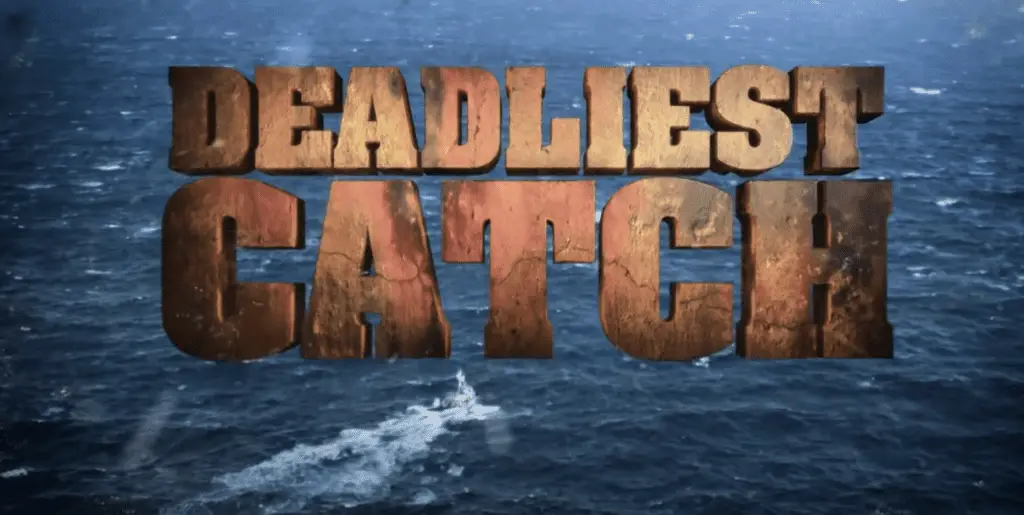
Who is the Richest Captain on Deadliest Catch?

Where is the Best Place to Put PFDs While You Are Out on Your Boat?
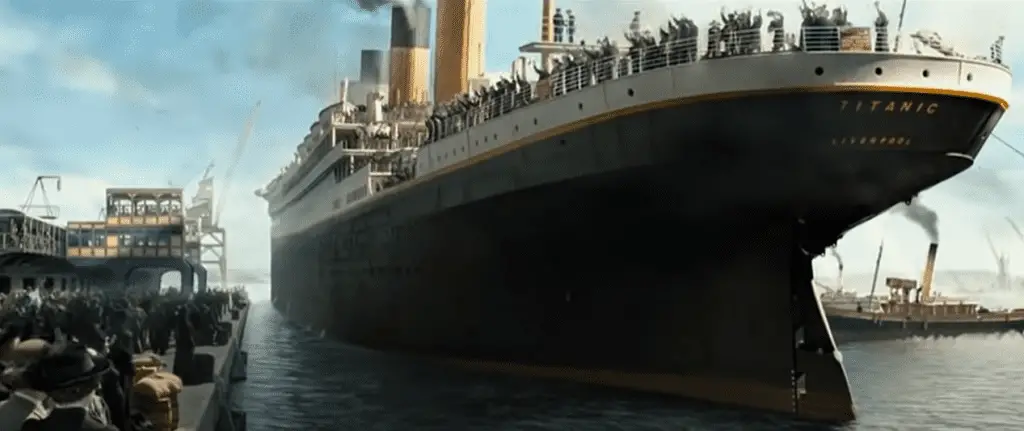
The 10 Best Sailing Movies of All Time

Barge Deckhand Salary: How Much Does a Barge Deckhand Make?

- BOAT OF THE YEAR
- Newsletters
- Sailboat Reviews
- Boating Safety
- Sailing Totem
- Charter Resources
- Destinations
- Galley Recipes
- Living Aboard
- Sails and Rigging
- Maintenance

Best Cruising Catamarans
- By Cruising World Editors
- Updated: July 1, 2021
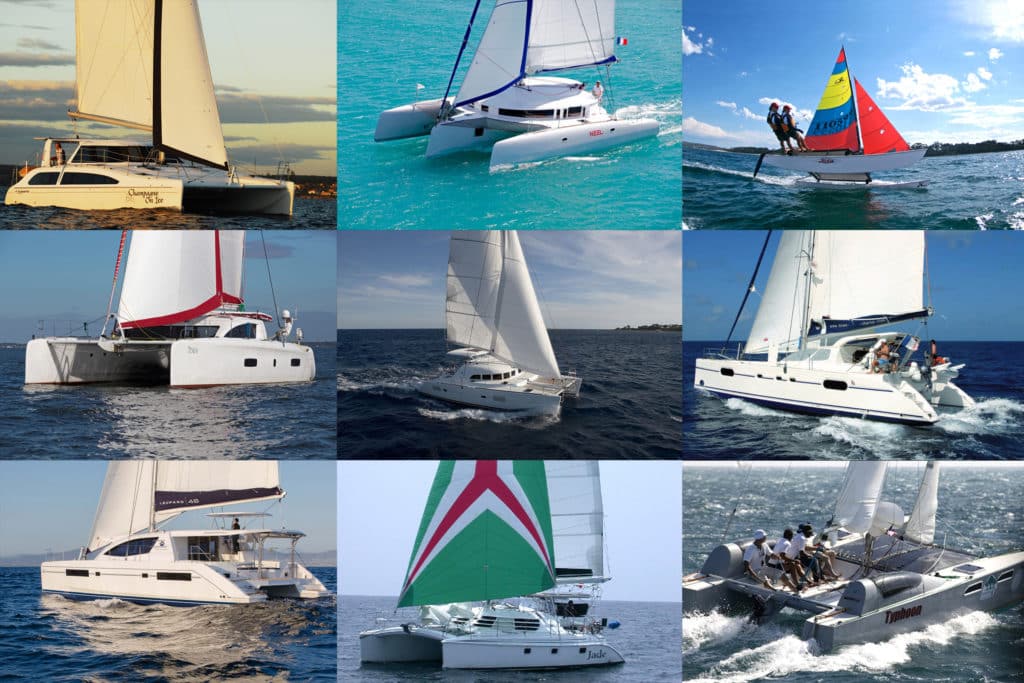
Cruising catamarans have been around for decades, but early models—often plywood and fiberglass vessels built by their owners from plans and kits, kept the boats on the fringes of mainstream sailing. That all changed, though, as big roomy cats were discovered by sailors who went off to charter in the Caribbean, where the multihulls proved their worth as comfortable liveaboard and party boats.
Today’s bluewater catamarans roam the globe, carrying families to exotic destinations across the Pacific and beyond. Just as with their monohull cousins, there is no best catamaran. Instead there is a wide variety of designs, ranging from small catamarans that offer the ease of maintenance a couple might enjoy to performance catamarans capable of easily knocking off 250-mile days. Today, the best catamaran brands offer a range of size models and layouts that can be optimized for an owner sailing with family and friends, or for the charter market, where there’s a demand for four, five and even six cabins worth of accommodations.
The most prolific catamaran manufacturers are in France and South Africa where yards include both large-run production builders and niche companies building fewer than 10 boats a year.
The best cruising catamarans offer good load-carrying ability and respectable performance. As with any sailboat , a modern catamaran’s design is a result of compromises. Daggerboards or keels? Galley up or galley down? Spacious owner’s cabin or extra bunks? There are lots of options to choose from—and that’s what makes looking at these sailboats fun!
Here, then is an eclectic A to Z list of some of the best catamarans that have helped shaped the evolution of how we live and sail on two hulls.
Antares 44i
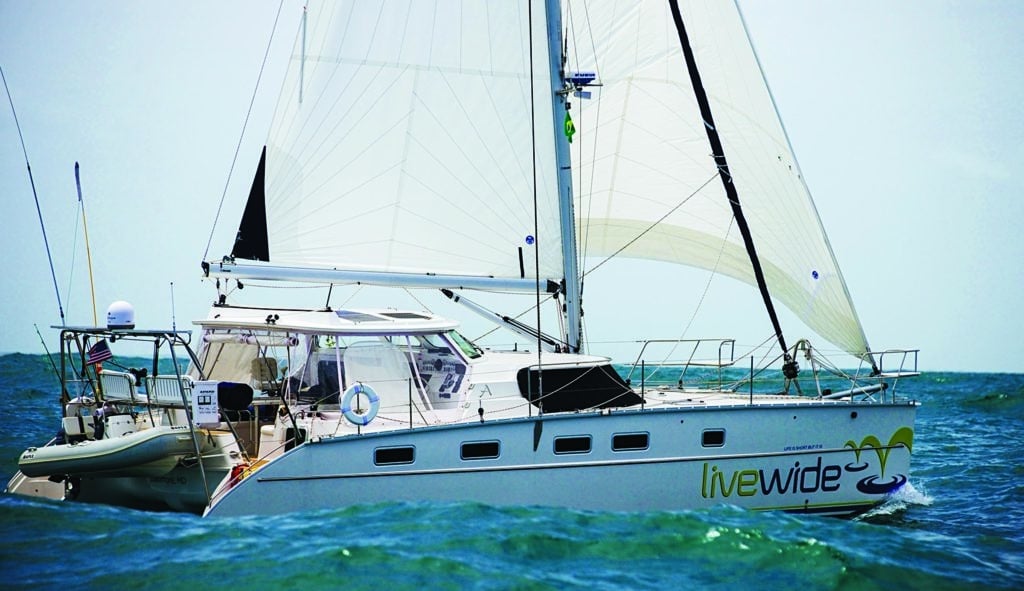
Now built in Argentina as a full-fledged, bluewater catamaran and cruiser that can be safely operated by a shorthanded couple or family crew, the Antares 44i features a fully covered cockpit with a quartet of big, standard solar panels recessed within the hardtop, one example of a yacht capable of long-range passagemaking.
Atlantic 42
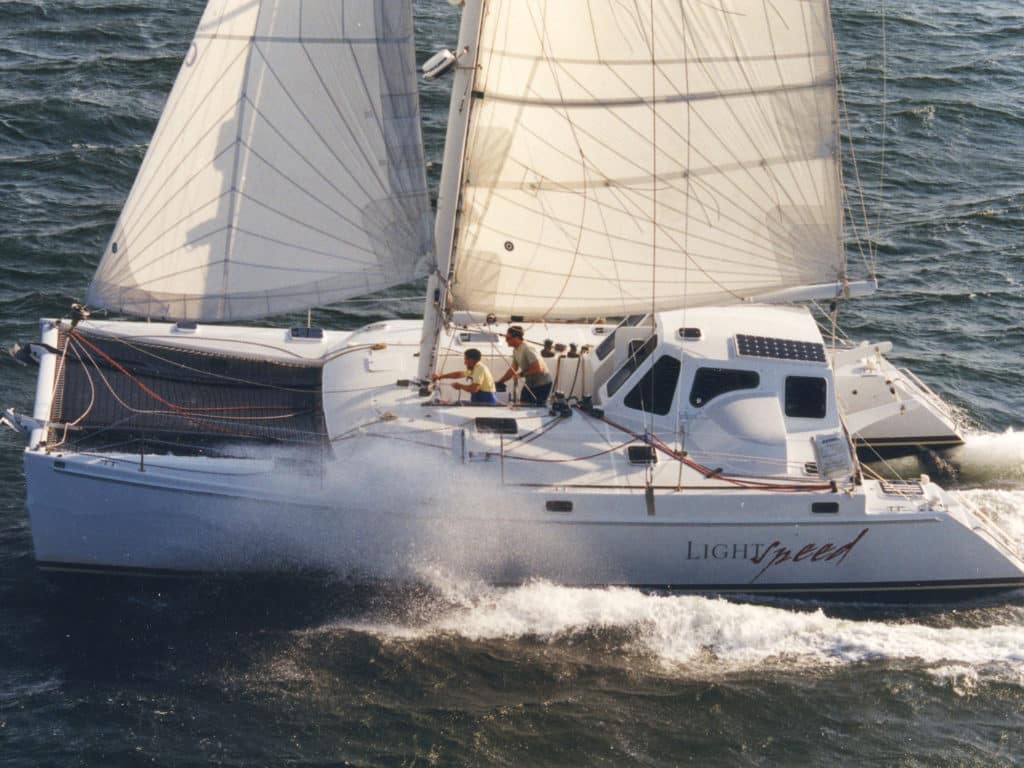
Almost 30 years ago, yacht designer Chris White revolutionized catamaran design with the first in his series of Atlantic cats, the primary feature of which was the innovative mid-ship sailing cockpit forward of the main cabin. The smallest in the Atlantic line, the 42 remains White’s most popular design ever.
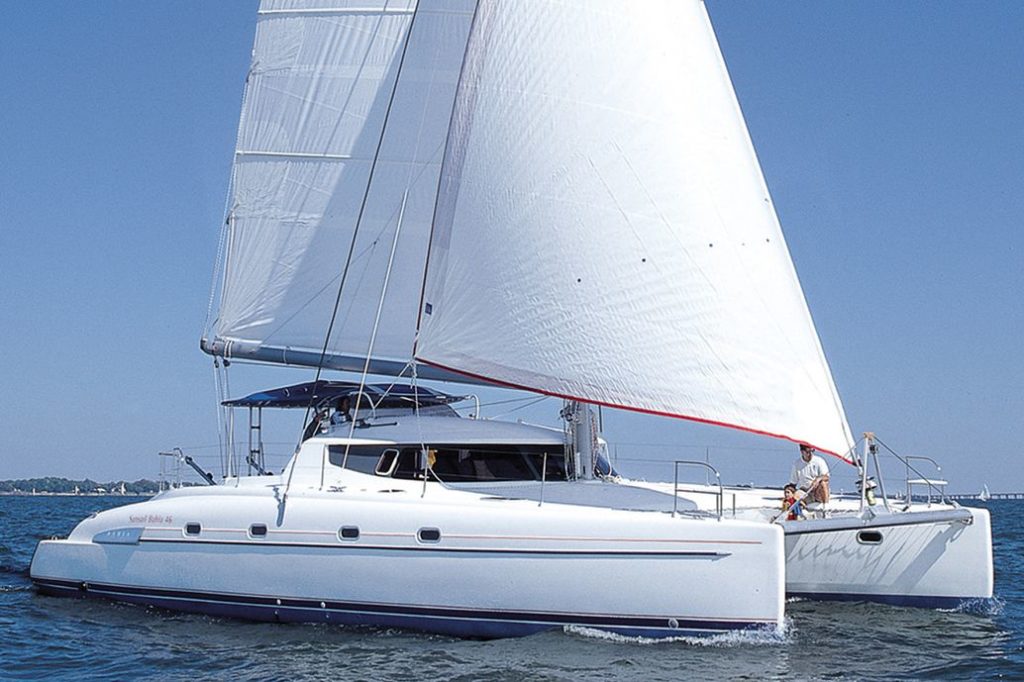
Fountaine-Pajot has built so many outstanding cruising catamarans that it’s difficult to narrow down any single boat, but we’ve always been fans of the good-looking, well-thought-out Bahia 46. At 46 feet, the boat is large enough for offshore forays and has plenty of volume; with its simple but powerful sail plan, it’s also an excellent performer.
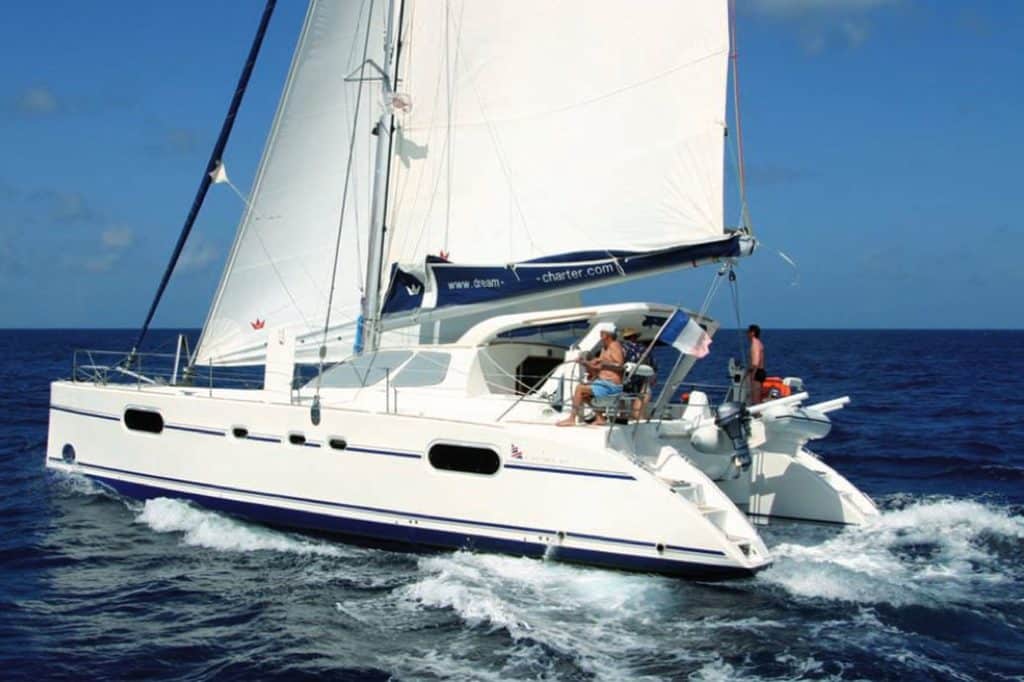
Beginning around 1996, the French builder Catana was one of the first companies to manufacture fully found cruising cats for private ownership, and this Christophe Barreau design, which enjoyed a nearly 10-year production run from 1997-2006, was emblematic of this first generation of safe, fun, long-legged offshore voyagers.
Click here to see more cats from Catana.
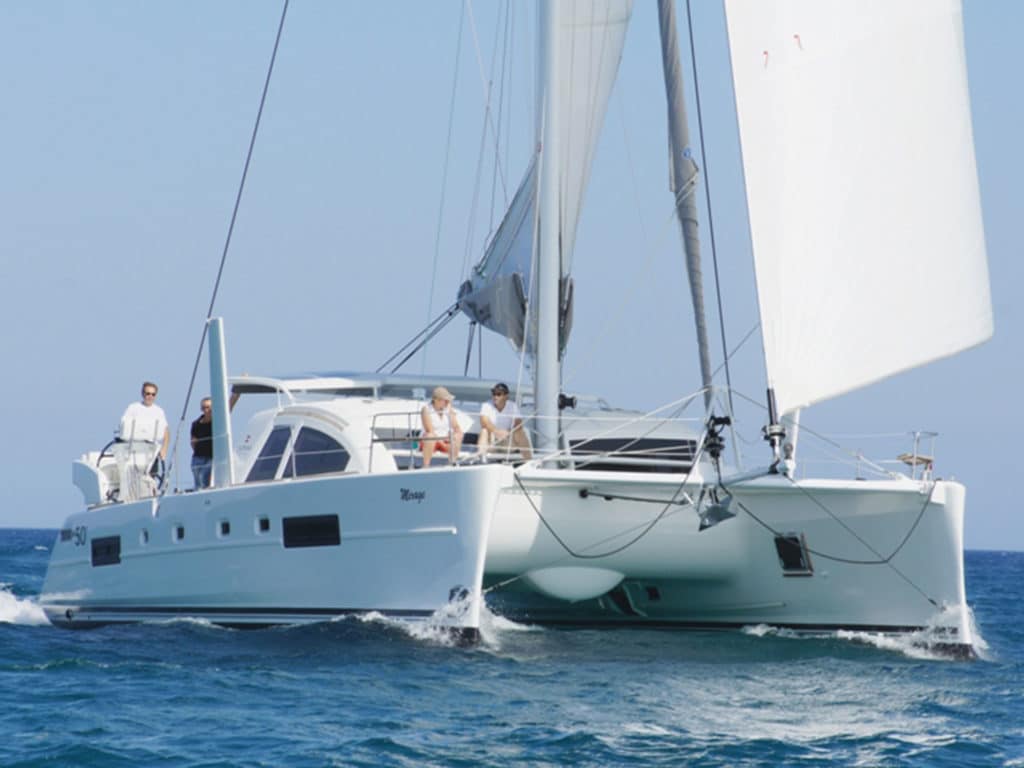
When it comes to speed, light boats are fast ones. And if you wish to save weight, that means exotic modern materials like carbon. Catana now infuses the laminates of their entire production line with carbon fiber, and for this list, we’ve chosen the Catana 50 Carbon, one of the zippiest cats now crossing oceans.
Click here to read about a couple’s charter aboard a Catana 50.
Gemini 105M
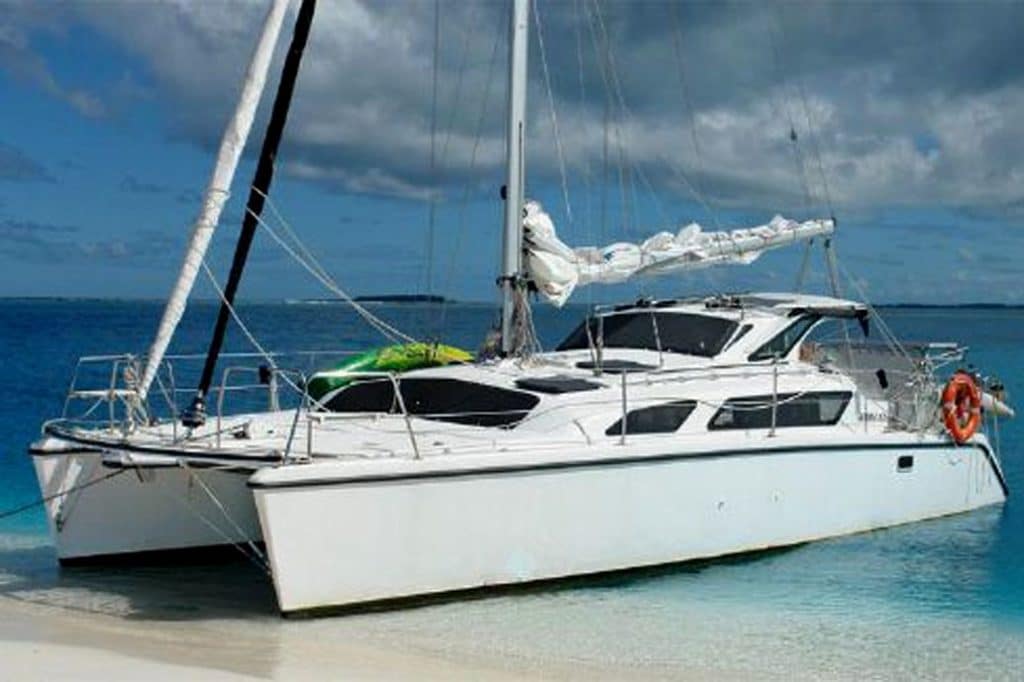
Pioneering catamaran sailor, builder and designer Tony Smith launched the first of his 33-foot Gemini 105M’s (10.5 meters = 33′) in 1993, and soon after found a ready and willing stream of sailors enamored of the boat’s compact size, affordable price tag, and such innovations as the nifty lifting rudder and transom steps.
Click here to read about the Gemini Legacy 35.
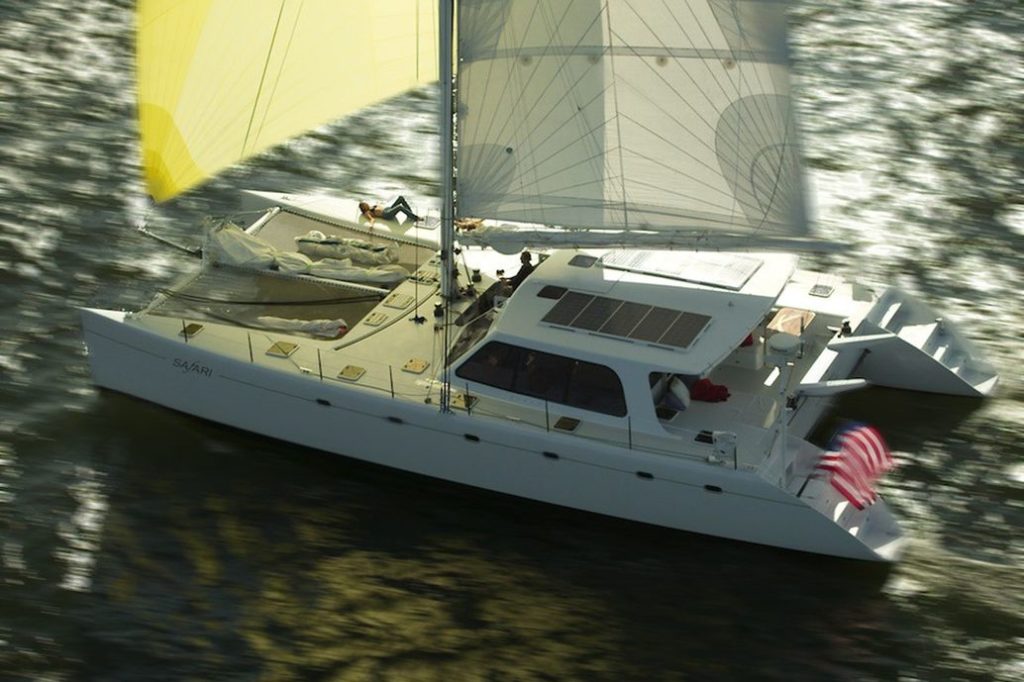
Built between 2000-2005, the Gunboat 62 firmly established the Gunboat brand: go-anywhere cats that applied race-boat technology to a world-cruising platform. Hull no. 1, Tribe, was built for company founder Peter Johnstone, who then spent a year-and-a-half cruising with his family, smiling all the way.
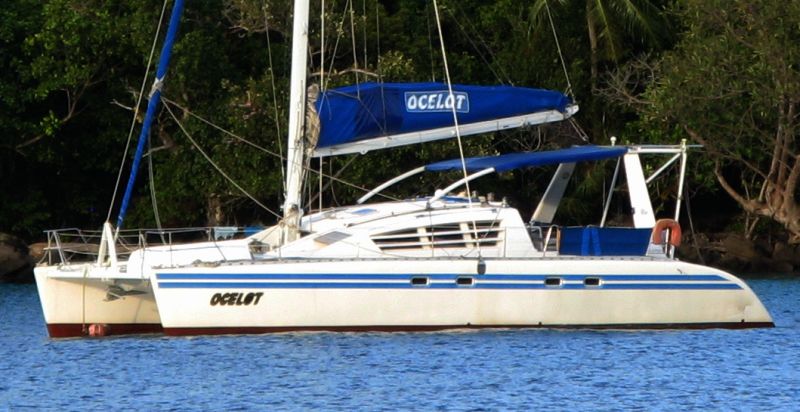
French builder Henri Wauquiez is best known for his long career building monohulls, but the Kronos 45 cat, which he launched in 1992, was ahead of her time. Classic lines, the aft “targa bar” over the cockpit, the louvered coach roof windows, even the distinctive stripes on her hull: the Kronos 45 remains timeless.
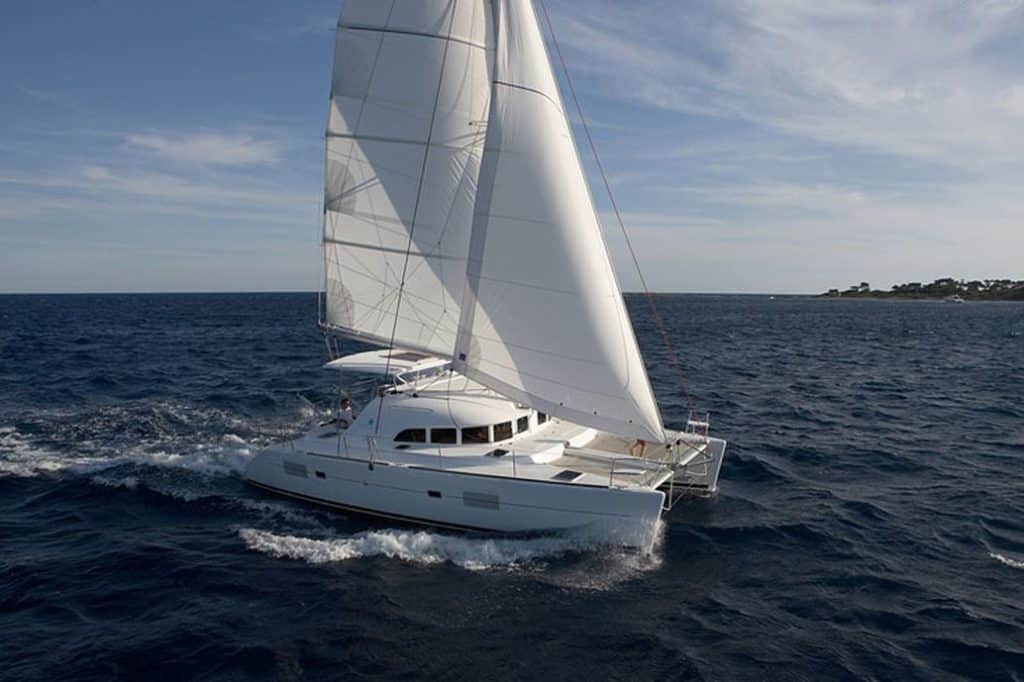
No roundup of cruising cats would be complete without several Lagoon entries, and the best of that impressive bunch might well be the Lagoon 380. Originally launched in 1999, and revered for its combination of quality, volume and performance, with over 740 boats built the 380 is still going strong.
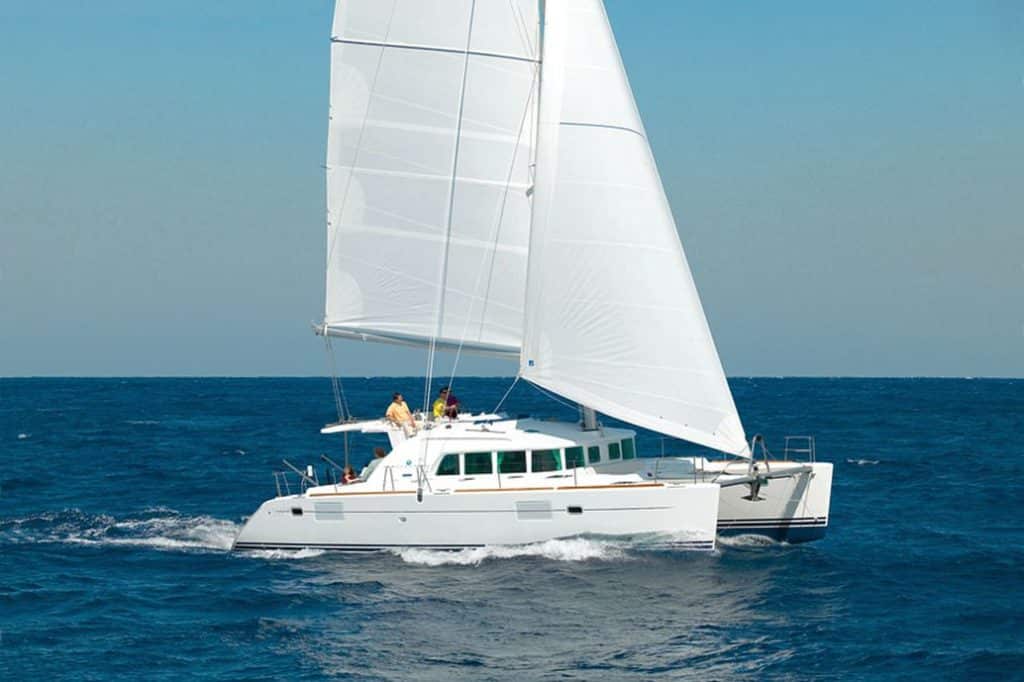
Launched five years after the breakthrough 380, the Lagoon 440 was an evolutionary design that featured a raised flybridge helm station, a unique “gullwing” configuration below the bridge deck, expanded windows in the hull and much more. With 400 boats built in a 6-year production run, the 440 was an unqualified success.
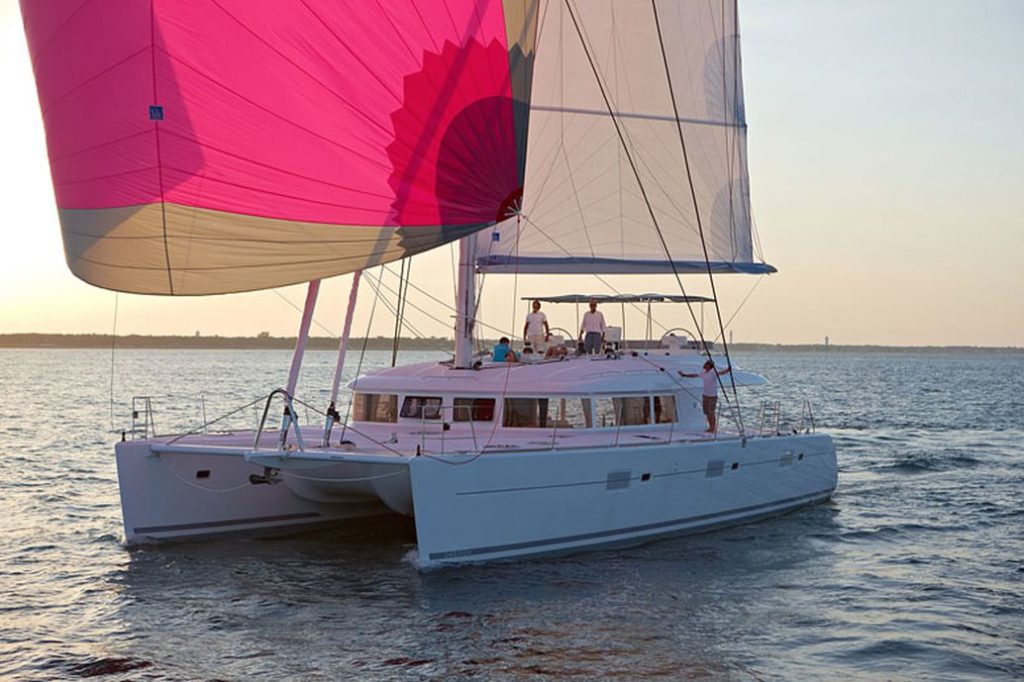
How big can a production cat, still operable by a short-handed crew, really be? The builders at Lagoon discovered that 62-feet hit a sweet spot in the marketplace, and have sold over 70 boats since its introduction in 2010. The centerpiece of this design is the sensational steering station atop the flybridge, with expansive views of the sea and sky.
Click here to see more cats from Lagoon.
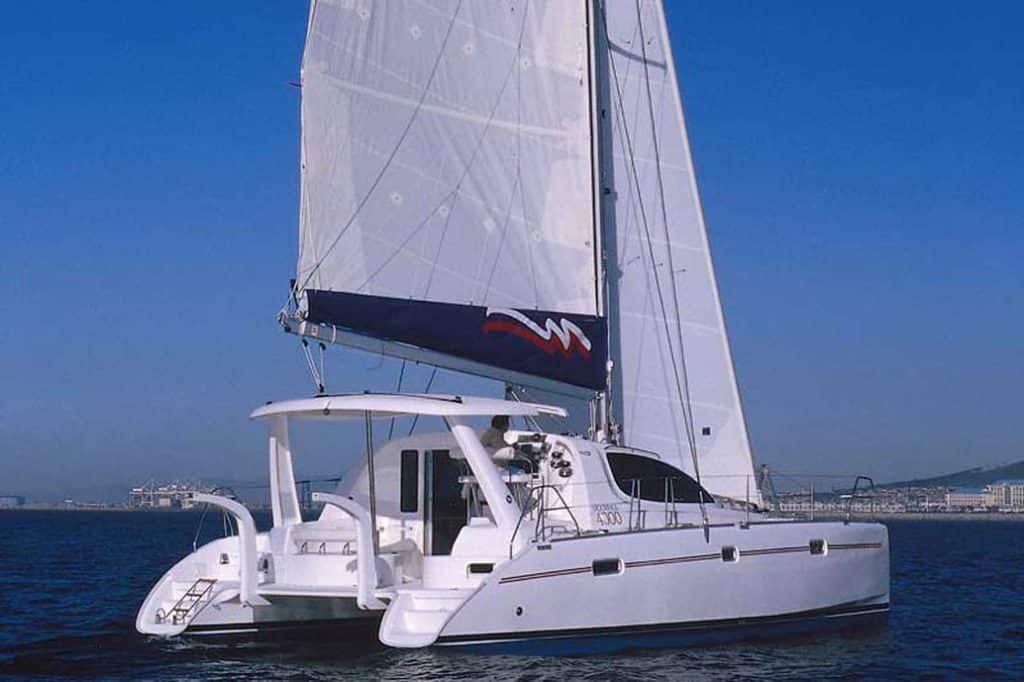
With an unmatched pedigree – designed by premier multihull naval architects Gino Morelli and Pete Melvin, built by the prestigious Robertson & Caine boatyard in South Africa, and commissioned by chartering giant The Moorings – the Leopard 40 was, perhaps unsurprisingly, Cruising World ’s Import Boat of the Year in 2005.
Louisiane 37
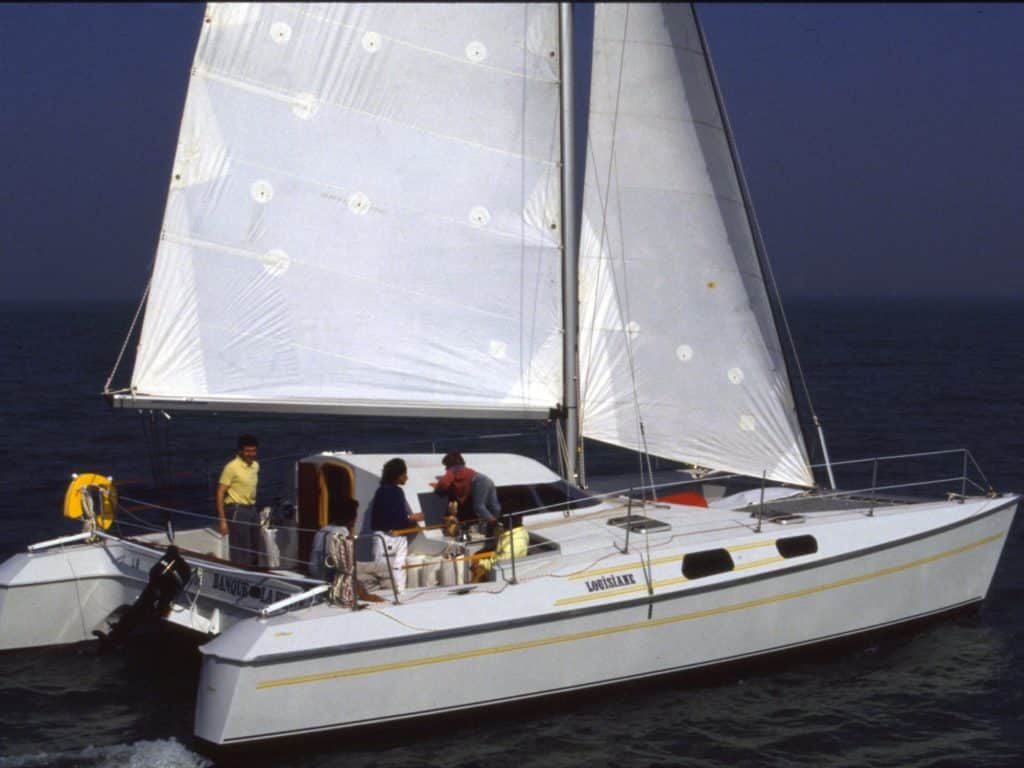
Based on the famous French racing cat Charente-Maritime, the Louisiane 37, designed by Joubert/Nivelt and launched by builder Fountaine-Pajot in 1983, was a light, fast liveaboard cruiser with full accommodations that represented a radical departure from the hefty British cats that preceded it.
Maine Cat 30
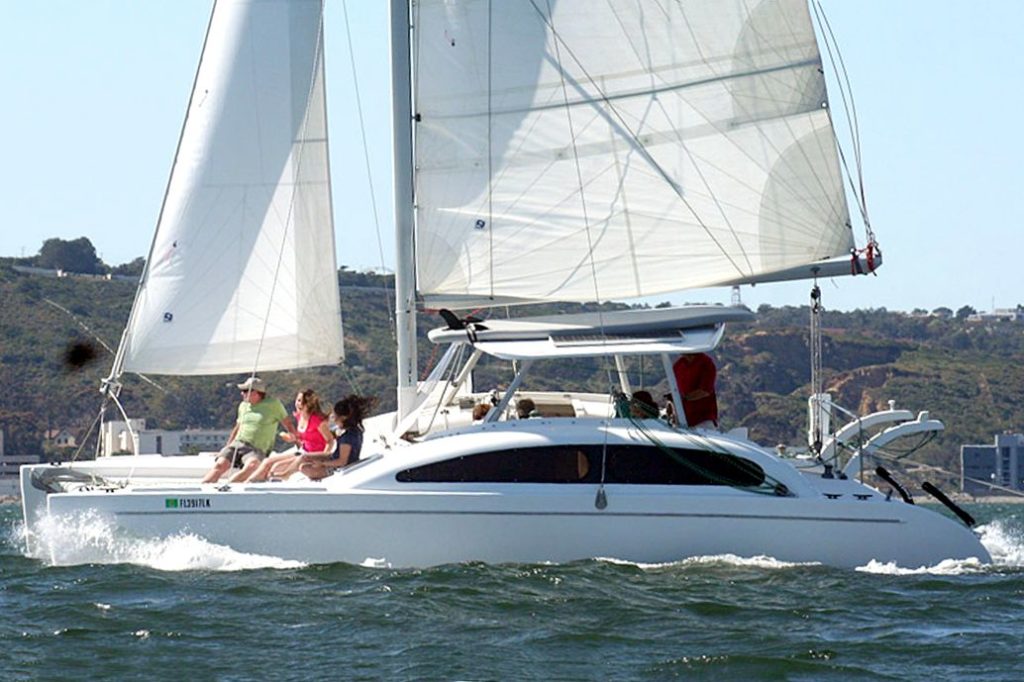
One of the more versatile and clever cats ever created, the central feature of the cool Maine Cat 30 is the open bridge deck/living room sandwiched between the hulls and canopied by a rigid, permanent hard top (the comfortable accommodations/ staterooms are stationed in the hulls). Ideal for a winter in the Bahamas but with the ability to sail offshore, it’s a boat for all seasons and reasons.
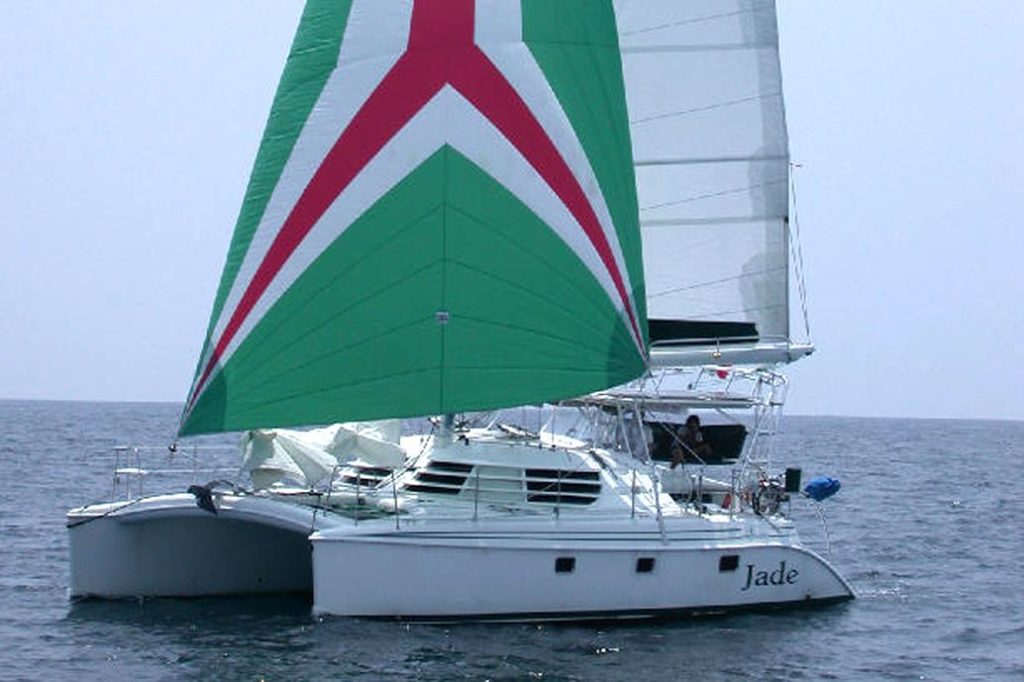
Built in Florida and beloved by the owners of the over 120 boats built during the company’s existence from 1993 to 2009, the Manta Catamarans range included 38-, 40- and 44-foot cats. For this exercise, however, we’re heralding the original Manta 42, which won the Best Value Overall prize in CW’s 2001 Boat of the Year contest.
Moorings 4800/Leopard 48
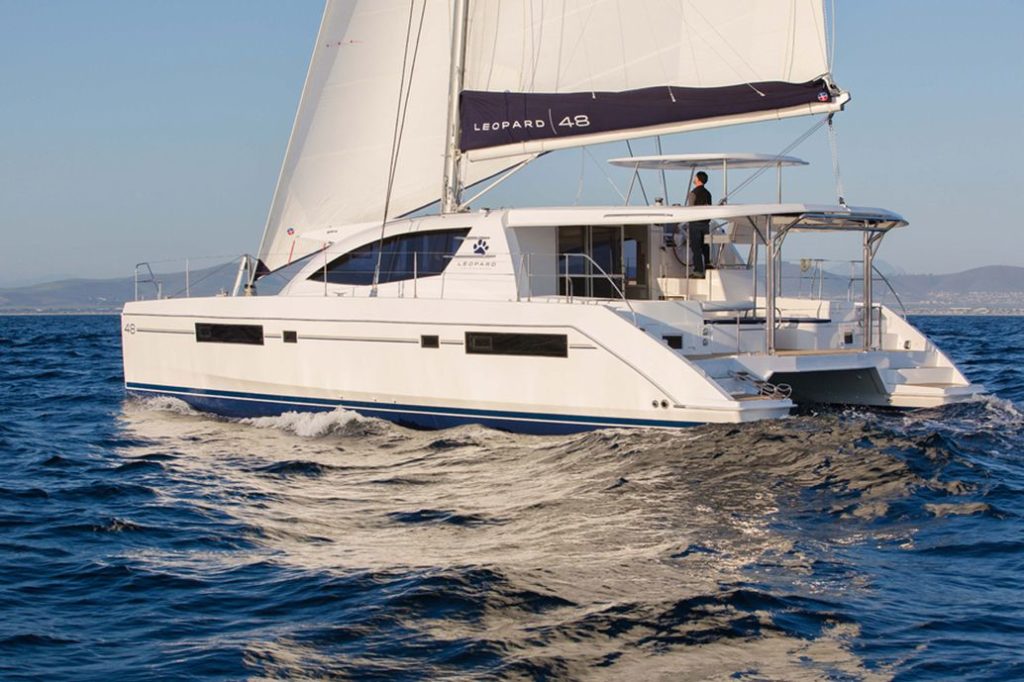
Another Leopard/Moorings collaboration built by the wizards at Robertson & Caine (though this boat was designed by fellow South African Alex Simonis), the Leopard 48 was another CW Boat of the Year winner with all the contemporary bells and whistles: forward cockpit, flybridge helm station and solid hardtop dodger, just to name a few.
Click here to read more about the Leopard 48, and click here to see more images.
Nautitech 441
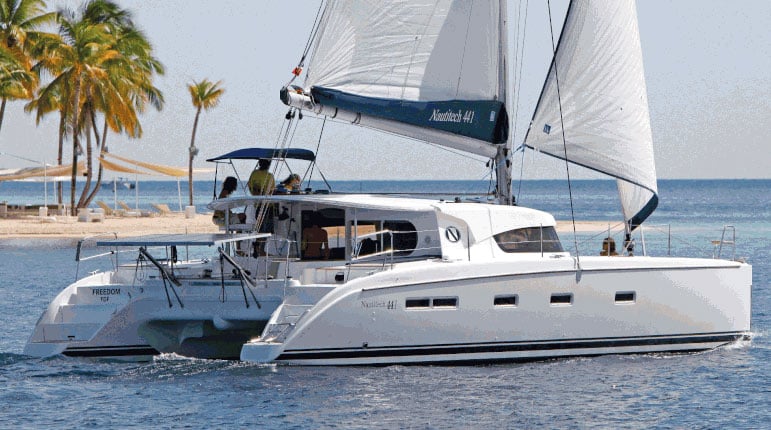
The Best Multihull Under 45 Feet: So said the CW judging panel in the 2013 Boat of the Year competition, regarding the Nautitech 441. But what makes this versatile platform so intriguing are the different helm set-ups. The 441 employs a single wheel, to starboard, ideal for solo sailors, while the 442 has a pair of helm stations aft.
Click here to see more Nautitech Catamarans.
Outremer 5X
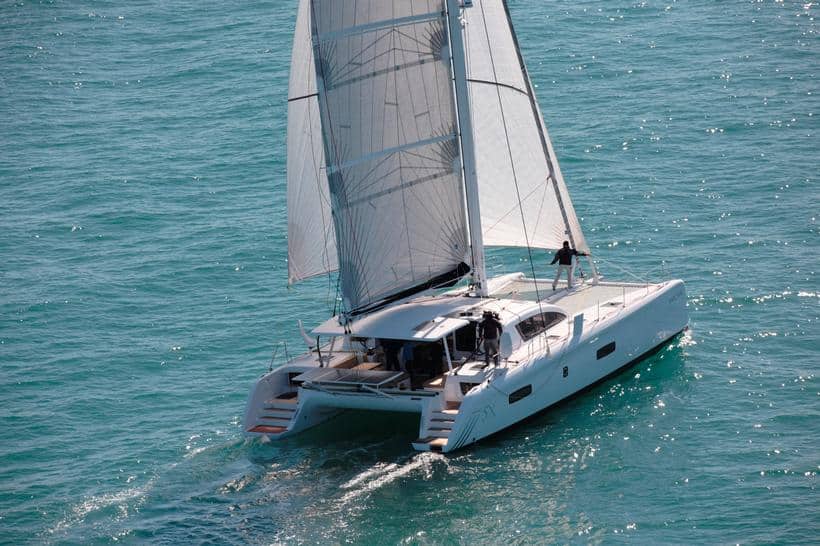
A state-of-the-art all-oceans cat that exemplifies how far multihull design has come, the 59-foot Outremer 5X was a winner on both sides of the Atlantic, taking top honors in the European Boat of the Year competition in 2013, and following up as the Best Full-Size Multihull in CW ’s contest a year later.
Click here to see more cats from Outremer.
St. Francis 50
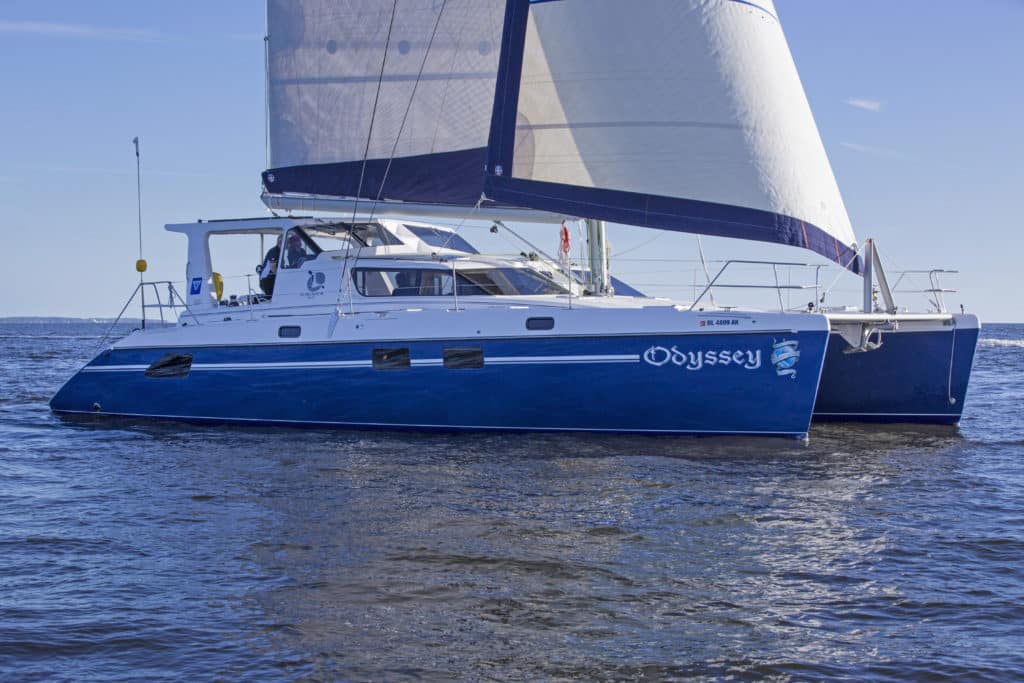
The flagship of the proud St. Francis line – built in South Africa since 1990 to designs by local legends Lavranos Marine Design – the St. Francis 50 is another “luxury cat” that shares much in common with an earlier 48-foot sister-ship, but packs even more payload into its roomier lines.
Click here to read more about the St. Francis 50
Seawind 1000
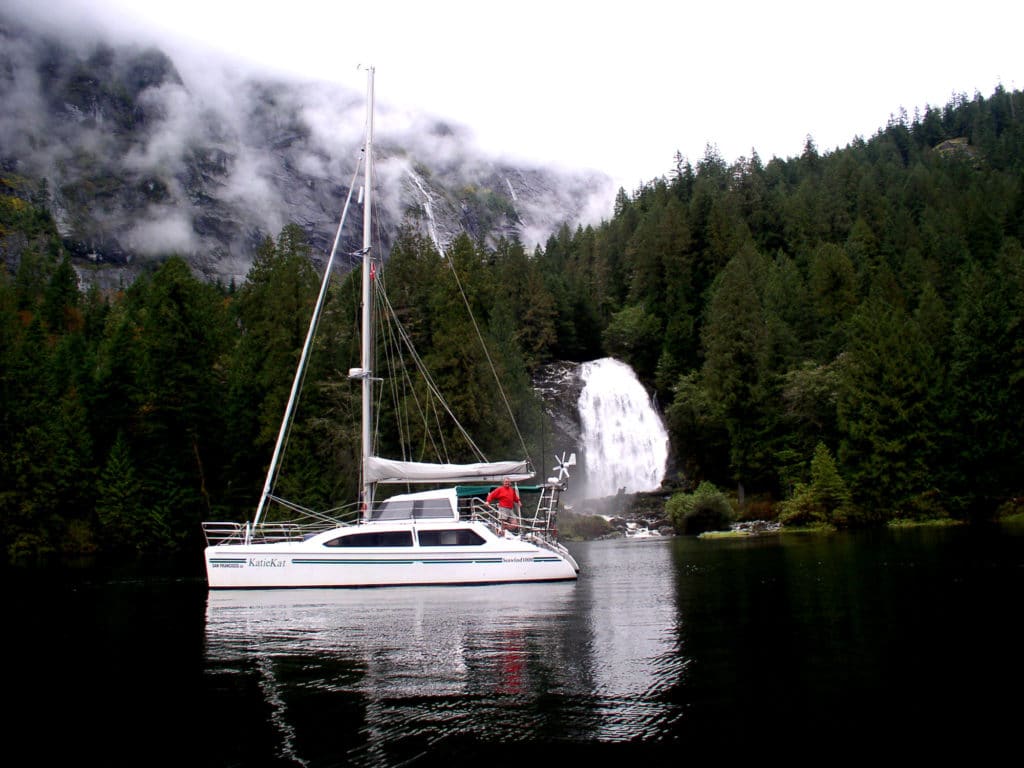
Founded by Aussie surfer and sailor Richard Ward in 1982, the 33-foot Seawind 1000 is easily the most popular cruising cat ever built in Australia (the company has since moved its manufacturing and management operations to Vietnam). Roomy and airy, these cats dot the coastline of eastern Oz.
Seawind 1160
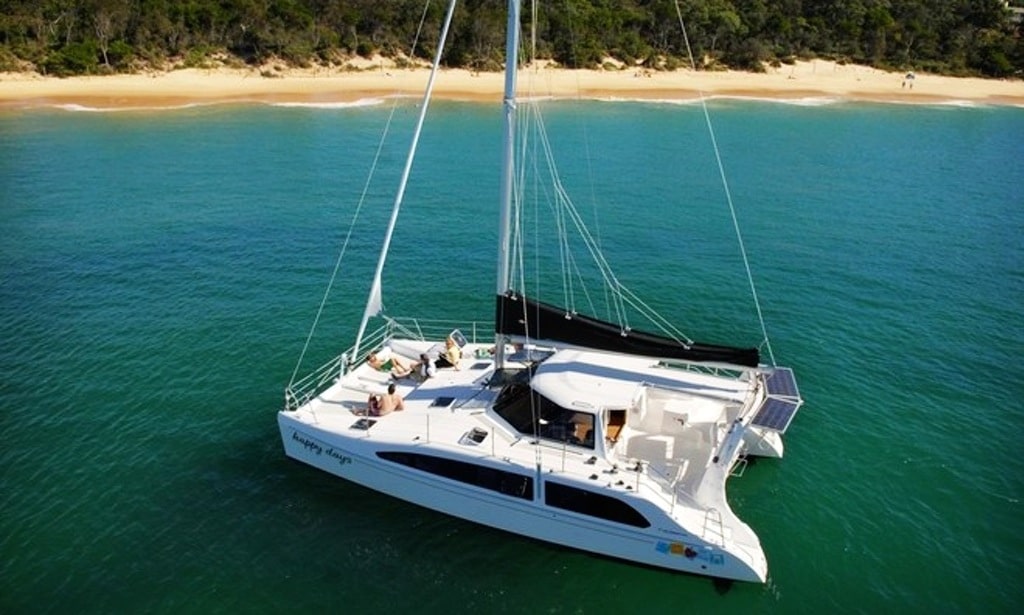
If the Seawind 1000 was a minimalist approach to cruising cats, the 38-foot Seawind 1160 is the flip side of the coin, a full-fledged long-range voyager. Among the reasons it was named CW ’s Most Innovative boat for 2007 is the unique “tri-folding” door that stashes overhead to open up the saloon and cockpit into a spacious living area.
Click here to read more about the Seawind 1160.
Sunsail 384
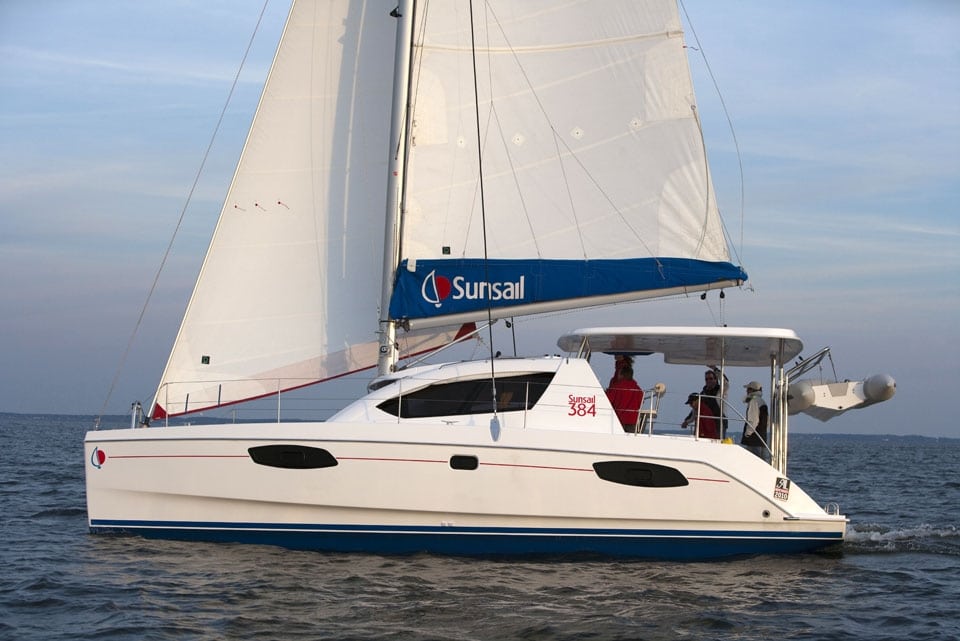
Every sailboat is a compromise, and in the case of the Sunsail 384 (also sold privately as the Leopard 38) that’s a good thing, because designers Morrelli & Melvin and builder Robertson and Caine got the balance just right with this relatively small catamaran. With four cabins, the 384 can carry the same size bareboat charter crowd as her larger siblings, but does so with a decided bounce in her step. Named CW’s Import Boat of the Year in 2010, you can gauge the success of the design by the grins on the crew as they barrel down Sir Francis Drake channel in the British Virgin Islands.
Victoria 67
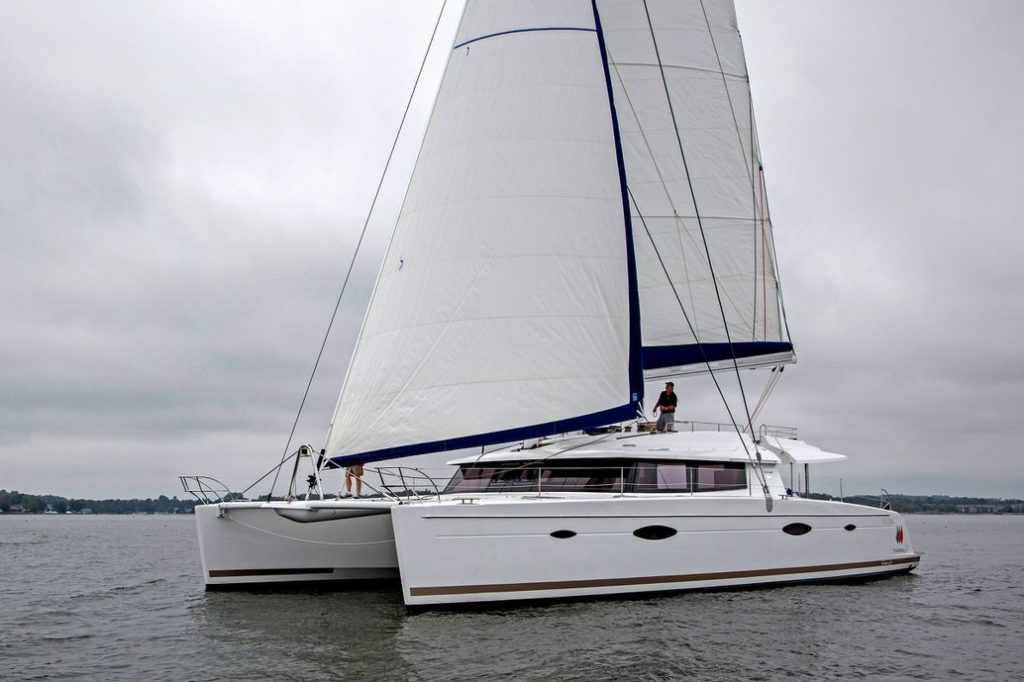
The French design office of Berret Racoupeau drafted the lines of Fountaine-Pajot’s new flagship, introduced in 2013, a magnificent world-girdling voyaging catamaran. Like other giant cats launched in recent years, the boat features a sensational upper deck with all sail controls, helm and lounging stations.
Click here to see more images of the Victoria 67.
Wharram Tanaroa
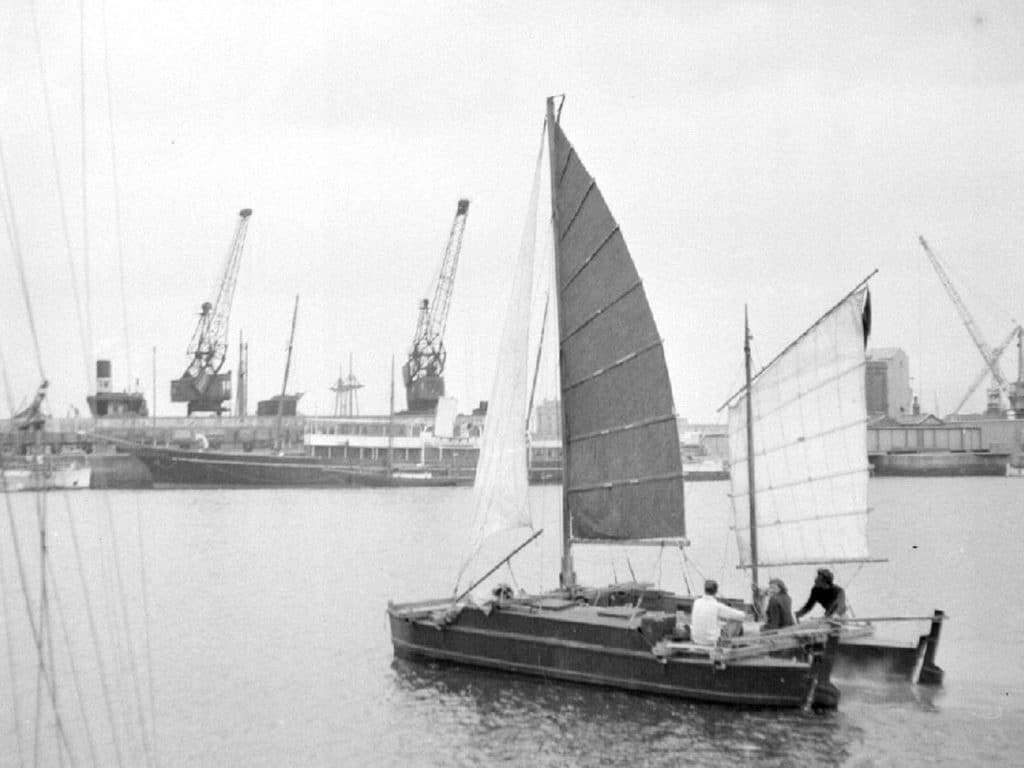
No list of influential multihulls would be complete without the work of James Wharram, and while Tangaroa wasn’t a production cat by any means, it showcases the British designer’s respect for ancient Polynesian craft. Wharram sailed this 23-foot-6-inch “double-hulled canoe” across the Atlantic in the 1950s, and sold countless plans for similar boats for decades afterwards.
- More: Boat Gallery , catamaran , multihull , Sailboat Reviews , Sailboats
- More Sailboats
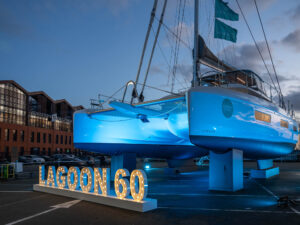
Lagoon 60 Prepares for World Premiere
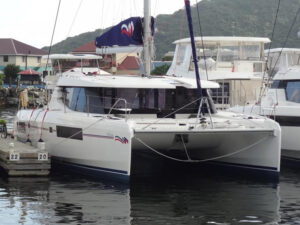
Now For Sale: Leopard 45
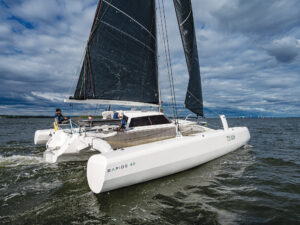
Sailboat Review: Rapido 40
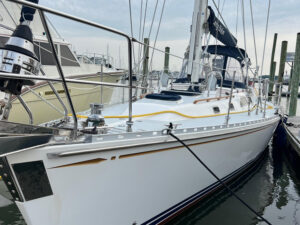
For Sale: 2002 Hylas 46
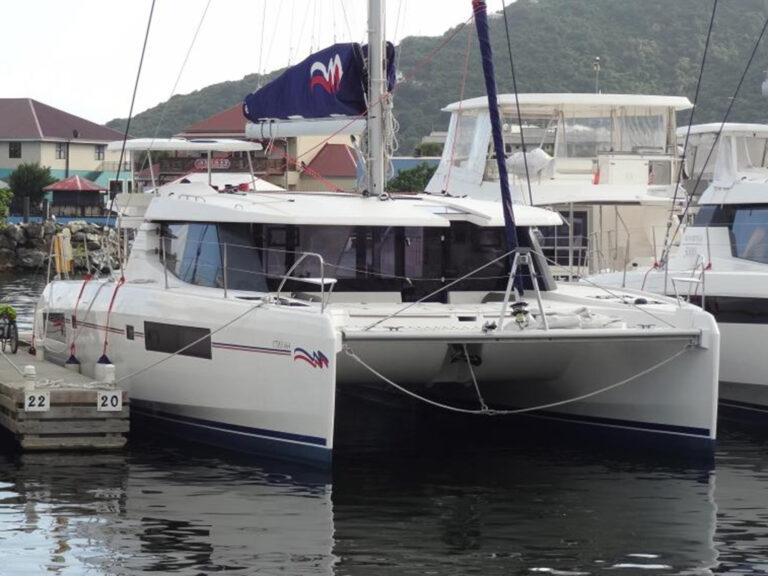
The Long Way Around

Sailing to the Land of Shrimp
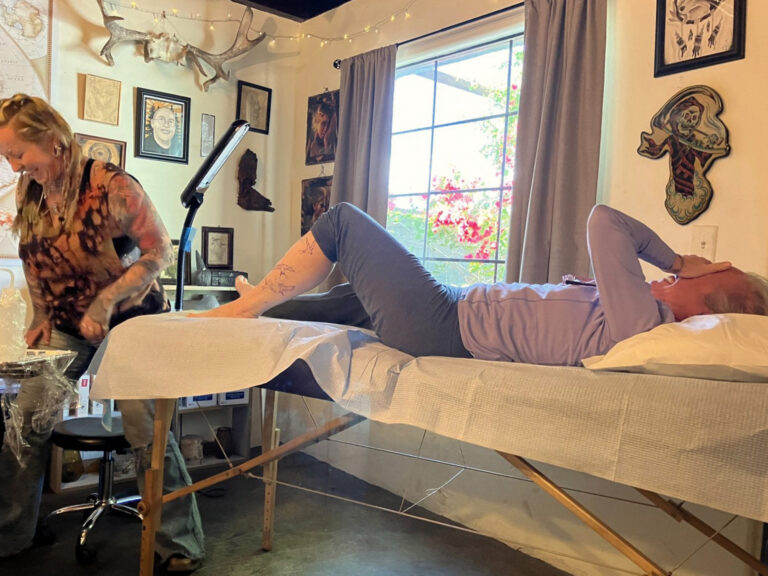
Swallow Tattoos and Sailors
- Digital Edition
- Customer Service
- Privacy Policy
- Email Newsletters
- Cruising World
- Sailing World
- Salt Water Sportsman
- Sport Fishing
- Wakeboarding

Best Liveaboard Bluewater Catamarans

Last Updated by
Daniel Wade
August 30, 2022
Catamarans are known for seaworthiness, but what sets a run-of-the-mill recreational cat from a full-blown liveaboard blue water cruiser?
The best production blue water cruising catamarans are the Manta 42, the Lagoon 42, the Leopard 45, the Lagoon 450, and the Prout 45. These vessels have excellent living accommodations and great sea keeping abilities.
In this article, we’ll cover five of the best liveaboard cruising catamarans, along with what sets them apart from similar vessels. Additionally, we’ll go over what to look for in a catamaran that functions both as a home and an offshore adventure cruiser.
We sourced the specifications listed in this article directly from boat design guides and the manufacturers themselves.
Table of contents
Characteristics of Liveaboard Cruising Catamarans
Generally speaking, blue water catamarans that are suitable for offshore cruising and living aboard are between 40 and 50 feet in length. Some well-designed catamarans between 25 and 39 feet in length can also be used.
A good liveaboard cruising catamaran should have adequate berthing and galley facilities, along with an enclosed cockpit. Catamarans without enclosed cockpits, especially smaller vessels, aren’t spacious enough in the hull to accommodate good liveaboard facilities.
As far as cruising is concerned, the best Bluewater catamarans are designed for durability and seaworthiness. A vessel’s sea keeping abilities rely on more than just smoothness and speed. These vessels should be water-tight in key locations, positively buoyant, and equipped with all the right extras.
Factors that Increase Catamaran Seaworthiness
There are several additions that manufacturers commonly include with sea-going blue water catamarans. These include water-tight hatches, radar units, a backup generator, and a berth close to the cockpit.
The latter is particularly important, as the captain and crew need to be able to grab the controls in the event of a nighttime emergency.
Other add-ons, such as automatic winches and controls, are extremely beneficial to blue water catamarans. These devices allow the sails to be controlled remotely without the crew needing to walk on deck.
Cruising Catamaran vs. Bluewater Catamaran
Fundamentally, cruising catamarans and ‘blue water’ catamarans are one and the same. When companies classify a catamaran as a ‘cruising’ catamaran, they usually do so because of a few notable design features.
These include cruising accommodations such as large-capacity water tanks, large fuel tanks, onboard power supplies (like a generator and a battery bank; sometimes solar panels), and long-distance communication systems. Radar is another perk, and it’s available on most cruising catamarans.
Best sea-going Liveaboard Catamarans
We searched the market, researched specifications, and listened to the owner’s opinions to find the best sea-going catamarans on the market.
These vessels are also spacious and comfortable enough to live aboard, both at sea on extended voyages and in a marina. Here are our top picks.
1. Manta 42
The Manta 42 is a well-known and popular cruising catamaran with a reputation for seaworthiness and exceptional comfort for its size. This vessel, while on the smaller end for cruising catamarans, is quite seaworthy and handles well in all conditions.
The Manta 42 is powerful—it has a large sail area for its size, which gives it incredible speed in both low and high wind conditions.
The Manta 42 has an unconventional design feature that makes it stronger than the competition—and technically, more seaworthy than many larger and fancier catamarans. The feature we’re referring to is the Manta 42’s fixed crossbeam, which is stronger than typical designs.
The Manta 42’s interior is really well-designed and ideal for living aboard. The hulls feature large berthing areas, and the center cockpit area features a full-size marine galley and sitting areas. This vessel is popular with families, as there’s plenty of room for parents and one or two kids.
2. Lagoon 42
Here’s another 42-foot cruising catamaran with exceptional seaworthiness, shallow draft, and spacious accommodations. The Lagoon 42 is a modern and advanced sailing catamaran with numerous cruising features, such as a self-tacking jib and a flybridge.
This model has extensive sleeping capacity. Standard versions can sleep up to 12 adults, which is much more than many catamarans in the 40 to 45-foot range. The vessel also features four separate heads, which ensures privacy for guests and family members.
This vessel is designed for comfort, and therefore it's a bit beefier than some slimmer and less spacious models. It’s a heavy boat with a 25-foot beam, and it has excellent sea keeping abilities.
The primary drawback of the design is that its size and hull shape limits speed. But this isn’t as big of an issue on long voyages, and it’s still much faster than an equivalently-sized monohull.
3. Leopard 45
This premium catamaran is a bit larger and more comfortable than the vessels we’ve discussed so far. It’s a luxury catamaran with everything you’d expect for the half-million-dollar price point.
This vessel shines on the open water where it can let out its sails and stretch its legs. The vessel is lightning fast in the right conditions, and it has an astounding 700-gallon fuel capacity for when the wind isn’t blowing. You can sail it, motor it along, or do both at the same time for even greater speed.
From the factory, the Leopard 45 sleeps around 12 adults at its maximum capacity or four couples in separate staterooms—each with its own bathroom and shower. The center cockpit is also quite spacious, and the vessel can be navigated from the flybridge above the central living area.
4. Lagoon 450
Here’s another 45-foot catamaran that comes from one of the world’s most respected catamaran builders. Lagoon, which is currently producing several catamaran models, is known for its high-quality material choice and construction.
The Lagoon 450 is a flybridge sailing catamaran. Its design is based on the best-selling Lagoon 440—a slightly smaller model that proved itself over years of use and countless miles sailed between owners. And though it’s only 45 feet long, this catamaran is massive both inside and out.
The vessel is fast and nimble, and it has excellent sea keeping qualities. Below decks, the surprisingly wide hulls have room for full-size staterooms both fore and aft. But what the Lagoon 450 is known for is its deck space. There’s a ton of room on the decks for hanging out, living activities, and entertaining guests.
The center cockpit of the Lagoon 450 is like something out of a luxury condo. The styling is impetuous and airy, and there’s more than enough room to prepare a full meal for ten people or more. The settee can double as a sea cabin, with more than enough room for a small crew.
5. Prout 45
Here’s a sleek and fast catamaran that’s a superior choice for cruising and living aboard. The Prout 45 debuted in the 1990s and was a huge success.
Impressively, over 2,000 individual Prout 45 cruising cats were eventually produced. That’s a lot for a production catamaran—especially a large 45-foot model with a hefty price tag.
This sea-going catamaran has unconventional features, including pointed monohull-like bows and a nearly flush cockpit.
The interior arrangement of the vessel is unconventional as well, but many owners eventually learn to prefer it. For example, oddities include a galley in one of the hulls instead of the center, where catamarans often keep such facilities.
This is a fast cruising catamaran with a very shallow draft. Three feet six inches of draft, to be precise.
This means that the Prout 45 is ideal for sailing in shallow locations, such as around tropical coral reefs and in areas known for sandbars. The draft of this vessel is much closer in depth to that of a 20 to 25-foot displacement monohull than to a full-size 45-foot catamaran.
Related Articles
I've personally had thousands of questions about sailing and sailboats over the years. As I learn and experience sailing, and the community, I share the answers that work and make sense to me, here on Life of Sailing.
by this author
Best Sailboats
Most Recent

What Does "Sailing By The Lee" Mean?
October 3, 2023

The Best Sailing Schools And Programs: Reviews & Ratings
September 26, 2023
Important Legal Info
Lifeofsailing.com is a participant in the Amazon Services LLC Associates Program, an affiliate advertising program designed to provide a means for sites to earn advertising fees by advertising and linking to Amazon. This site also participates in other affiliate programs and is compensated for referring traffic and business to these companies.
Similar Posts

Affordable Sailboats You Can Build at Home
September 13, 2023

Best Small Sailboats With Standing Headroom
December 28, 2023

Best Bluewater Sailboats Under $50K
Popular posts.

Best Liveaboard Catamaran Sailboats

Can a Novice Sail Around the World?
Elizabeth O'Malley
June 15, 2022

4 Best Electric Outboard Motors

How Long Did It Take The Vikings To Sail To England?

10 Best Sailboat Brands (And Why)
December 20, 2023

7 Best Places To Liveaboard A Sailboat
Get the best sailing content.
Top Rated Posts
Lifeofsailing.com is a participant in the Amazon Services LLC Associates Program, an affiliate advertising program designed to provide a means for sites to earn advertising fees by advertising and linking to Amazon. This site also participates in other affiliate programs and is compensated for referring traffic and business to these companies. (866) 342-SAIL
© 2024 Life of Sailing Email: [email protected] Address: 11816 Inwood Rd #3024 Dallas, TX 75244 Disclaimer Privacy Policy
Yachting World
- Digital Edition

Turbo multihulls: a new generation of performance cruiser
- Sam Fortescue
- May 12, 2022
A new breed of luxury fast multihulls are seducing wealthy sailors with a need for speed, Sam Fortescue reports on the rise and rise of this latest breed

“People sail for fun, and no one has yet convinced me that it’s more fun to go slow than it is to go fast,” said visionary multihull designer Dick Newick in the last century. “We all want high performance with comfort and low cost. Since the three cannot be combined in one vessel, priorities must be established and compromises made.”
Now, Newick may belong to another generation, but his observation is as true today as it has ever been. This time round, though, buyers have the money to park the cost issue. A new cohort of boatbuilders like Gunboat, HH and Kinetic are mining a rich (if narrow) seam of demand for high-end cats that go like rocketships and offer genuine comfort, if not outright luxury.
Gunboat is the trailblazer here. Launched in 2002, the now iconic brand weathered stormy waters before being taken over and moved to France by the Grand Large Yachting group (which also includes Outremer).
Its range has now stabilised at 68ft, 72ft and 80ft – much larger than it typically built in the past. But it has reached the size limit for this business model, according to managing partner Benoit Lebizay. “Beyond 80ft, you go into full custom,” he says.
HH Catamarans emerged 10 years later, building boats from 44ft to 88ft in Xiamen, China, with the same contractor that once used to build Gunboats. And Kinetic is more recent still, with construction in South Africa and design by the renowned Simonis Voogd.

Kinetic’s KC62 is built for speed, yet with ease and real comfort. Photo: Dale Staples
“When we started, we had to make a real threshold decision,” says Kinetic founder Bob Hayward. “Are we trying to make this a hull-flying lightship that’s a bit of a spartan cruiser, or are we really a fast performance cruiser that you race?”
Research among Gunboat skippers convinced him of the latter, because the market was commissioning boats with lots of bells and whistles. “Once you start putting the creature comforts on board, they come out heavier than the lightship aspiration,” he adds.
Kinetic has launched one 54-footer and a 62, with three more boats in the pipeline for delivery this year. “I definitely think this is a growing market, but not a mass market,” Hayward adds. “The more these boats get out there, and people see how accessible they can be, I think they’ll grow even further.” You only have to be overhauled once by a fast cat to understand the appeal.
Lebizay at Gunboat takes a similar view. “We remain niche players,” he says. “I’m not talking about building 20 boats per year – five or six is about as much as we can do. But the more we splash boats, the more we create momentum in the more experienced part of the fleet.”
Olivier Racoupeau has drawn more than his fair share of two-hulled boats over the years, but he says the market is changing. “We see a significant improvement in the number of requests for performance cats,” he tells me.

The Gunboat 68 is appealing and fast yet supremely comfortable. Photo: Michel Dupre
“In the past, they were looking for the volume and the lifestyle – more like performance cruisers. Now we see people coming to us to have much more fun sailing. They want to have daggerboards to improve the performance and are happy to keep the volume and the length of the hull reasonable.”
All about the kilos
Like every catamaran in this performance category, Gunboats are built in a high-quality carbon layup to maximise strength and stiffness while minimising weight. That means vacuum infusing prepreg materials for a precise and even distribution of the epoxy resin throughout the structure of the hull.

Looking into a little HH66 luxury. Photo: Billy Black
“We take technology from the racing end of sailing and from aircraft,” says Lebizay. “The furniture on board is in Nomex with veneer on top – the same design as the builder of the Falcon planes. It’s like a 5-star hotel room, but a fraction of the weight.”
The result is boats that will exceed wind speed in light airs and top out at 25 or 30-plus knots. If your yacht can manage 6 knots in a five-knot zephyr, it’s going to keep you sailing some 80% of the time, and long before a production cat has even removed the sail cover.
It’s a principle starkly illustrated by the all-carbon speed machine that is the Ice Cat 67. “In 5 knots of wind you can do 7 knots with the Code 0,” says Ice Yachts founder Marco Malgara with audible satisfaction. “And in 20 knots you can do 15-16 knots. It’s an amazing feeling.”
There are two 67s in the water and a new 72 is in build. Like most of these performance cats, Ice’s boats use lifting daggerboards to provide lateral stability and better windward ability – the 67 can manage 35° true wind angle. It takes the draught from a go-anywhere 95cm down to a hardcore 3m.

Ice Yachts has form with its 67, but this new 72 in build is a much bolder, more contemporary and powerful design with a stunning interior
“It’s a fully automated system and you have a joystick so you can control it wherever you are,” says Malgara.
Kinetic cats have Antal line drivers to hoist and lower centreplates, which pivot aft into the hulls. There’s also an option for faster daggerboards and even curved C-boards. Just like the furling boom and self-tacking jib, the key to this system is simplicity for short-handed sailing .
It’s true of the HH cats, too, with their captive winches, hydraulics and smart deck planning. “I can be off the mooring, sails up and doing 20 knots within four minutes,” says highly experienced HH commissioning manager Chris Bailet of the HH66 .
Although you won’t necessarily find it in the handbook, some of these boats allow you to fly a hull for a real buzz if you feel so inclined. “I love the challenge of keeping the boat with the windward hull flying,” says serial boat-owner Irvine Laidlaw of his Gunboat 68 , Highland Fling 17 .

Beating Comanche? Tosca’s owner enjoying a bucket list moment at the Transatlantic start. Photo: PKC Media/Tosca
It’s a feature that veteran ocean racer Alex Thomson was more reluctant to employ during his recent RORC Transatlantic Race on the Gunboat 68 Tosca . They aimed for a heel angle of 10-13°, no more, and used the UpsideUp warning system to see when they had to ease the sheets.
“Occasionally there was air under the hull, but that wasn’t the objective for us,” says Thomson.
HH catamarans are also equipped with UpsideUp, and it’s one of the first systems that owners are taught to use. “We can have the mainsheets on a release based on the angle of heel, pitch and cap shroud loads,” says Bailet. “Anything on a hydraulic, like the mainsheet, or captive reels like a staysail, can ease. The lines on the winches are not eased on the system, however. You’ve got to have at least a little bit of awareness.”
More than the speed
Of all these brands, Kinetic is probably the closest to the cruising end of the spectrum. Its cats have a coachroof-stepped mast, for instance. “That requires extra infrastructure and with it some weight, but it buys us a bigger salon and a forward cockpit that doubles as a leisure zone,” says Hayward. “We did things like the drop-down swim platform – that costs us 80kg in weight.”
Technology can mitigate to some extent. So, the large 360° windows on the KC62 are glazed with chemically-strengthened glass. This provides better protection than standard glass, but measures 10mm thickness instead of 16mm. “That saves us around 200kg,” adds Hayward.
Comfortable double cabins with plenty of clothes stowage and en-suite shower rooms are standard features on all these boats, as are saloons lined with lavish upholstery and peppered with designer tables and stools for comfy lounging. In terms of the finish, expect lots of bare hull with a smattering of fine veneer cabinetry, plenty of glass and the latest appliances.

HH88 in build has an enclosed flybridge. HH is in talks with another client about a custom 115
Where the boats differ is in the details. The Kinetic 54 has helm stations on each quarter, and another one inside, plus a cosy forward cockpit with access from the saloon. “Once you’ve had a forward cockpit, you’ll never go back,” enthuses KC54 owner Randy Smith. “We’re constantly walking through it for mooring and anchoring, and it lets the wind blow through more than any porthole could.”
The Ice Cat 72 is big enough to have dedicated crew quarters with its own access, and you can decide whether you want a well-specced galley in the saloon, or down in a hull. It can be totally customised, but the feel is everything you’d associate with luxury Italian design.
“We aim to unhinge the traditional concept that associates the boat with a sea lifestyle,” comments design partner Lucio Micheletti.

Gunboat 68 shows its performance credentials. Photo: Gilles Martin-Raget
With its internal helm station, the Gunboat 68 frees up a lot of aft real estate for sophisticated lounging. There’s space for up to six cabins, including a big master, and a forward cockpit. The 80 offers more of everything, while the new 72V is something of a gamble for the brand – a fast boat which has a flybridge. It’s streamlined compared to production cats, but there’s room enough up top for a bank of flexible sofa/sunbeds, a low table and a flybridge helm station.
Flexible platform
Meanwhile, HH prefers twin bulkhead helming positions on its standard HH66 layout, although its customisation programme runs to other options. The fifth hull in the series has MOD70 -style steering from a bucket seat out on the starboard quarter, with a wheel in the saloon for protected helming. Either way, there’s a forward working cockpit for handling lines.

The hull flying HH66 number four Nemo showing these cats can be wild, racing at the Caribbean Multihull Challenge. Photo: Edward Penagos/Sint Maarten YC
With low volumes and high prices, serious customisation is the name of the game. Fastidious attention to boat weight means that clients’ choices can be fully costed out in terms of speed. “Each yacht is unique and offers the ability to shift the pendulum toward comfort or performance,” says Seth Hynes, president at HH. “The larger you go, the more you can achieve both.”
To illustrate the point, there is an HH60 currently being built with hydraulic J-boards and a rotating carbon mast. In a neighbouring bay is the first HH88 , which will have an enclosed flybridge with a hot-tub that can be drained into a tank positioned low down in the boat.

The new KC54. Photo: Tyrone Bradley
Meanwhile, Gunboat is embarking on the build of a fully pre-preg 80 for Irvine Laidlaw, pushing performance even further. “The 68 is an excellent boat, but it is not a full-on racer,” says Laidlow. “Cruisers do not understand the massive difference between a racer and cruiser, with tremendous emphasis on weight and performance. I have zero interest in dishwashers, hydraulic bathing platforms and flat screen TVs.”
It’s a tricky balance to walk for Gunboat, which does not see itself as a pure racing brand. But it is proving a useful challenge. “The more sophisticated the client, the more demanding they are, pushing us into exploring new avenues,” says Lebizay.

Gunboat and Kinetic favour forward cockpit for views and ventilation.
“On 80-1, the brief is to be able to lift the centreboards at 20 knots boat speed. They have at least 5m in the water, and the side force is in tens of tonnes. It tells you what kind of system we need to develop.”
Who is buying these boats?
If technology is one of the drivers behind the performance cat scene, so is money – lots of it. A Gunboat 80 or an HH88 will set you back north of $10m, so it is not a proposition for your average yachtie looking for a bit more of a thrill.
Buyers are often seasoned racers, according to Lebizay at Gunboat. “Most of these guys have had maxi programmes or other racing programmes. One of our owners was the owner of a SailGP team; another one has a GC32 team and another, a Volvo 70 programme.”
They’re looking for the benefits of the boats’ comfort without sacrificing much speed. Irvine Laidlaw, now 79 years old, sums up his move from monohulls succinctly: “I felt that, getting older, that moving around in a large racing monohull was getting too difficult. I helm but like to take 10 minutes off in every hour to keep me fresh.”

The first of the new HH60s is for a colourful Frenchman
Then there are owners like Randy Smith, who experienced the frustration of production catamarans, while loving the comfort. “In less than 10 knots of wind, or closer than 70°, we couldn’t sail. We had a big, comfortable cruising boat, but it was no good for sailing. That’s what started this search. We wanted centreboards and better sail area, but we didn’t care if it was made out of carbon.”
Buyers of the sub-60ft catamarans generally want the privacy that an owner-operator setup can provide. “These are guys that have the money to do bigger boats, but they don’t want anyone else on board,” says Bailet at HH. They range from sports stars to successful business leaders, but they all have something in common, he says: “There’s no compromise. They’re not going to get a slow boat. Most of those guys [opt for] a forward cockpit, with the wind in your hair like driving a Nacra 18, having a rip.”
If you enjoyed this….
Yachting World is the world’s leading magazine for bluewater cruisers and offshore sailors. Every month we have inspirational adventures and practical features to help you realise your sailing dreams. Build your knowledge with a subscription delivered to your door. See our latest offers and save at least 30% off the cover price.
- THE PRINCESS PASSPORT
- Email Newsletter
- Yacht Walkthroughs
- Destinations
- Electronics
- Boating Safety

The Power Catamaran Compilation
- By Yachting Staff
- Updated: December 21, 2018
Power Catamarans have been growing leaps and bounds in popularity, and, in lengths and widths. And for good reason. These cruise-centric yachts offer homelike livability for avid travelers, are fuel efficient and are fairly intuitive to run. Power cats are popular in the bareboat charter market too, for these very reasons.
Here, we take a look at 12 catamarans ranging from a cruising-couple-size 36-footer to a 78-footer for friends, family and some more friends. And there are myriad power options: outboards, diesel inboards, hybrid or even all-solar power.
Fountaine Pajot MY44
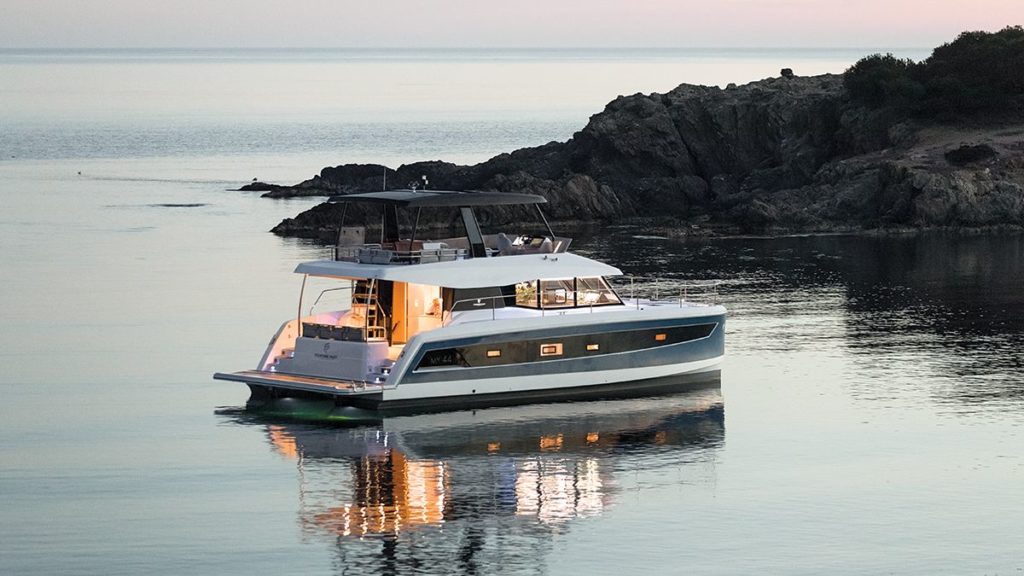
The Fountaine Pajot MY44 , a creation of Italian architect Pierangelo Andreani and French designer Daniel Andrieu, has a main deck that’s open from the aft-deck seating all the way forward to the starboard helm station. The sense of spaciousness is significant, for several reasons. First, four glass panels aft can all slide to port, creating an indoor-outdoor space with the aft deck and salon. In the salon, 32-inch-high windows extend for 12 feet down the sides of the yacht, with three sections per side, bringing in natural light along with the three forward panes that comprise the windshield. Finally, 6-foot-6-inch headroom provides vertical clearance, with a 21-foot-7-inch beam that adds interior roominess while keeping the yacht stable.
Read more: Fountaine Pajot MY44
Silent-Yachts 55
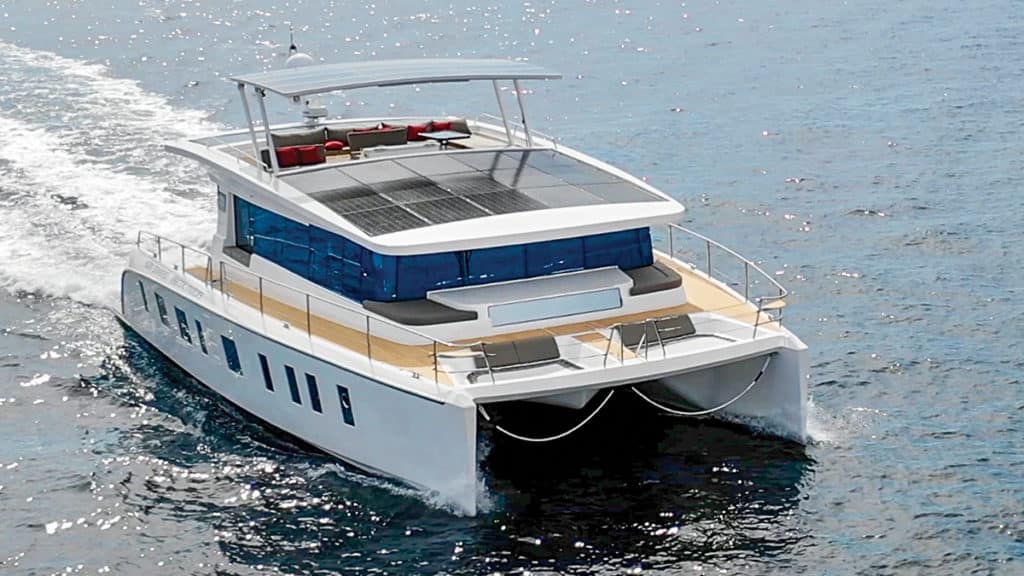
The ideas about which solar panels, electric motors, inverters and the like to use — and more importantly, Michael Köhler says, how to configure them — became the basis for the brand Silent-Yachts. The company offers 55-, 64- and 79-foot catamarans that run on solar-electric propulsion. The Silent 55 premiered this fall, and the 64 is sold out for the next two years, Köhler says.
Read more: Silent 55
Horizon PC74
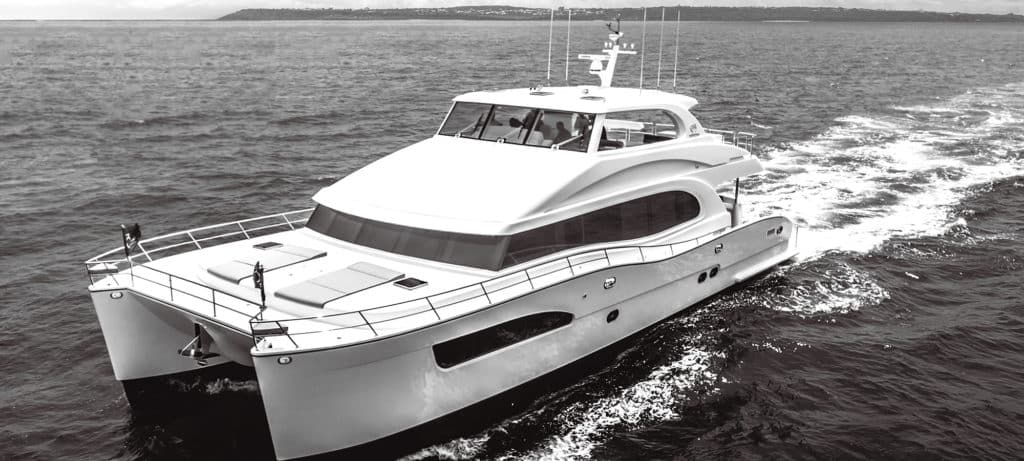
As founder and director of The Powercat Company, a Horizon Power Catamarans distributor, Stuart Hegerstrom had long believed that catamaran builders needed to design their yachts to more stylish standards.
“The boats were very boxy,” he says, based on his years of experience with cats in the charter market. He and his partner, Richard Ford, asked Horizon to produce models that had high-end finishes and looked good inside and out.
The Horizon team brought in mega-yacht designer JC Espinosa to work with its own craftsmen. The result aboard the Horizon PC74 is a catamaran with exterior styling, layout and functionality that should appeal to private and charter owners alike.
Read more: Horizon PC74
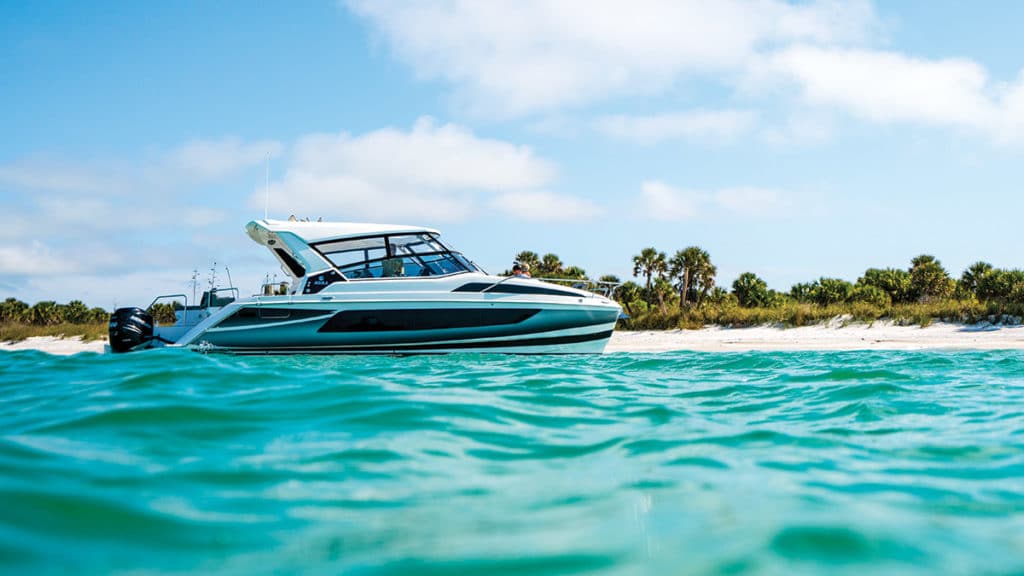
The Aquila 36 is a departure from her sisterships in that she is an outboard-powered, express-cruiser-style catamaran, but she also adheres to MarineMax’s philosophies.
With a single main living level from bow to stern and a beam of 14 feet 7 inches, the Aquila 36 is like a bowrider on steroids. She has seating that can handle 20 adults for outings and barbecues, and there are two staterooms below, one in each hull, for family weekending. The staterooms have nearly queen-size berths, en suite heads, stowage and 6-foot-6-inch headroom.
Read more: Aquila 36
Lagoon Seventy 8 Powercat
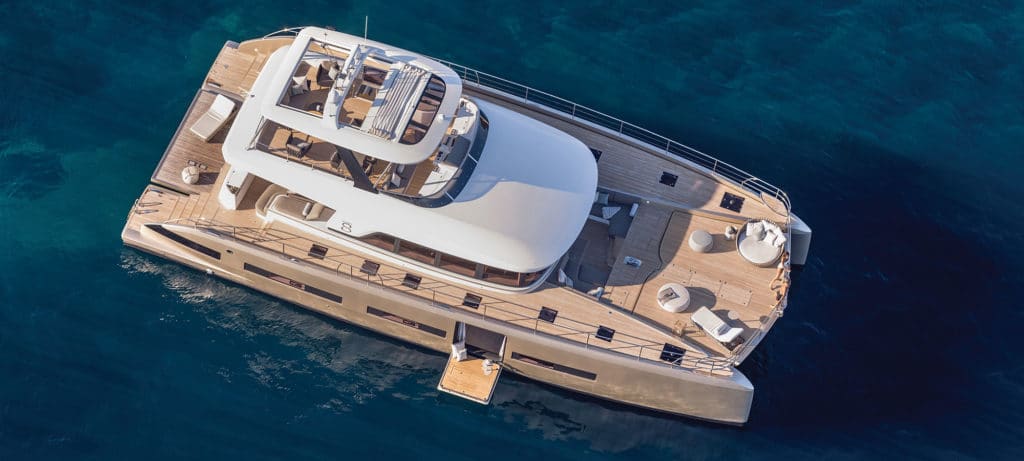
Lagoon is a division of Groupe Beneteau, the world’s largest builder of sailing yachts, and the Lagoon Seventy 8 Powercat is a developmental sistership of its Seventy 7 super sailing cat. The Seventy series yachts are built at Construction Navale Bordeaux in France, which had to add a new yard to construct these catamarans because they require separate stern molds for the power and sail versions.
Read more: Lagoon Seventy 8 Powercat
Horizon PC60
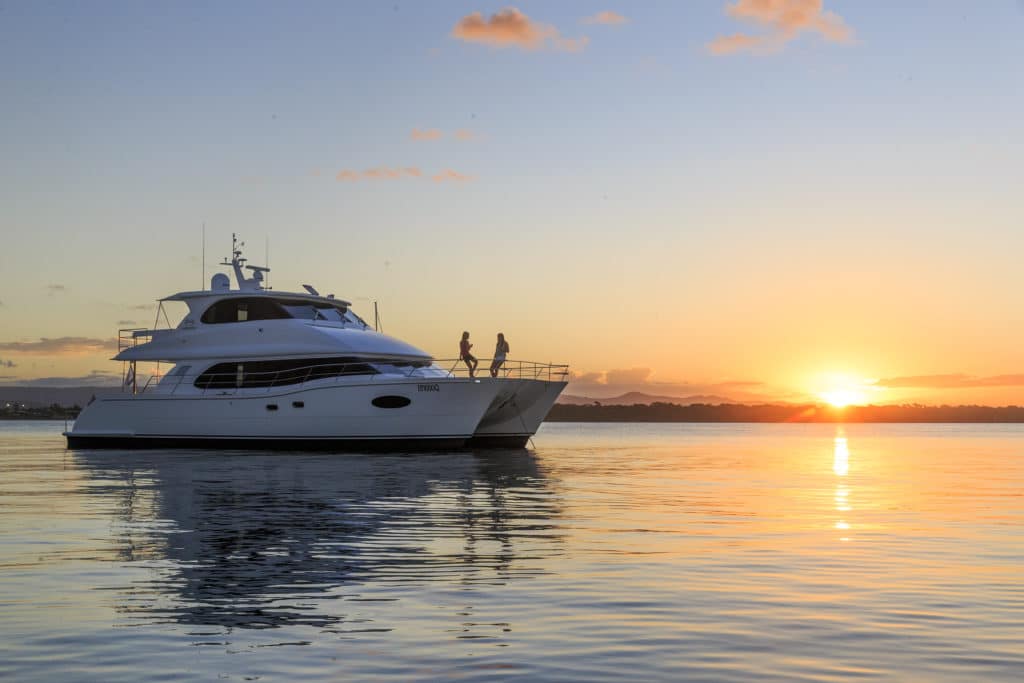
To understand the Horizon PC60 power catamaran , you need to put aside preconceived notions about midsize yacht amenities. For example, main-deck master suites are the province of yachts over 100 feet length overall. Incorrect. This 60-footer has an elegant and spacious owner’s stateroom on the same level as the salon. If you want a 14-foot center console tender on a 60-foot yacht, you have to tow it. Wrong again. On the PC60, you hoist it onto the upper deck, no problem.
Read more: Horizon PC60
40 Open Sunreef Power
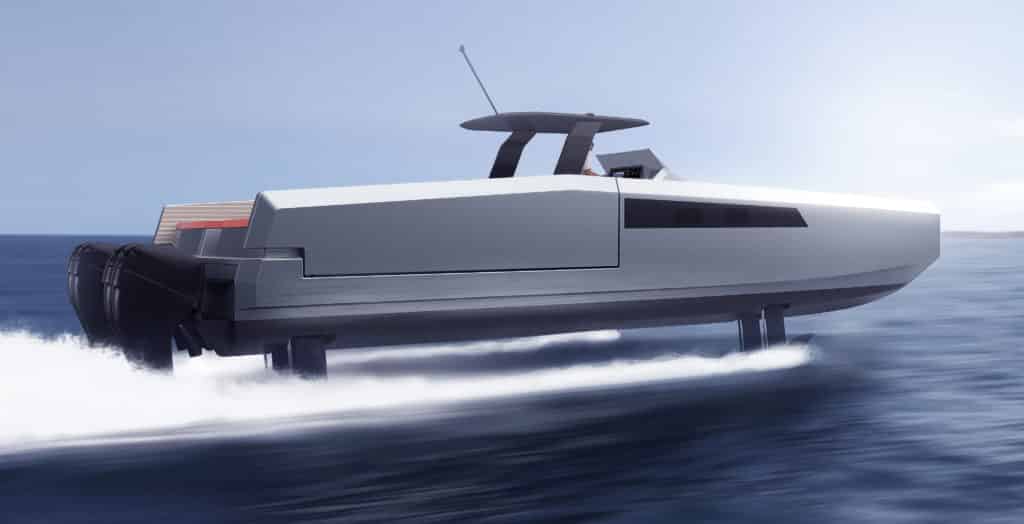
Sunreef is known for pushing the boundaries of catamaran design, incorporating four adjustable hydrofoils into a twin-hulled speedboat.
The Polish builder is one of several European builders (including Evo, Fjord, Wider and Wally) transforming the open day-boat category with creative designs. Beyond its hydrofoils, the 40 Open Sunreef Power ‘s cockpit has side “wings” along the aft gunwales that fold out at anchor, widening the beam from 17 feet to 22 feet 9 inches.
Read more: 40 Open Sunreef Power
Sunreef 50 Amber Limited Edition
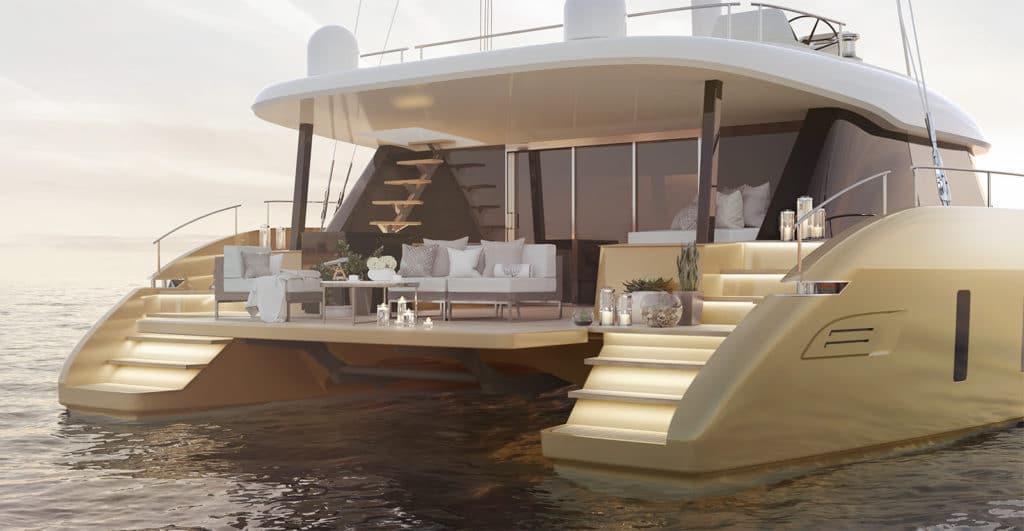
Sunreef Yachts introduced its 50 Amber Limited Edition , with plans to launch just 10 hulls of the exclusive design.
The Sunreef 50 Amber Limited Edition will have a carbon fiber mast and boom, four layout options and numerous amber-colored elements, including the hull.
Read more: Sunreef 50 Amber Limited Edition
Lagoon 630 Motor Yacht
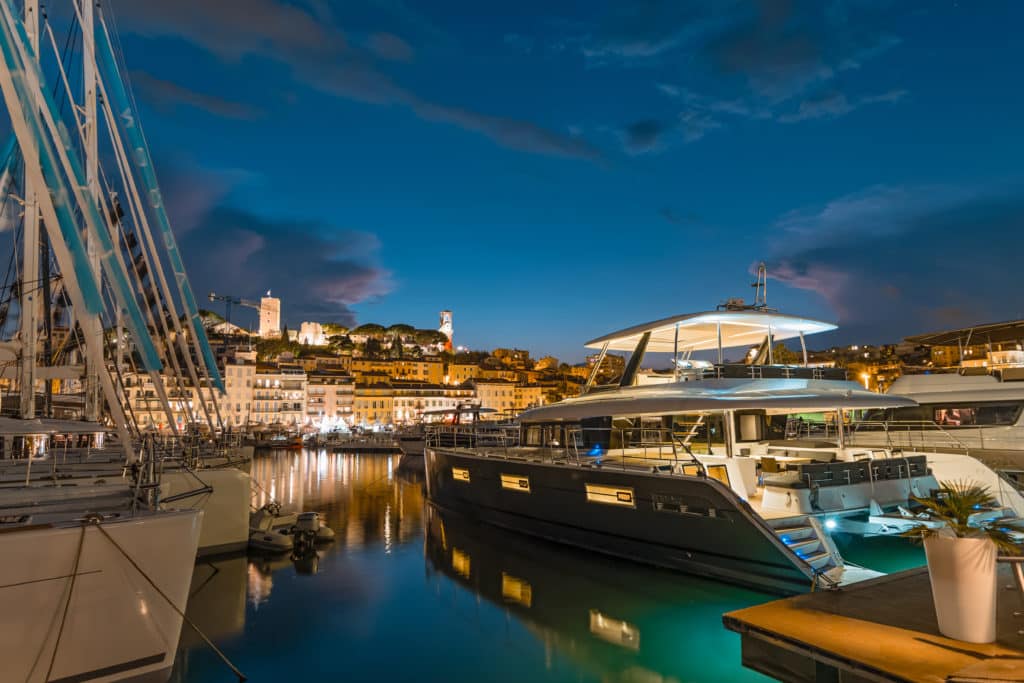
Fitted with the optional twin 300-horsepower Volvo Penta D4 diesels, the Lagoon 630 MY burns only 1.64 gph total at 6 knots, giving a theoretical range of 2,952 nautical miles with standard tankage of 793 gallons. Hull No. 1 had an optional 502-gallon tank, giving it transatlantic range.
Luxury, stability and economy are all hallmarks of Lagoon’s return to luxury motor yachts. If you can take a ride, it will be worth your time.
Read more: Lagoon 630 Motor Yacht
Fountaine Pajot MY 37
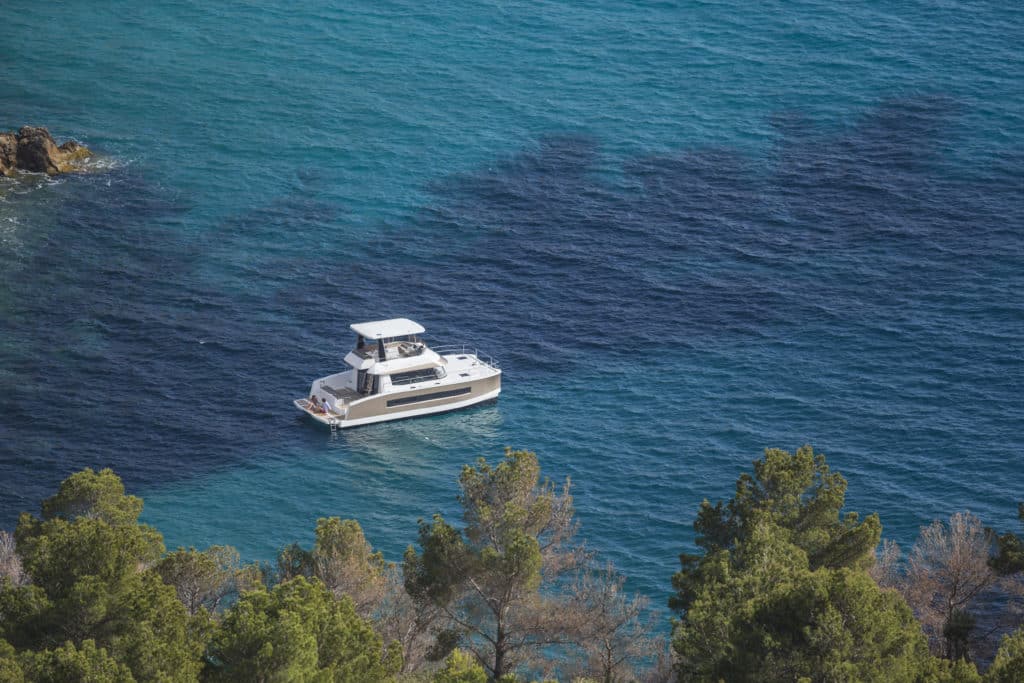
The Fountaine Pajot MY 37 easily accommodates the seafaring family with three- and four-stateroom options. In the three-cabin version, called Maestro, you’ll find an owner’s suite in the portside hull with a queen-size berth and en suite head. Two double-berth cabins and one more head are available for the kids. If your brood is bigger, the Quator setup features four double cabins with two heads.
The 37 is a traveler and can be powered with twin 150 hp or 220 hp Volvo Penta diesels. Top speed with the smaller engines is 17 knots, while it’s 20 knots with the bigger power plants. Interestingly, at 7 knots, the fuel consumption is the same, with either set of motors offering voyagers a 1 ,000-nm range.
Read more: Fountaine Pajot MY 37
Solarwave 64
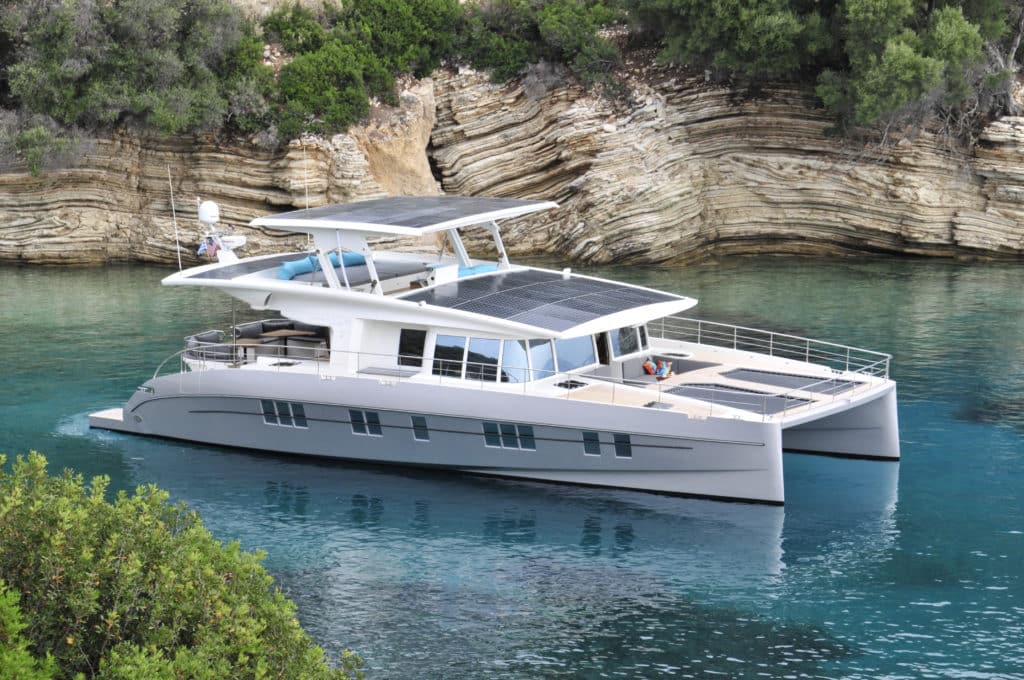
Many yachts boast eco chops because they have a handful of solar panels that power the microwave or navigation lights. The Solarwave 64 , launched last summer, has the potential to run on sunshine alone. The vessel’s 42 solar panels generate 15 kW that are stored in batteries weighing about 1,300 pounds. They connect to electric motors.
Read more: Solarwave 64
Glider SS18
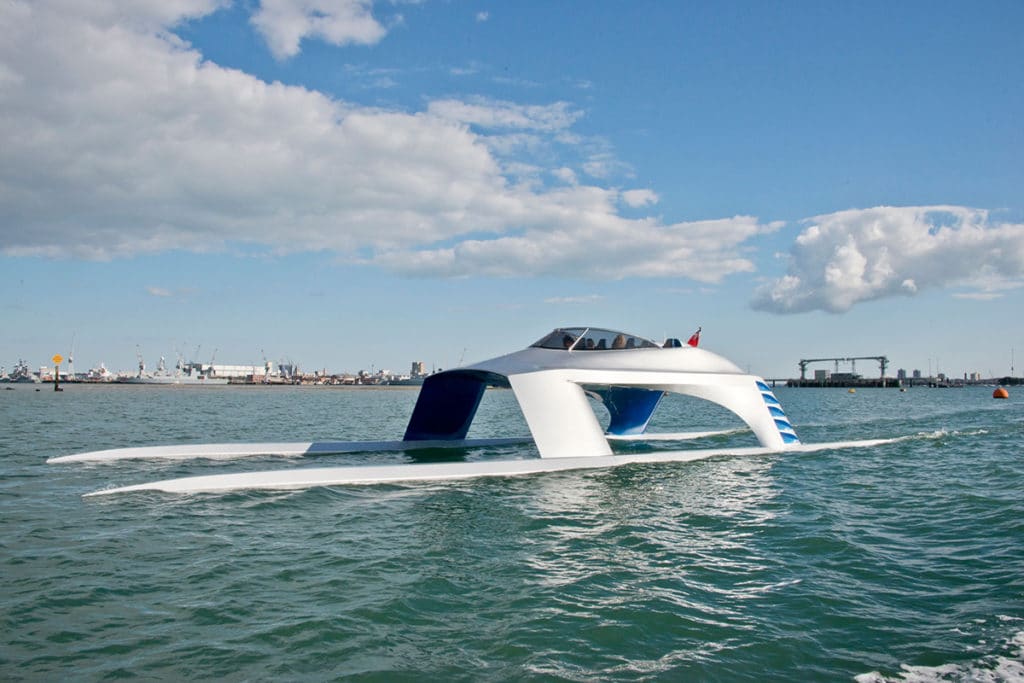
This British builder says it strives for design innovation and the Glider SS18 displays that DNA, the result of 8 years of research and development. She has a head-turning, catamaran hull form constructed from aluminum and composite materials. She is 60 feet LOA with a 17-foot beam, and has a relatively shallow 1-foot draft. Powered by quad Yamaha 300 hp outboards, she can reportedly reach 50 knots, and with her Stability Control System (SCS), should give a smooth ride while doing it.
Read more: Glider SS18
- More: aquila , Aquila Boats , Express and Flybridge Cruisers , Fountain Pajot , Glider Yachts , Horizon Power Catamarans , Lagoon , Power Catamarans , Silent-Yachts , Sunreef , Yachts
- More Yachts
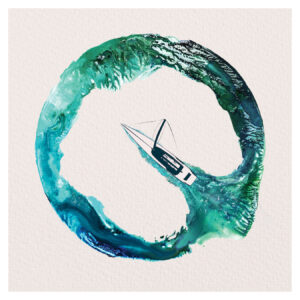
Royal Huisman to Build 264-Foot “Noir”
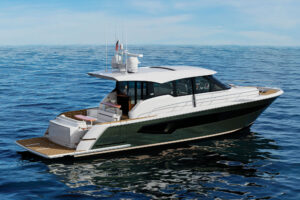
Tiara Yachts EX 54 Expands Series
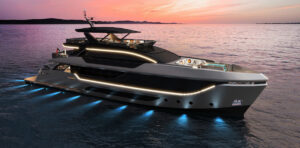
Van der Valk’s Biggest Motoryacht Yet
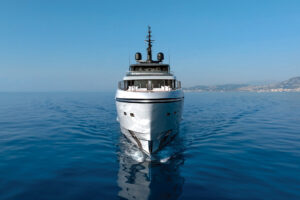
Sanlorenzo 57Steel Reviewed
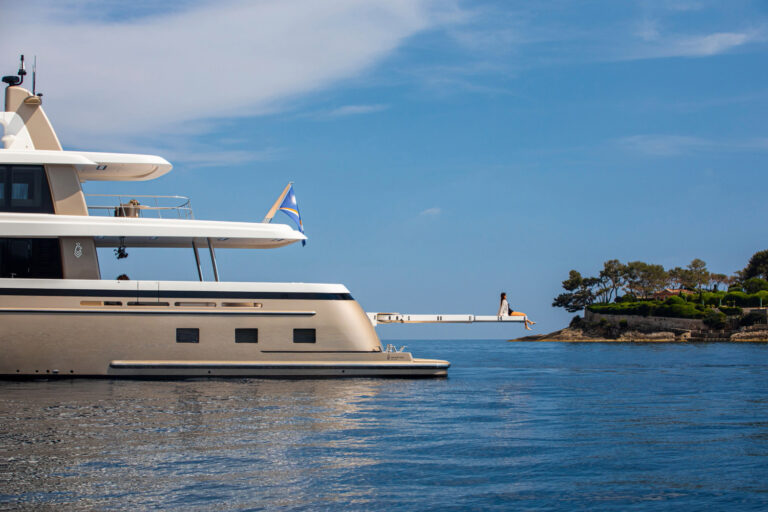
Your World, Your Yacht
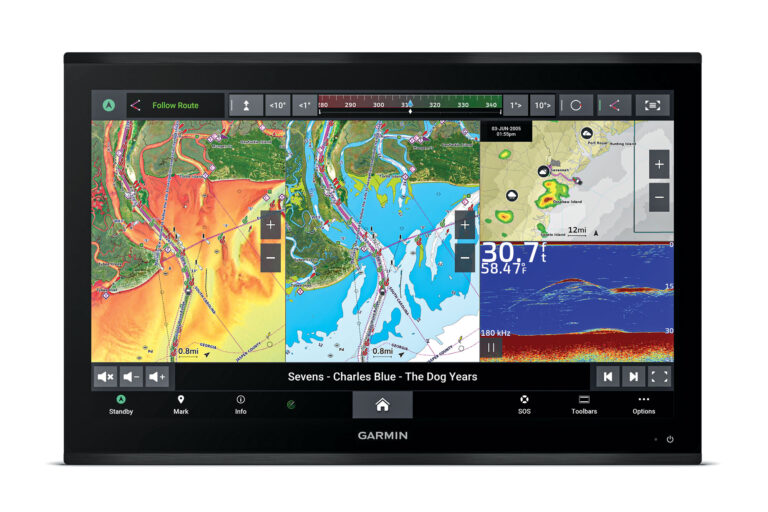

Garmin GPSMap 9000 Series MFD
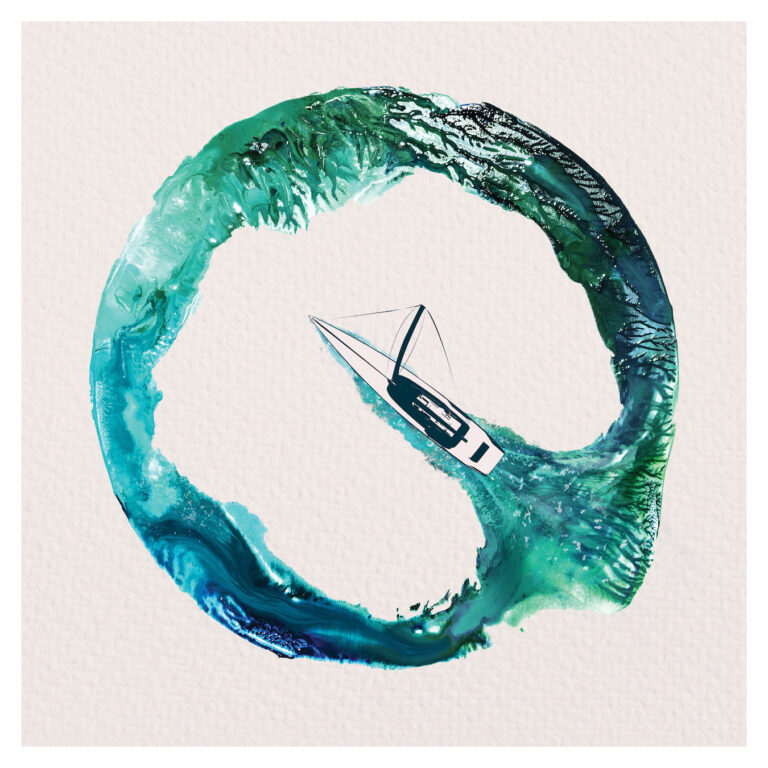
For Sale: Offshore 62

- Digital Edition
- Customer Service
- Privacy Policy
- Email Newsletters
- Cruising World
- Sailing World
- Salt Water Sportsman
- Sport Fishing
- Wakeboarding

My Cruiser Life Magazine
Monohulls or Catamarans – Which is Best for the Cruising Sailor?
The debate between catamarans vs monohulls still rages, and most boaters are firmly on one side or the other. The truth is, either a catamaran or a monohull can provide a wonderful way to enjoy sailing, traveling, and being on the water.
Both have advantages and disadvantages, and both have large and loud fan clubs. The choice between a catamaran and a monohull depends on your budget, lifestyle, and personal preferences.
My wife and I have owned both types of vessels over the years. After five years of cruising on a Lagoon catamaran, we decided to go old school and bought our current boat—a heavy, full-keel monohull. The catamaran was fun, for sure—but it wasn’t for us in the end. Here’s a look at all of the differences we learned about during our journey.
Table of Contents
Life at anchor, life at a dock, life underway, living space, storage space, ride comfort and motion at sea, maintenance time and costs, docking and maneuvering, capsize risk, hull breach scenarios.
- Rigging Safety
Rigging Strength and Configuration
Monohull vs catamaran speed, thoughts on catamaran vs monohull for circumnavigation, deciding monohull vs catamaran, faqs – catamarans vs monohulls.
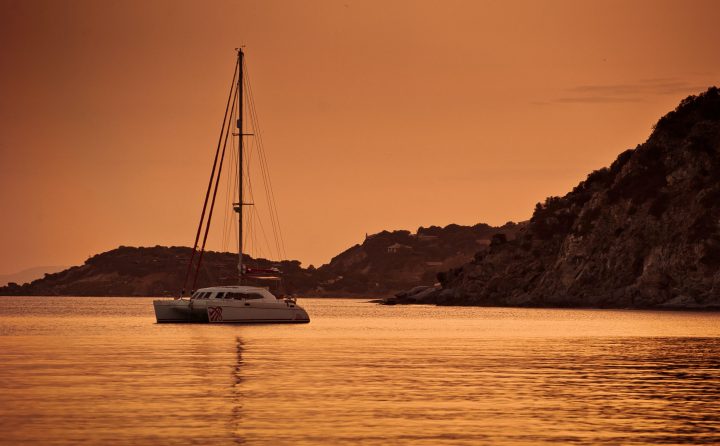
Life on Sailing Catamarans vs Life on a Monohull Vessel
At anchor, a catamaran provides superb comfort and living space. The “upstairs” cockpit and salon mean that boaters can enjoy non-stop wrap-around views. Monohull boaters are stuck in their caves and must peek out of their small portlights or climb into their cockpits to view the world.
A modern catamaran will also have swim steps that make it easy to get on and off the boat and provide easy access to dinghies and water toys.
If there’s an uncomfortable roll or swell in the anchorage, the catamaran’s stability will make the roll a bit less noticeable. Monohull boaters are more likely to be adversely impacted in a rolly anchorage. This does not mean that the cat owners are getting a perfect night’s sleep every evening, however. Catamarans just have a different motion in rocky anchorages, not a lack of motion.
Life at a dock gets a little more tricky for catamarans. Most marinas were built long before the catamaran trend and feature traditional slip sizes meant for monohulls. Marinas have to put catamarans on t-heads or make other accommodations. Therefore, it can be harder and more expensive to find a catamaran-friendly dock.
Once at a dock, the massive space of a catamaran can be harder to heat and cool efficiently. Catamarans usually need several air conditioners or heaters installed, whereas a monohull can get by with only one or two. That also means that cats might need more power (50 or 100 amp service instead of 30 amp) than some marinas can provide.
Monohulls will have fewer issues finding marinas that can accommodate them, and they pay standard rates.
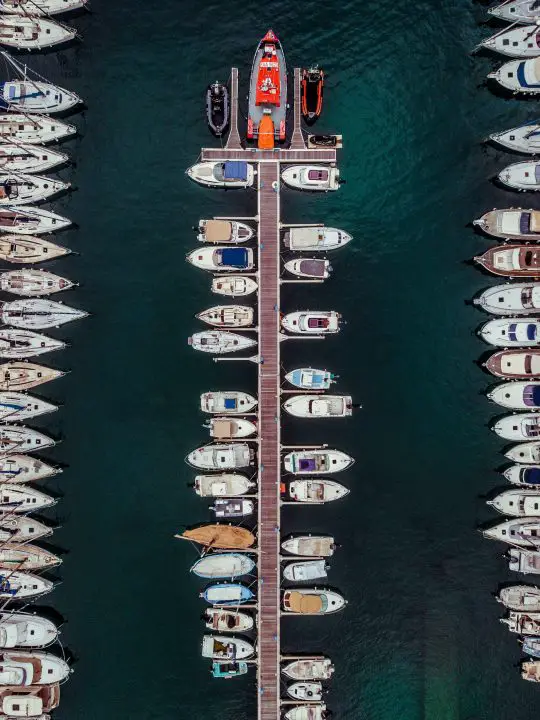
When sailing in protected waters, catamarans usually speed past their monohull friends. A catamaran provides a flat ride and sailors can move around their boats easily to make sail changes as needed. Walking on a catamaran’s deck is undemanding.
Catamaran sailors also have many options to rest comfortably underway. Because catamarans don’t heel over, catamaran sailors can sleep in their usual cabins. They can move about the interior of the boat with ease. Cooking in the galley doesn’t usually look any different underway.
In similar conditions, a monohull will heel over. Some sailors love the feeling of being heeled over and feeling the wind in their hair. Some don’t. It can be more challenging to walk the decks and work sails on a monohull vs a catamaran. While in the cockpit, monohull sailors will want to sit on one side and may even need to brace themselves to stay comfortable. For long trips, there is no doubt that living while heeled over for days at a time is exhausting.
Moving around the interior of a monohull boat at sea is also more challenging. Monohull sailors usually sleep in sea-berths with lee cloths instead of their usual quarters. It would be very uncomfortable to sleep in a v-berth underway, as the bow may be continuously pitching in seas. The lee-cloth in the sea-berth helps keep a resting sailor in their berth instead of falling onto the floor.
Monohull boats have gimbaled stoves. Even while the boat is heeled over, the galley stove will remain level. However, cooking in a monohull while underway is still more challenging than cooking in a catamaran since the cook needs to constantly brace themselves against the heel and rolling motion.
At the same time, none of this is to say that catamaran sailors have it easier at sea. In reality, catamarans may be more level, but they feel every wave in the ocean twice. The result is a choppy, bumpy ride with no rhythm. It can be just as tiring as being heeled over in a monohull.
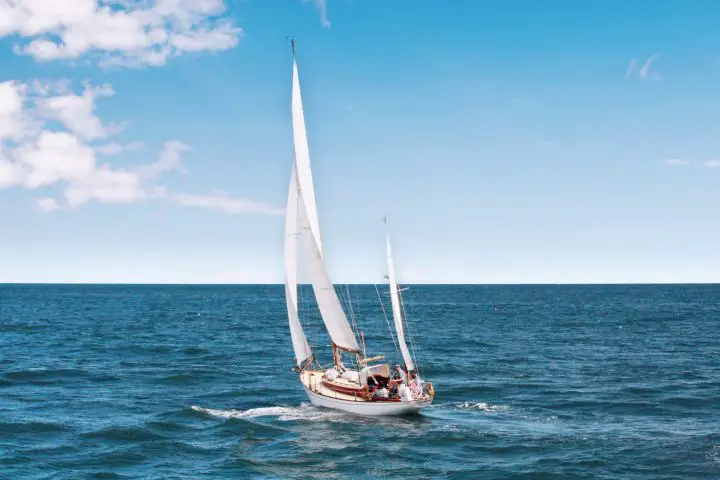
Catamaran vs Monohull Sailing Compared
Here are just a few ways that catamarans differentiate themselves from monohulls as platforms for living aboard.
- Living space—quantity and quality
- Storage space and weight
- Budget—purchase and routine maintenance
- Maintenance
- Catamaran vs Monohull for Circumnavigation
- Docking and close-quarters maneuvering
Catamarans have significantly larger and often more attractive living spaces. On the other hand, the living space on a monohull is usually small and can be dark due to small windows.
A monohull’s cockpit tends to be small and focused on safety. Families are more likely to feel in each other’s way, and moving around while others are seated can be awkward. On a catamaran, the cockpit is likely to be large and social. Catamaran cockpits have large tables and lots of lounging space in the cockpit.
Catamarans have large trampolines forward, which provides another comfortable, social lounging space that monohulls lack. Many catamarans also feature additional lounge space via the large cockpit roof.
The salon on a monohull is located in the main cabin. A monohull’s salon will be smaller than a similarly-sized catamaran. Often there is a small table, room for several people to sit, and a single sleeping berth.
Catamarans feature a wide bridge deck that crosses both hulls. This large living area features great visibility, ventilation, and natural light. On some catamarans, the galley is located on the bridge deck (called “galley up”), and on others, the galley is located in one of the hulls (called “galley down”).
Monohulls have sleeping quarters in the bow and stern of the boat. On smaller monohulls, the main sleeping area is usually a v-berth. Older, smaller monohulls usually have just one head.
On a catamaran, the sleeping quarters are located in each hull. These cabins often feature regular-sized boat beds and large en-suite heads. Cabins on a catamaran usually offer more privacy than monohulls.
Catamarans are popular with charter companies because large families or groups of friends can enjoy living on a boat together in style and comfort. Each will have a private cabin and a private head. In addition, if you want to find space to exercise, do yoga, or watersports, you’ll find these activities much easier and more comfortable on a catamaran.
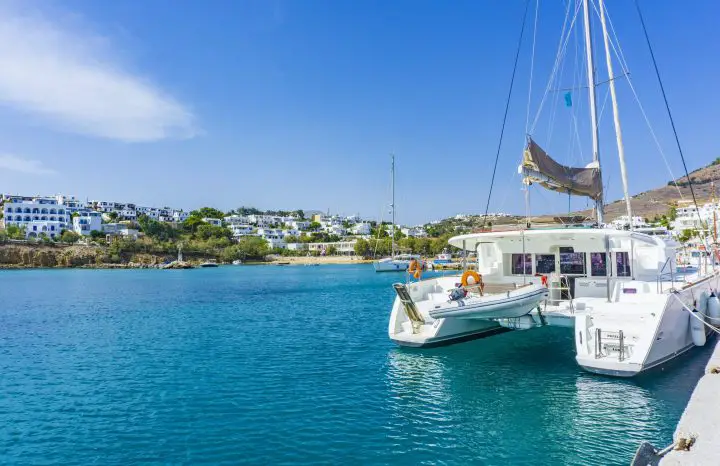
Catamarans have more space in general and certainly have more storage space. The additional deck space catamaran designs offer lends to easy storage for larger items, such as paddleboards and kayaks. Catamarans can often hoist and store larger dinghies than monohulls can. Large compartments make storage easy.
However, many catamaran owners are very cautious about storing too much. Additional weight can slow down a catamaran’s performance speeds. With so much space to put things in, it’s remarkably easy to overload a cruising catamaran. Many owners complain about the performance of smaller cats, when in reality they are often just badly overloaded.
Monohulls have less space and less storage. Finding space for big items like water toys can be challenging. But monohullers worry less about weight and freely carry around their cast iron skillet collections—because weight doesn’t impact performance on a monohull nearly as much.
This is a consideration when cruisers consider adding additional equipment. For example, a catamaran owner will have to consider the added weight of a generator and its detriment to sailing speed. In contrast, a monohull owner will have to consider finding space for the new generator.
Some prefer the motion of a monohull while sailing. Monohulls heel over but are steady, and sailors usually get used to the heeling motion. On a catamaran, if conditions are good, the boat won’t heel and will provide a comfortable ride.
When sailing upwind, some catamarans experience bridge deck slamming. Waves get caught between the two hulls and create a slamming motion and sound. It’s hard to predict the timing and strength of each slamming motion, so some catamaran sailors can find it tiresome.
The amount of bridge deck slam varies from boat to boat. Catamarans with higher bridge decks will experience less slamming, while boats with bridge decks closer to the water experience more.
Beyond that often-discussed issue, there is also the issue of the boat’s motion. It’s very difficult to imagine how different the motions are when compared to one another. The monohulls slice through the waves, usually with a predictable rhythm. A catamaran, built lightly to sail fast, feels more like it bounces over the tops of waves. The crew will feel each impact as each hull hits each wave. The result is a choppy, unpredictable motion—but it’s generally flat and level.
Monohulls have been around for ages. Therefore, sailors just starting out can find inexpensive, older monohulls. If you have a tight budget, you’ll probably start looking for a monohull.
Catamarans are newer to the market. Therefore, the initial purchase price of a catamaran is likely to be higher. Monohull buyers can often find a used, well-equipped, comfortable monohull for less than $100,000. Catamaran buyers usually spend upwards of $250,000 for a used cruising catamaran.
Because monohulls have been produced for so long, there is much more supply. The catamaran’s more modern pedigree means that there are always fewer catamarans on the market than monohulls. As more and more customers are drawn to the attractive living space and stable sailing offered by catamarans, demand keeps going up, while supply remains low.
Besides the higher up-front costs, catamarans are more expensive to keep and maintain. A monohull usually just has one engine. A monohull might have one head (bathroom) and will generally have less equipment. Monohulls have less space and storage, after all. Catamarans have twin engines, multiple heads, more hatches—more everything.
With more equipment, catamarans have higher maintenance costs. When a monohull owner services their engine, they have just one engine. A catamaran owner will need to service twin engines. Furthermore, each hull on a catamaran usually has separate and independent systems like bilge pumps, plumbing, fuel, water tanks, holding tanks…the list goes on.
A monohull owner will paint one hull bottom and wax only one hull. A catamaran owner will do everything twice. Therefore, the effort and cost of maintenance are often doubled on a catamaran.
Not only does it cost more money, it can also be harder to accomplish maintenance on a catamaran. You see, catamaran owners have fewer options to haul out. Most older boatyards have travel lifts that only accommodate boats up to 18 or 20 feet wide. Therefore, catamarans need to find a boatyard that has a large enough travel lift or a trailer to haul them. Because there is less supply and more demand for these larger travel lifts, the cost of hauling out a catamaran is often higher.
While some monohulls have lifting or swing keels and can reduce their draft, most catamarans have a shallow draft. This allows them greater flexibility while choosing anchorages. Even if a catamaran and monohull boat choose the same anchorage, the catamaran can get closer to shore and get better wind protection.
One final big difference between these two types of vessels is their ability to maneuver in tight spaces. Monohull sailboats are notoriously difficult to maneuver around docks and marinas. They often have poor visibility from the helm and difficult handling, especially in reverse. The single-engine design often requires a bow thruster, even on smaller boats.
The contrast that catamarans offer is pretty stunning. Even though they appear massive and ungainly in comparison, their twin engines mounted far outboard enable them to spin in their own length. Catamarans can be maneuvered in pretty much any direction using only differential thrust from the engines–all without a bow thruster.
Safety Considerations — Are Cruising Catamarans Safe?
Since most people have only limited experience with these vessels, many people wonder are catamarans safe. Even though they have been making large cruising cats for decades now, most of us have only really played on Hobie cats at the beach. And if there’s one thing we know about Hobie cats, it’s that they’re a lot of fun until you flip it over!
Here’s a look at a few safety considerations and how catamarans stack up against monohulls.
- Catamaran stability — capsize potential
- Hull breaches and sinking risk
- Rigging failures
- Designing for speed
- Redundancy on board
So, can you capsize a cruising catamaran? The answer is yes, no matter what the fanboys and girls say. It is technically possible but highly unlikely. Cruising cats are massive, and in all likelihood, you’re more likely to break the rigging than flip the boat. But in rough seas and extreme conditions, it does happen even on modern catamarans.
If a monohull encounters strong winds and rough weather, it will heel and roll significantly—but it will keep righting itself. In dire conditions, the vessel could suffer a knockdown. But a monohull will always right itself after a roll—it has tens of thousands of pounds of heavy keel to ensure that it does. Of course, the rig and anything on deck will sustain serious damage in the process, but the boat will be upright in the end.
In the same scenario, while unlikely, a catamaran can capsize. And the catamaran will then remain capsized, with no possibility of righting itself.
One of the scariest risks at sea is that of a serious hull breach, one that a bilge pump couldn’t keep up with. For example, a boat could be holed by an errant floating object or suffer a stuffing box or through-hull failure.
If a monohull sailboat is holed, it could sink straight to the bottom of the ocean. The crew would be left with only a liferaft and whatever they were able to recover before the sinking.
But a catamaran is filled with foam and is (more or less) unsinkable. If a catamaran experienced a hull breach or capsizes, it would take on water and may become less habitable. However, it will still float. In many cases, not much of the boat is left above the water—but it’s still at the top of the water.
Boaters may be able to perform emergency repairs and get the boat to port themselves. Or, they may have to stay with their vessel until help arrives. In either scenario, the crew maintains access to supplies and can stay with a much larger vessel, increasing the likelihood of being found and rescued.
Some catamaran sailors are so certain of their vessels floating in all scenarios that they don’t even carry a liferaft aboard. This is fool-hearty, to say the least, given the crazy and unpredictable things that can happen to any boat on the ocean. But one scenario is equally scary for the monohull or the catamaran sailor and should convince everyone that any offshore vessel should have a liferaft—the possibility of an uncontrollable fire.
Rigging Safety
When wind speed increases, a monohull will heel over. This heeling motion sheds the excess power of the wind. Monohull boaters should pay attention to the weather and reduce sail to ensure they aren’t overpowering the boat. This is why knowing how to reef a sail is so important for all sailors.
However, on a catamaran, the sails and rigging take the increased load when wind speed increases. Catamarans don’t heel, and therefore, don’t shed excess power. If the weather becomes gusty and a catamaran has too much sail up, all that extra power is transferred to the sails and rigging.
This can cause a dangerous situation. For example, there have been reports of catamarans being de-masted in sudden gusts of wind. In a worst-case scenario, a catamaran could capsize if they are over-canvassed when experiencing extreme wind conditions.
Most monohulls have strong standing rigging. The forestay is connected to a solid structure, the hull. This means that the forestay has a strong, stable platform and gives a monohull better upwind performance. Monohulls also usually have backstays, which provide rigging redundancy.
On a catamaran, the forestay is attached to a crossbeam. Because the platform is not as rigid as a monohull’s hull, the forestay is not as strong. In addition, catamarans usually don’t have backstays, and therefore have less rigging redundancy.
The configuration of the rigging is another rigging consideration. On a monohull, the spreaders and shrouds are perpendicular to the mast. Most catamarans come with fractional rigs that don’t have backstays, and their shrouds are set far back. Because of this configuration, catamaran sailors can’t let their mainsails out all the way on a downwind run because the shrouds are in the way. This leads to less efficient sail shapes when sailing downwind.
However, catamaran sailors can rig their sails to sail wing-on-wing. While monohull sailors can also use this configuration with the help of a whisker pole, catamaran sailors have a nice, wide, stable platform to fly large downwind sails.
There’s no doubt about it–catamarans sail faster. Most articles and comparisons state that catamarans are about 20% faster than a similarly sized monohull. Catamarans have a lower wetted surface area and less drag than monohulls. They’re especially nice to sail in light winds, conditions that heavy cruising monohulls tend to not do well in.
While most cruising cats can’t sail upwind as high as monohulls can, they still win the race. However, if a catamaran has daggerboards and a good sail inventory, it can point as well as a monohull.
Many boat owners believe that speed equals safety, as you might be able to outrun an impending storm. That’s a debatable strategy since weather systems often move faster than any cruising boat can move. It has a lot more to do with planning and the decisions made by the skipper, in the end.
Furthermore, more speed means a rougher ride. A heavy, full-keeled monohull might not move very fast, but the sea-kindly and forgiving ride means a more comfortable and better-rested crew. This only goes to illustrate that the “more speed” argument is far more of a personal preference than many sailors admit—especially when it comes to long-distance cruising.
A faster boat provides a skipper with more options, but it does not ultimately equal inherent safety. That will always come down to the skipper and the crew, and the choices they make. A slow boat in the hands of an experienced and careful crew will always be safer than a fast racer under the command of an inexperienced and green crew. In other words, there is no replacement for seamanship and careful planning.
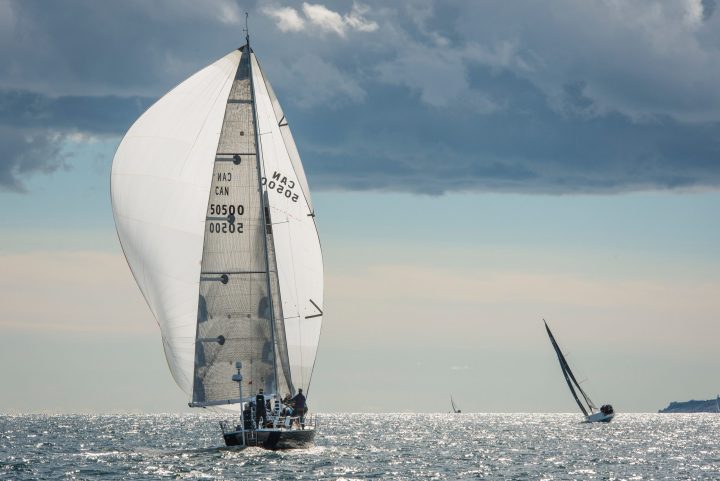
Catamarans have two of everything. While this does equal double the cost and maintenance, it also provides redundancy. If a monohull’s single engine dies and there is no wind, they may have to call for a tow or wait for wind. If a catamaran’s left engine dies, sailors can just continue on the right engine.
Twenty years ago, the majority of boats completing circumnavigations were classic bluewater monohulls. Monohulls are considered safe and capable circumnavigators.
But today, catamarans are establishing themselves as the more desirable choice for many circumnavigators. Catamarans are fast, stable, and capable of crossing oceans. In addition, catamarans can carry significant supplies and offer redundancies. Plus, the extra space that catamarans provide also means that the crew will enjoy watersports like diving, paddle boarding, and surfing.
Since nearly all traditional routes are downwind “milk runs,” catamarans naturally excel along the way. If you take a look at the competing boats for the World ARC rally for the last few years, a definite trend is growing. More catamarans compete every year. Common entrants include Lagoon 450s and Antares 44s.
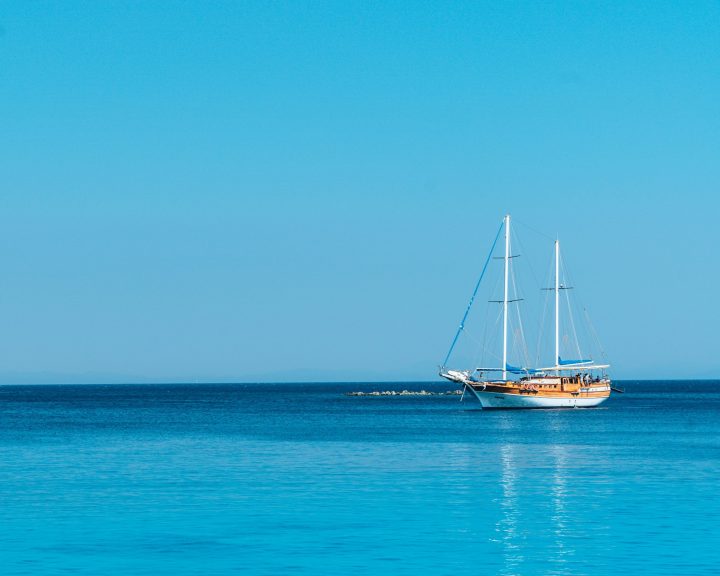
One of the most significant decision points when thinking about catamarans versus monohulls is your budget. If your budget is under $100,000, a monohull will be your best bet. If your budget is between $100,000 and $250,000, you can consider a smaller, older catamaran. Catamarans such as PDQs, Prouts, and Geminis will be in your budget. If you have a budget of over $250,000 and can afford higher dockage and maintenance costs, you can consider a catamaran.
Next, consider your comfort level. To try it out, you might want to charter both a monohull and a catamaran. Check out a sailing vacation in the BVI or with a company like Cruise Abaco. Taking classes at our local sailing school might also be helpful. https://cruiseabaco.com
Many folks are attracted to the larger, more comfortable spaces of a catamaran. However, some people feel more seasick on a catamaran and can’t get used to the motion. So a lot of your decision will come down to personal preference.
If you can’t imagine squeezing into a darker, smaller cabin in a monohull, then a catamaran might be calling your name. On the other hand, if you are a traditionalist who loves heeling and boats with a lot of teak, a monohull might be your dream boat. It’s just impossible to know how a boat will make you feel until you’ve experienced both.
Boaters often discuss the compromises involved in boat choices. Whether you choose a monohull or a catamaran, there will be some compromises involved. However, no matter which boat you choose, you can enjoy smooth sailing, beautiful anchorages, and some adventure along the way.
Worried about getting caught in severe storm conditions in your boat ? Visit our guide!
Which is better monohull or catamaran?
Both monohulls and catamarans are popular choices for cruising sailors. Which one is better depends entirely on your personal preferences and which boat is more comfortable and appealing to you. If you are on a tight budget, a monohull is your best choice. On the other hand, if you love large open living spaces, a catamaran will be the better option.
Which is safer catamaran or monohull?
When wondering are catamarans safe, always remember that the primary determinant of the safety of a vessel is its captain, not the vessel itself. Both monohull sailboats and cruising cats have important limitations that their skippers must know and abide by.
Some consider catamarans safer because they are virtually unsinkable. If it has a hull breach or capsizes, it will still float.
Others see the sea-kindly monohull to be the safer bet, as they are better designed to protect their crews from the elements in severe weather. They also cannot capsize, as their ballast provides a righting moment in all conditions. But on the other hand, if a monohull experiences a hull breach, it can sink.
Can catamarans handle rough seas?
Modern cruising catamarans are built strong enough to cross oceans and survive in all kinds of conditions. It might be an uncomfortable ride, but not an unsafe ride. In the end, it is the skipper of the boat who ensures its safety at sea. Good seamanship makes a far bigger difference in how a boat handles rough seas than the design of the boat does.
In extreme conditions, such as hurricanes or sudden gusty winds, catamarans can capsize. Once a catamaran has capsized, it won’t right itself. However, it will still float, although upside down. Heavy seas are more likely to cause maintenance and chafing issues on both catamarans and monohulls.
Matt has been boating around Florida for over 25 years in everything from small powerboats to large cruising catamarans. He currently lives aboard a 38-foot Cabo Rico sailboat with his wife Lucy and adventure dog Chelsea. Together, they cruise between winters in The Bahamas and summers in the Chesapeake Bay.


Catamarans vs. Trawlers: The Differences Explained
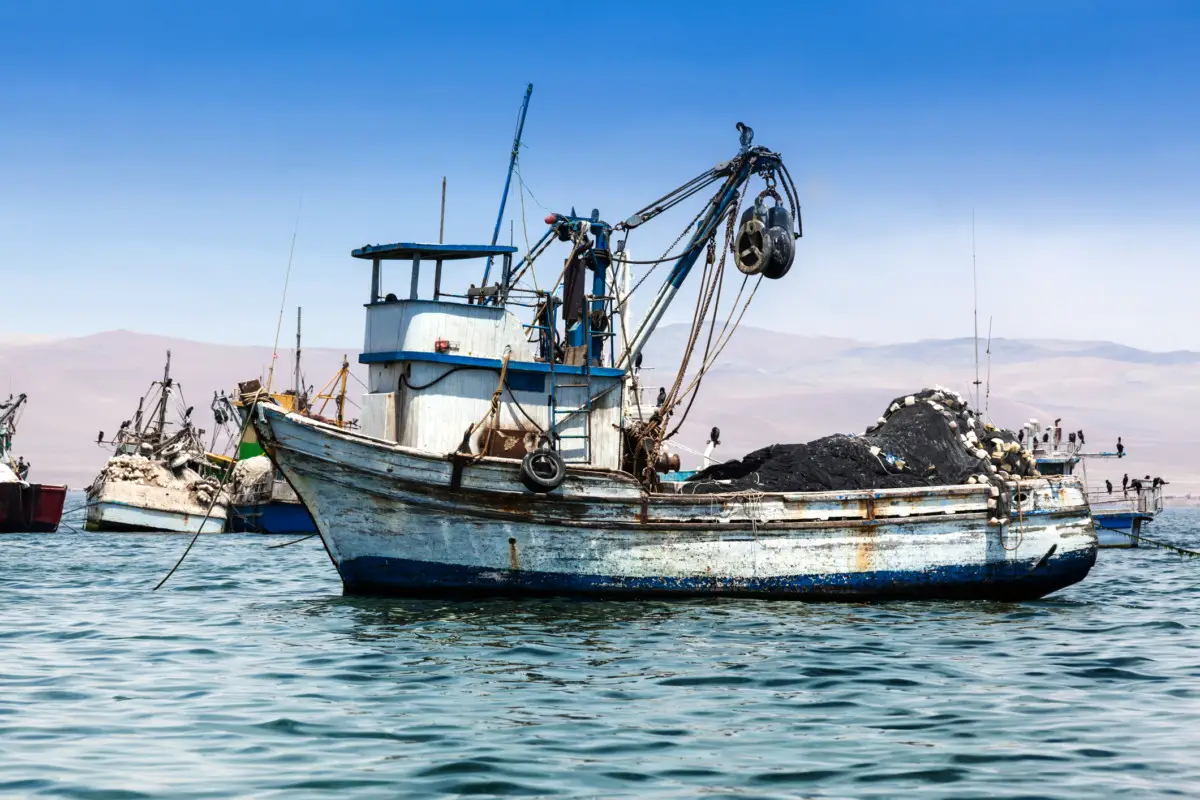
As an Amazon Associate, we earn from qualifying purchases. We may also earn commissions if you purchase products from other retailers after clicking on a link from our site.
Catamarans and trawlers are two vessels ideal for your sailing adventure. But while they are both great boats, they have different characteristics and therefore are more or less suited for specific tasks. So what are the differences between the two, and which one should you opt for?
Catamarans are double-hulled yachts that come in both sail and power editions (two diesel engines). Trawlers are single-hulled displacement boats powered by one diesel engine. Trawlers have better loading capabilities but cats are faster and more stable.
For anyone not very familiar with boats or sailing, it can be challenging to decide on the best-suited boat for your sailing needs. Fortunately, in this article, we explore the differences between catamarans and trawlers as well their pros and cons. Stick around to get all the information you need to choose your ideal sailing companion.
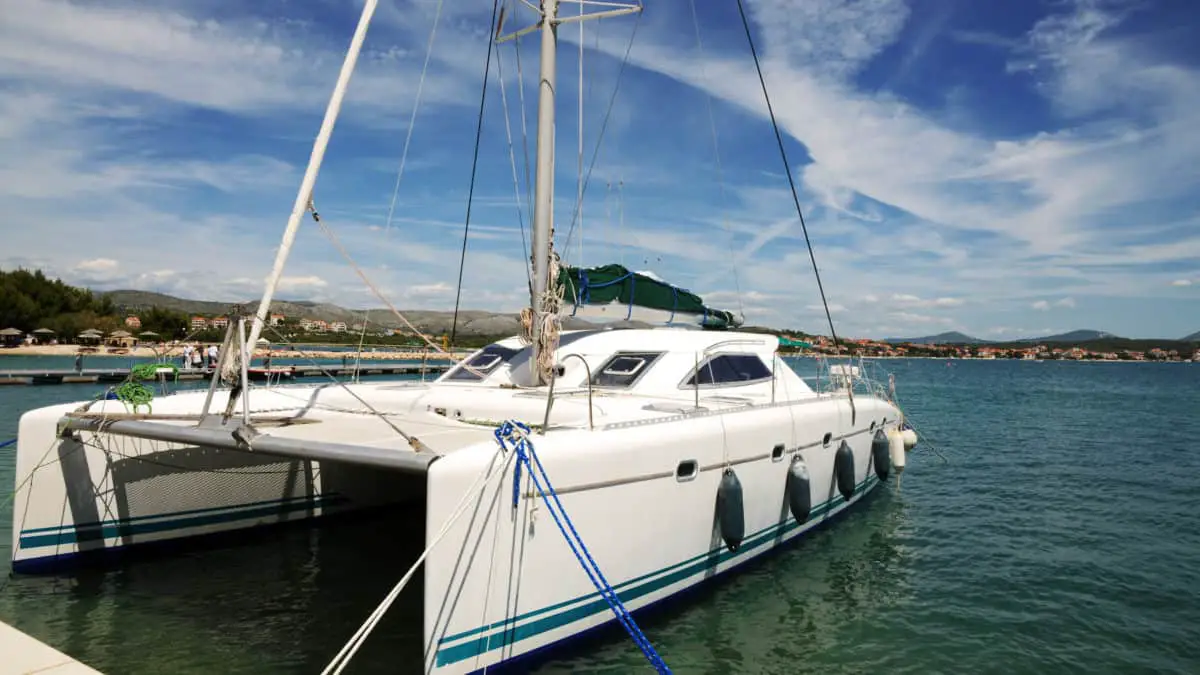
What Are Catamarans?
Catamarans are sailing vessels with double hulls and a deck in between (known as the bridgedeck ) connecting the two hulls. These sail or engine-powered boats are quite popular with leisure and sport boaters because of their elegant style, sleek designs, superb performance, versatility, and comfort.
Catamarans come in all shapes and sizes, from the tiniest beach cats you can lift with a friend or giant 70ft luxury ships worth millions of dollars.
These boats date back to the early centuries. They started off as simple fishing rafts made from bound tree trunks and were favored vessels throughout Polynesia and Micronesia. The modern catamaran is a modification of this unique, ancient design. By the 20th century, catamarans were full-fledged yachts, competing in races against mono-hulled boats.
Catamarans: The Pros
Let’s have a look at some of the advantages of catamaran boats.
Catamarans Deliver a Superb Performance
Catamarans are pretty fast. This is because their water length is double that of traditional monohulls. They are also light in weight since they lack lead keels – which typically weigh hundreds of kilograms. Cruising cats average around 10 knots (18.52km/hr or 18,520m/hr) with top speeds of about 15 knots (27.7km/hr or 27,700m/hr).
How fast can a catamaran sail?
While the structural design of most charter catamarans tends to focus more on space than speed, modern performance catamarans are quite the opposite. The latter can cruise 25 – 50% faster than similar-sized monohulls.
Their excellent performance is one of the main reasons why these boats are so appealing. Still, heavy loads tend to weigh them down. Thus, an overloaded cat will be much slower.
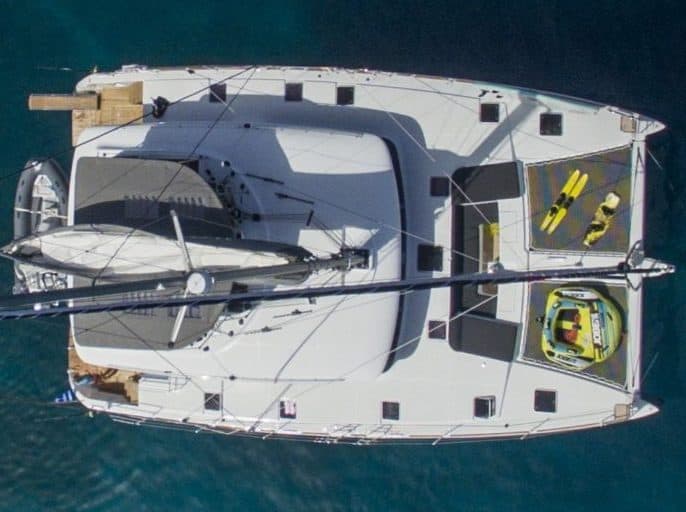
Catamarans Are Very Stable
Catamarans are stable flat platforms both offshore and at anchor. A cat’s stability comes from its wide beam since, unlike a monohull, it doesn’t have a ballasted keel. The cat’s flat plane and natural stability make it highly suitable for a family looking to enjoy their holidays in maximum comfort. It is also ideal for scuba diving holidays since divers can gear up, enter or exit from the water with ease.
Additionally, by minimizing the level of wave-induced motion, the twin hulls boost the catamaran’s balance and stability. What this means is that you are less likely to suffer motion sickness on board a cat.
Motion sickness on a cat?
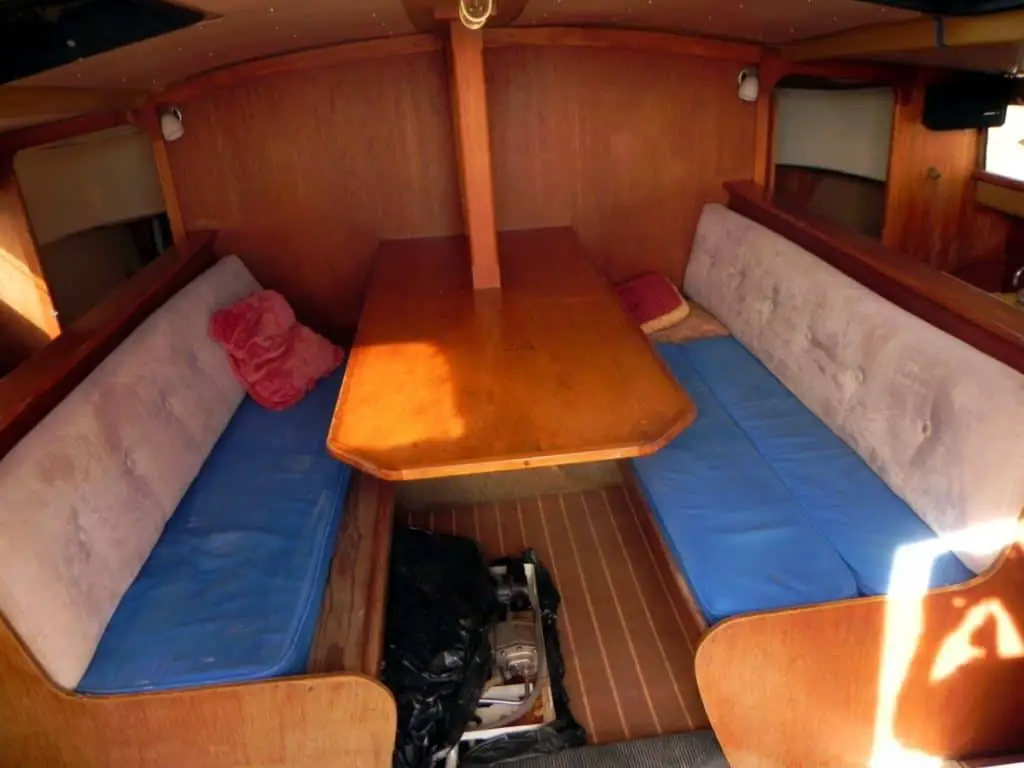
Catamarans Have Lots of Space
Catamarans are spacious boats. The space between the two hulls provides ample living room to fit a dining area, lounge, and a spacious kitchen for preparing your meals. The yacht’s back and front regions also offer additional lounging areas. With the varied relaxation areas, you get lots of privacy onboard a catamaran.
Double hulls translate to additional privacy since the cabins are separate. Furthermore, each hull typically comes with its own separate entrance. This feature makes catamarans well-suited for couples, families, or groups of friends. They also find the ample deck space and overall comfort quite appealing.
Larger families will also find a catamaran very convenient. While the cabins’ size varies depending on the catamaran model, they are generally spacious and comfortable.
What’s the perfect boat layout for you?
Catamarans Are Comfortable
Catamarans do not heel. Their wide stance on the water reduces heeling, wave-induced motion, and may also contribute to reduced wakes. What this means is that cats are pretty comfortable both while underway and at anchor. You can take a stroll on deck with ease and enjoy a drink without worrying about spilling its contents on yourself.
These features make cats ideal for families with young ones or elderly grandparents who might not be too steady on their feet.
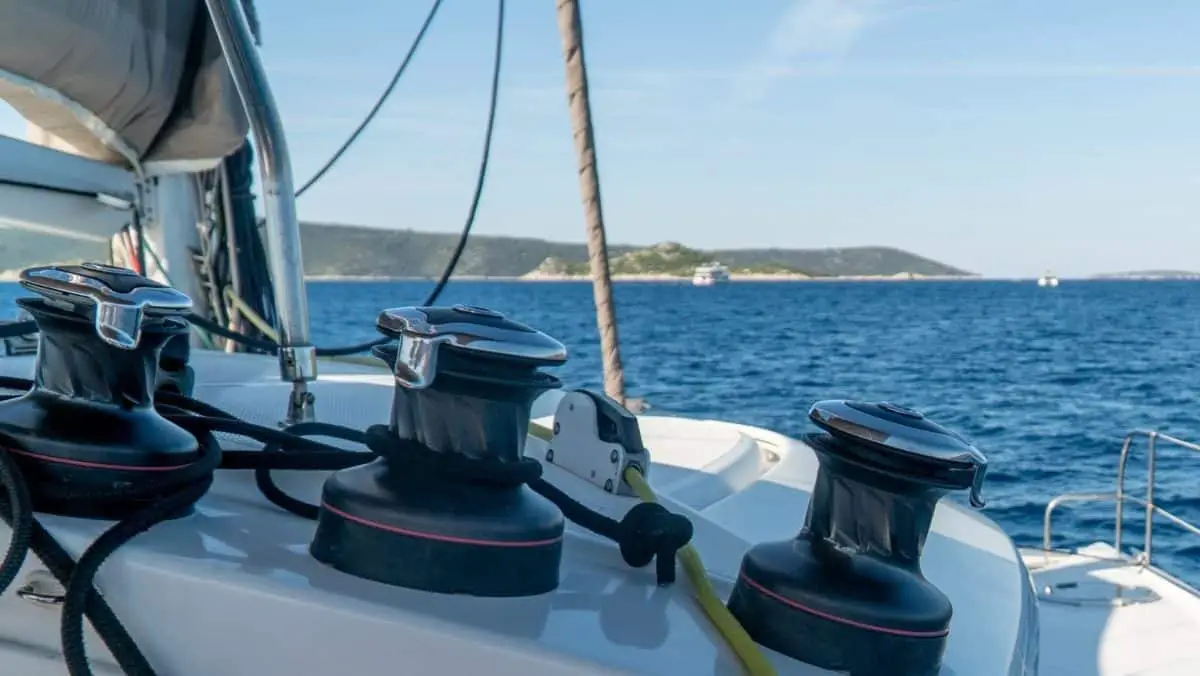
Catamarans Are Easy To Handle
Balanced hulls and twin engines make catamaran vessels significantly easier to operate than monohull yachts. Manoeuvering into narrow marinas becomes simpler and more straightforward too. This fluid maneuverability allows those with sailing experience to sail a catamaran single-handedly.
Is sailing a catamaran hard?
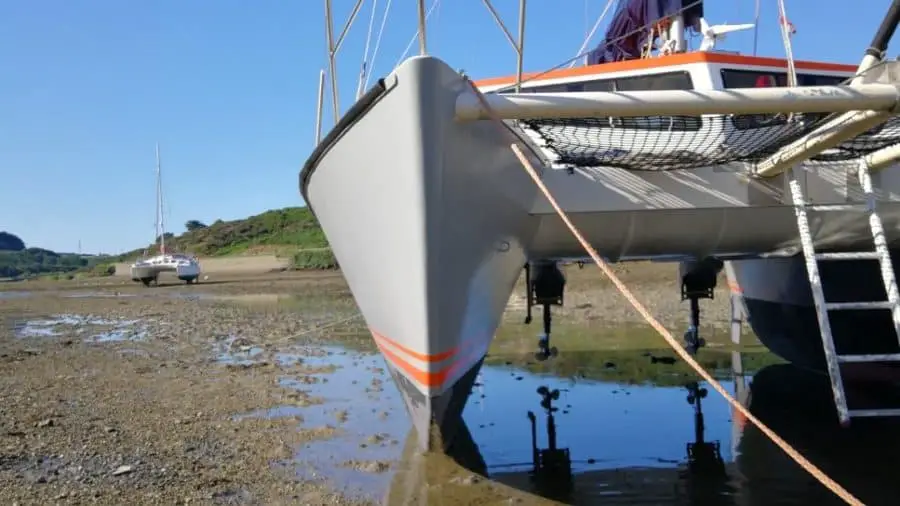
Catamarans Can Get Into Shallow Waters
When compared to monohulls, catamaran vessels have lesser volume, lighter displacement, and shallower draft. With less of the boat below the water, it means that you can pull the boat into shallow water without worry. This enables you to anchor much closer to the shore, where it’s safer, better protected, and more comfortable for anchoring.
Most catamarans can even go all up unto the beach !
Catamarans Use Less Fuel
A catamaran’s twin-hull design causes it to have low hydrodynamic resistance. As a result, the boats tend to use less fuel because they don’t require much sail or motor power to get them moving forward. This makes catamarans more economical to run.
Catamaran fuel efficiency
Catamarans Are Extremely Safe
It’s almost impossible for a catamaran to sink. The thing is, modern cruising catamarans consist of lightweight builds of foam construction, making the boats virtually unsinkable. This feature alone accords any sailor a high level of offshore safety, not to mention peace of mind.
When do catamarans capsize?
Catamarans: The Cons
Catamarans are great vessels, but they have their downsides. Let’s have a look at a couple of them.
Catamarans Are Expensive
Buying or chartering a catamaran is expensive. At times, the rates could go up by more than double the cost of similar-sized yachts. However, cats provide great value for money due to their unrivaled comfort, space, and flexibility. As such, when going for a sailing holiday, it makes great economic sense to opt for a catamaran.
Cats are also expensive to maintain. Two engines, two hulls, two rudders, multiple sails, and rigging translate to high maintenance and repair costs as there’s always something that needs fixing.
Why are catamarans so expensive ?
Catamarans Have High Marina Fees
Due to their great width, the rates charged in most marinas often go as high as 150% more than those for sailboats of a similar length. It’s also more challenging to find space in the marinas since cats require double spaces – try finding 2 empty slips right next to each other in a crowded marina. Worse still, some docks are not able to accommodate large-sized catamarans.
Note that catamarans are highly popular vessels, hence marina slots are usually limited due to the high demand. So, in the face of this serious challenge with space availability, it’s advisable to book the marina long before you come.
Catamarans Don’t Sail Upwind As Well
Catamarans find it difficult to sail too close to the wind. And some don’t point to the wind as well as monohulls, so they sail with a larger angle. Fortunately, most cats can sail pretty fast when on a reach. Therefore if you happen to fall a couple of degrees off, you can catch up with a monohull if you speed up. This is despite having to cover more ground.
How to sail a catamaran upwind
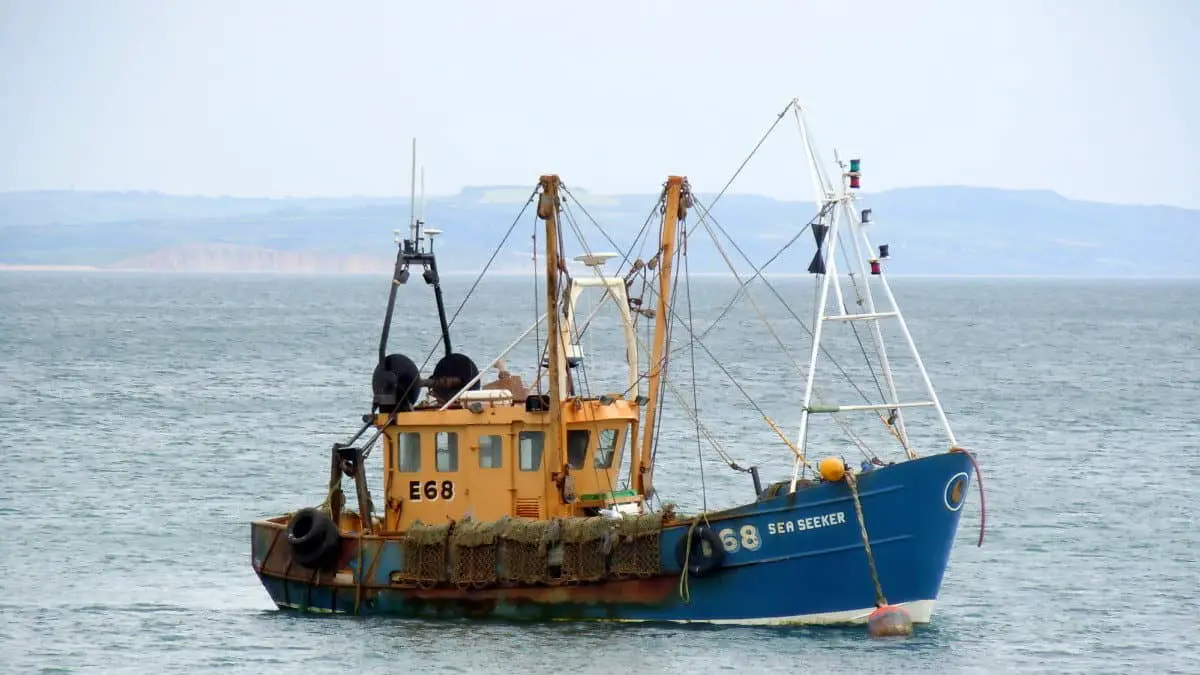
What Are Trawlers?
Trawlers are unique powerboats built for long-range leisurely cruising. They are also known as cruising or recreational trawlers . Many boaters live aboard these vessels for a long time as they move from one port to another. Trawlers originated from vessels used as commercial fishing trawlers; hence fishing trawlers and trawler yachts form the main types of trawler boats.
Fishing trawlers are the most common kind of trawlers. Built for fishing, they are popular with fishermen who use them to drag huge trawls (fishing nets) through the waters, capturing fish. However, they run at slow speeds to accommodate these fishing nets dragging across the water.
Recreational trawlers appeal to sailors who enjoy going on long-distance cruises but at a much-reduced pace. During winter, many retirees sail south down the intercoastal waterway and head back for the summer. And since speed is not the focus here, trawlers cruise at a slow and leisurely pace to their regional or worldwide destination.
Also, trawlers are versatile boats suitable for a wide range of activities such as day or night cruising, offshore boating, fishing, and sailing.
Cruising trawlers have well-laid out private staterooms, full galleys, and spacious saloons. These boats typically range between 35 and 60 feet (11 and 18 m), and most come with a single-engine, a displacement hull, and a raised pilothouse or deckhouse. However, it’s possible to find trawlers that sport two engines.
Trawlers: The Pros
Here are some benefits of using trawlers :
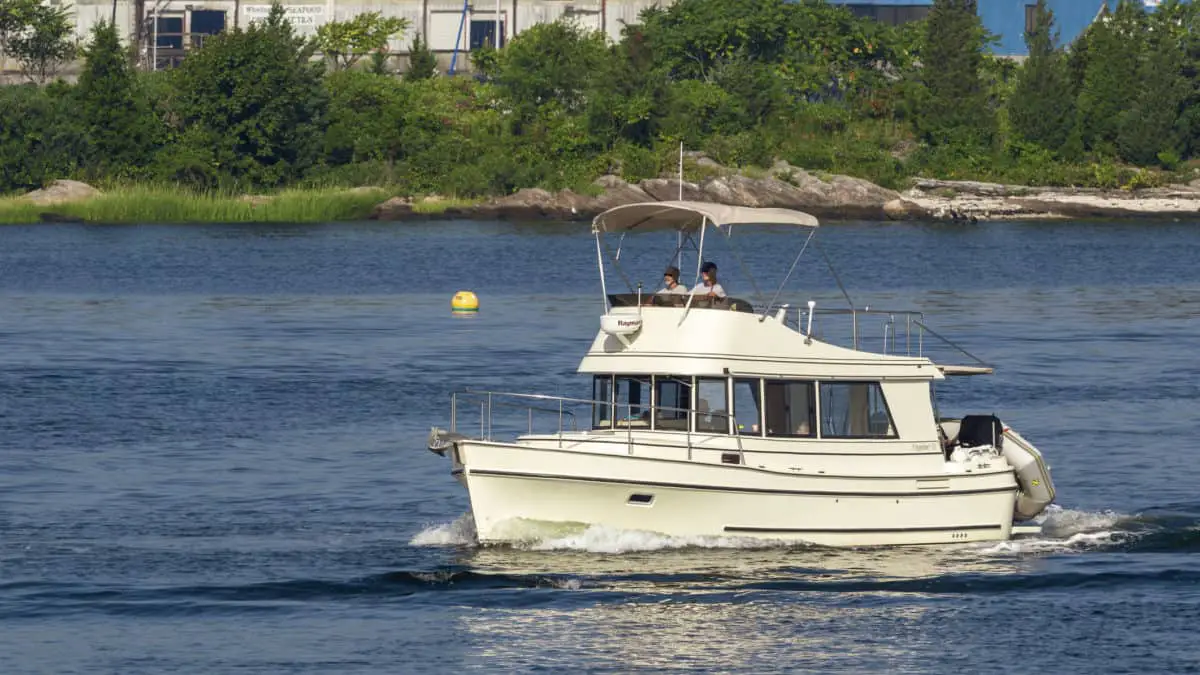
Trawlers Are Comfortable
Recreational trawlers are built for a comfortable and luxurious life on board. To this effect, they come equipped with fine staterooms and other creature comforts. The boats are super comfortable during calm conditions though they tend to roll from side to side in choppy seas.
Trawlers Have Big Living Spaces
Trawlers make superb family yachts and are excellent for entertaining guests. Below deck, they play host to large living areas that include a pilothouse, accommodation, a freezer hold, and big open galleys with ample headroom. The large windows brighten the interior while making it easy for parents to keep an eye on the kids while they play.
The boats also have lots of counter space, which means preparing meals for your family and friends is super easy. On the deck, the enormous flybridge offers unobstructed views and additional seating.
Due to their massive size, trawlers can comfortably fit 2 to 8 people for several days. What’s more, they can even make a permanent home.
Trawlers Have Considerable Storage Space
There’s no need to pack light on board a trawler boat since the available storage space is more than adequate. In addition to the standard closets, cabinets, and under-seat storage areas, trawlers also come with an enormous engine room that’s great for storing your spare parts.
There’s also extra room to store your stuff in the bow locker, beneath the top deck seats, and underneath the steering station.
Trawlers Have Two Helm Stations
Trawlers boast two helm stations: one in the interior and the other placed on the outside. The flybridge presents a favorable steering location, but during foul weather, you have the option of steering the boat from inside, away from the elements. The flybridge also enables you to catch spectacular views of the water when underway.
Trawlers Have Strong Weight Carrying Abilities
Unlike catamarans, which are pretty sensitive to weight, trawlers are designed to handle lots of weight. You can thus load up your boat without worrying about dampening its performance. In fact, you can even tow a large dinghy with trawlers.
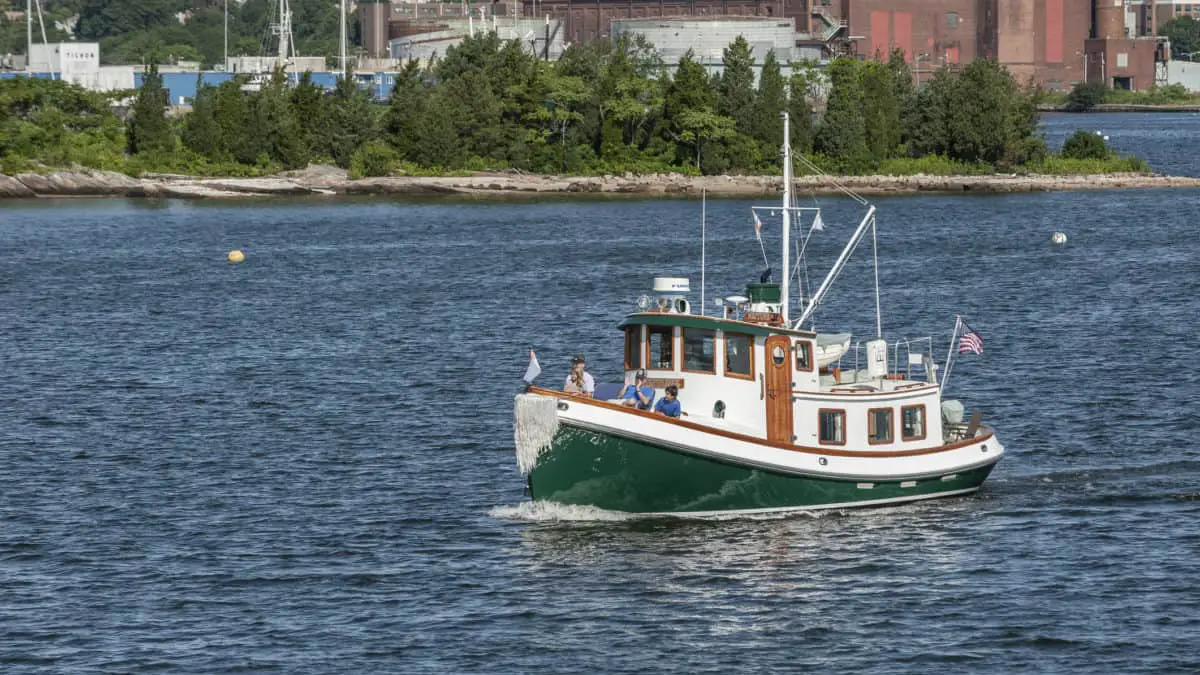
Trawlers Are Economical
Because trawlers have a large fuel capacity and a small, fuel-efficient engine, they can cruise for long distances without any need for refueling. This feature, along with the slower speeds of a displacement hull, allows these vessels to have greater range and fuel economy than other powerboats.
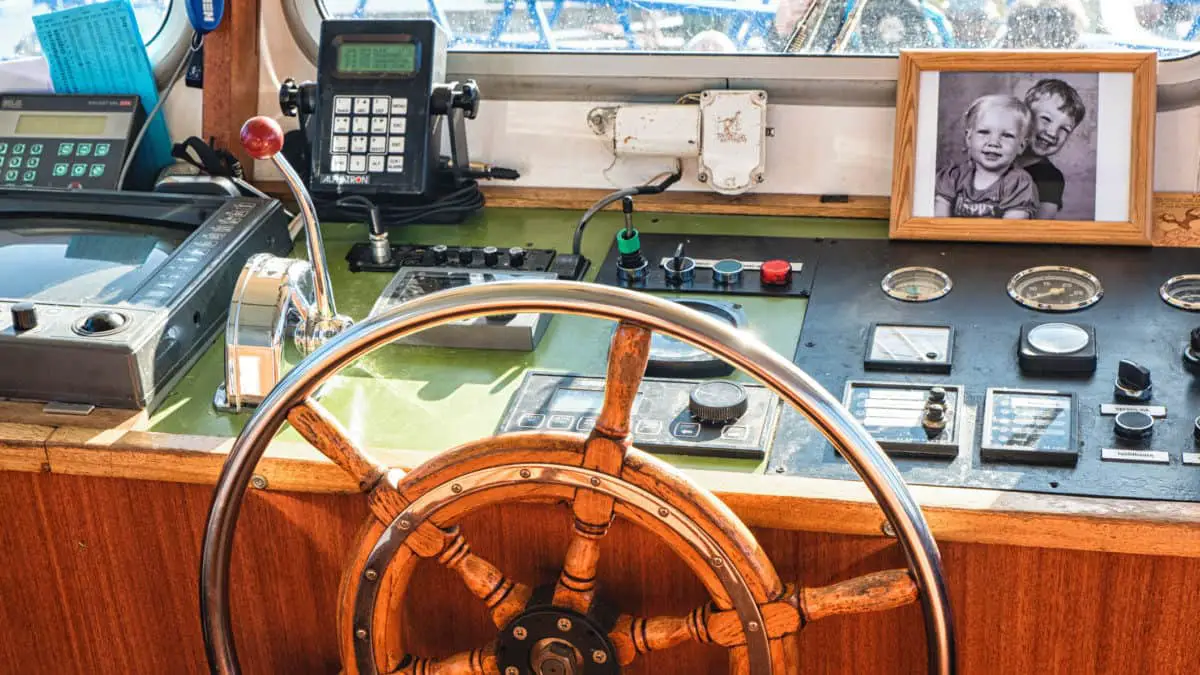
Trawlers Are Easy To Operate
Trawlers contain displacement hulls designed to enable them to navigate smoothly and efficiently through the seawater. The hulls have a rounded bottom while the boat’s bow and stern form a teardrop shape. The hull design affects the boat’s capability, and a ballasted full-displacement hull is best suited for rough waters. But for faster cruising, a trawler with a semi-displacement hull is the better choice.
A user-friendly learning curve makes the trawler an ideal choice for navigating bay areas and large water bodies. And since the boats rely on engine power, you can run them in any weather. Besides, if you are worried about sailing during the night, you need not be since with a trawler, you can sail safely from the inside helm.
Another exciting feature is the trawler’s shallow draft which allows you to fit your boat into marina slips with ease. It also means easy access to remote anchorages.
Trawlers: The Cons
Trawlers have their disadvantages too. Let’s take a look.
Trawlers Are Not That Fast
Unlike catamarans, trawlers do not have incredible speeds. Instead, they sail slowly – but steadily. The boats deliver cruising speeds ranging between 7 and 9 knots (13 to 17km/hr or 13,000 to 17,000m/hr) but can attain maximum speeds of up to 12 knots (22km/hr or 22,000m/hr). As such, you always need to pay attention to the weather forecast since your trawler might not be able to outrun a storm.
Again, a trawler designed with a full-displacement hull offers the stability required to combat rough seas, but at the expense of speed. Therefore, such trawlers cruise rather slowly.
Trawlers Have High Maintenance Costs
Cruising trawlers are like tiny homes, and given their numerous luxurious amenities, it is best to maintain them the same way you’d maintain your home. This means ensuring regular upkeep for the boat’s plumbing and electrical systems as well as the HVAC system.
Keeping a trawler’s tanks full can be a significant expense too due to fluctuating and unpredictable gas prices. Furthermore, extensive and continuous use makes trawlers prone to much higher repair and maintenance fees than other vessels.
Trawlers Heel in Choppy Waters
Unlike catamarans, which do not heel, trawlers tend to roll from one side to the other quite a bit. This happens both while underway and at anchor. This can be pretty uncomfortable, especially when you are trying to get a good night’s rest. It can also make it more challenging to control the boat in rough weather.
Trawler engines can get a little noisy, too, which can make your nights a little uncomfortable as well.
Which One Should You Go For?
Should you go for a catamaran or a trawler? There is no simple way to answer this question as both are excellent sea-faring vessels capable of delivering a satisfactory cruising adventure. Moreover, the right boat choice for you will depend on the intended use as well as your personal preference.
For instance, if you are planning to go on long-distance voyages that include ocean crossings, then the obvious choice would be a catamaran. However, if you have no plans to cross major oceans but still want to give your big family a long cruising vacation – or an overnight trip – then a trawler would be your best bet.
Final Words
Catamarans make ideal yachts for avid sailors and families interested in a relaxing and comfortable cruising vacation. Their greatest appeal comes from the generous spacing, stability, and comfy living quarters of these luxurious yachts.
On the other hand, trawlers are incredibly roomy, stable, and offer you all your usual home comforts, making them well-suited for an extended vacation or trip. Their large fuel capacity and fair cruising speeds also make them ideal for long-distance cruising.
While both boats have their pros and cons, going for either one will most likely depend on your budget, your cruising plans, or your personal preference.
Owner of CatamaranFreedom.com. A minimalist that has lived in a caravan in Sweden, 35ft Monohull in the Bahamas, and right now in his self-built Van. He just started the next adventure, to circumnavigate the world on a Catamaran!
Leave a Reply Cancel reply
Your email address will not be published. Required fields are marked *
Save my name and email in this browser for the next time I comment.
Recent Posts
Must-Have Boat Gear for Catamaran Sailors!
Sailing is probably the most gear-intensive activity I've ever done; there are so many decisions to be made about what gear to buy now, for tomorrow, and what to definitely never buy. The gear on...
6 Best Trailerable Trimarans For Bluewater and Coastal Sailing
Having a boat costs a lot of money, even when you are not using it, marina fees, etc. And once it is in the water most sailors never go very far from their "home marina" and sailing will be somewhat...


Performance Catamaran Comparisons
Performance cruising cats are becoming more popular and mainstream. A lot more brands have become available on the market over the last 10 years. Some of the most popular and well known performance cat brands are Catana, Outremer, HH Catamarans, and Balance. These boats’ popularity is not only driven by their amazing sailing abilities but also by YouTube channels like Sailing La Vagabond with their Outremer 45 and Gone with the Wynns who recently bought an HH 50 OC.
We Joined the Performance Catamaran Enthusiasts!
Catamaran Guru acquired a Catana Ocean Class 50. We take possession of the boat in September 2022 at the Cannes Yachting Festival . After a hiatus for a few years to focus on the Bali range, Catana released in 2022 their Catana OC 50 that has the industry abuzz including ourselves. Its new bulkhead helm station, the open plan design, the comfort, interior spaciousness, and the affordability convinced us to take the leap and buy one. Read our review here>>
Let’s Look at Some Fundamentals
Of course, before we bought the Catana OC 50, we did a little research on the most popular performance catamarans. We wanted to see how these boats compare in performance. One of the big factors that determines performance is Power-to-Weight ratio (or sail area to displacement ratio). We calculated the Bruce number and SA/D for the Catana OC 50, HH 50 OC, HH 50 Performance, Balance 482, and Outremer 51 . This is not the be-all and end-all but one do get a good indication of performance for these boats in steady sea conditions.
But before we dive down into it, let’s heed this advice from two veterans in the industry. Measuring a multihull’s performance is a complex issue that we all tend to want to boil down to a simplistic solution, which it is not. In the words of Tony Grainger: “…as a species hard wired for optimism, we’re prone to magical thinking, especially in the hands of marketing pros and advocacy scientists delivering theoretical solutions to complex problems.” As he says, “Prediction of performance and actual Observation are two very different things”. Phillip Berman from Balance Catamarans concurs: “Even the most accurate input, polar performance numbers on cruising catamarans are seldom achieved”. So, take this for what it is, simply numbers on a spreadsheet.
Some definitions:
- Bruce Number – a power-to-weight ratio for relative speed potential for comparing boats. It takes into consideration the displacement and sail area of main and jib (100% fore triangle only), no overlapping sails. Light boats are more easily driven than heavy boats and more sail gives you more drive.
- SA/D (sail area / displacement ratio): indicates the power of the sail plan relative to the displacement of the boat, regardless of the length.
We used the Bruce-SA/D calculator to calculate the SA/D range of values:
- 16 to 18 Heavy offshore cruisers
- 18 to 22 Medium Cruisers
- 22 to 26 Inshore cruisers, racing boats
- 26 to 30 Extreme racing boats
Catamaran Measurements

Points of Consideration
- We used the published numbers on the manufacturers’ websites to do the calculations and some of those numbers may be slightly off. We tried to verify but have not received feedback. Any input is welcome!
- We used only the mainsail and jib area on all the boats to get an apples to apples comparison.
- The “Lightship Displacement” quoted in each of the manufacturer’s specifications was used in the Bruce number calculation. Note there is an anomaly in that the Outremer, which is the biggest boat with the least carbon fiber, is quoted as being the lightest boat of the group. We think the lightship displacement quoted on the Outremer website might be inaccurate because it is unlikely that a predominantly E-Glass boat would be lighter than a full Carbon boat such as the Balance or HH performance. If anyone has reliable numbers for Outremer, we would love to hear from you! *We have received new information and have updated the weight of the Balance with new actual published numbers.
Some Observations and Conclusion
For performance cruisers there is a fine balance between speed and comfort and they are not for everyone. Speed does not always make for comfort. Operation of daggerboards, bigger and more powerful rigs and more complex running rigging require more skill, making them not suitable for the average cruising sailor. The conclusion we drew from this exercise is that all these boats are essentially very similar cruisers with very similar performance characteristics, except for the Balance, which stands out as the real performance boat. *Updated information shows that this boat is very similar now to the other boats. We believe that most of these boats are capable of good performance in light conditions, which is of course the beauty of a performance cat. These are our observations:
- The measurements for these boats are all very similar.
- Balance is the lightest boat (full carbon) at 25,353lbs 29321lbs with a big sail plan at 1,432 sq ft. These boats are super light and fast and moves in very light air. *We updated the Balance weight with new actual published numbers.
- According to the SA/D numbers, the Balance is rated in the “extreme racing” category at 26.549 and a Bruce number of 1.292. The Balance turns out to be very similar to the other boats SA/D “inshore cruisers / racing boats” category like the other boats
- The rest of the cats all fall into the SA/D “inshore cruisers / racing boats” category. So, these boats should all perform similarly and sail well even in light conditions.
- The Catana OC 50 (carbon deck and bulkheads) and the HH 50 Performance (full carbon), surprisingly are rated very similarly. The Catana is heavier but has a bigger sail plan and thus has similar performance to the HH.
- The HH 50 OC has mini keels rather than daggerboards and will likely not have the same performance to weather as the daggerboard boats.
- The Catana is the heaviest boat at 31,164lbs with the biggest sail area at 1469 sq ft.
- The Catana has the highest load carrying capacity of 10,723lbs – great for cruising and living onboard.
- The fuel tanks on both the HH catamarans are 4 times the size of the water tanks which is curious and nearly double the size of any of the other cats. That seems a little odd, but we could be wrong.
- Fuel capacities vary greatly between the boats, with Outremer having the least fuel capacity at 88 gal.
- Water capacity varies slightly, also. Catana and Balance carry around 210 gals while the others carry around 100 gals, which is a bit small for live aboard in our opinion.
We also concluded that while these stats are interesting data, they should not be the overriding factor when choosing a boat in the performance cruising category. Other factors to consider include quality, comfort, livability, equipment, safety, resale value, etc. Price is also a very big consideration. Balance (South Africa) and HH cats (China) are way more expensive than the French-built cats, Catana and Outremer, partly because the Balance and HH Performance are full carbon boats while the others have carbon infused deck and/or bulkheads. We believe that the Catana’s interior volume and comfort make it an extremely livable boat while still having the performance benefits of an express blue water cruiser and it is extremely affordable at around $1.5 million.
Having said all that, with the advancement of technology, more people will be able to sail these performance cats safely and will be able to afford them as more hulls are built and costs come down.
Here is another very interesting analysis Sailing into Freedom. The top 10 performance catamarans – Dazcat 1495, ORC 50, Odisea 48, Balance 526, Outremer 45, Outremer 51, Catana OC, HH 50, OC 50, Balance 482, HH44, Seawind 1370, Seawind 1600, Slyder 49, Privilege, Windelo 50. We would love for everyone to join the discussion. Let us know what you think in the comment box!
Learn how to sail a performance catamaran
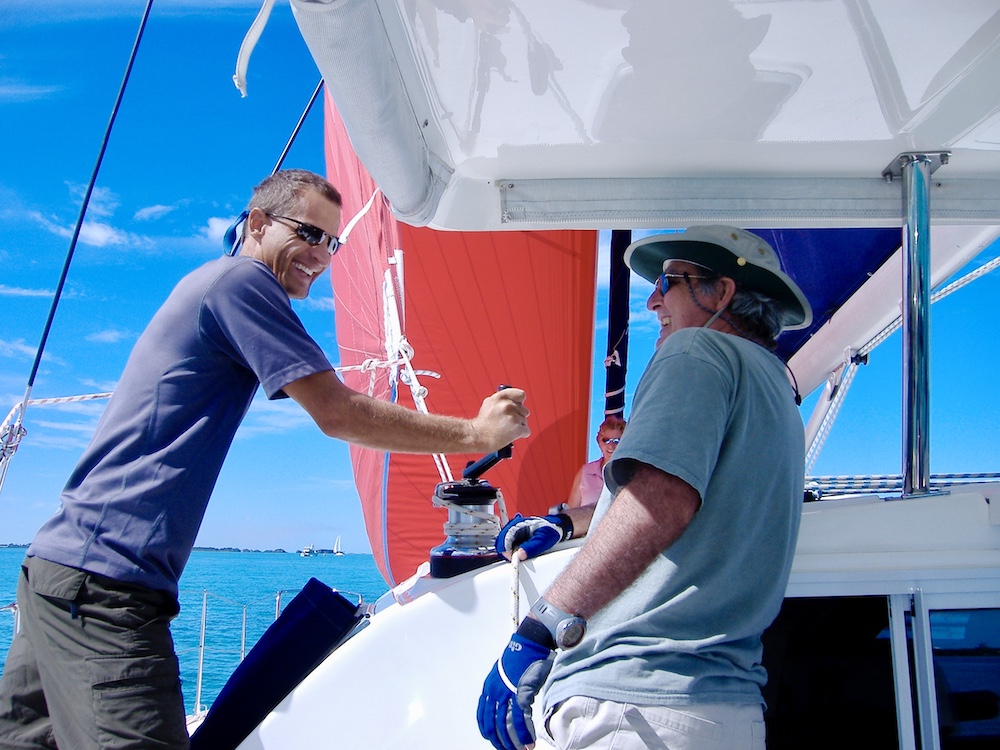
Our sailing school facility in Fort Lauderdale will start training on the Catana OC 50 with certified RYA instructors in March 2023. Contact us for more information about our sailing school dates and pricing.
Wanda Anglin
Join our community.
Get the latest on catamaran news, sailing events, buying and selling tips, community happenings, webinars & seminars, and much more!
Leave a Comment Cancel Reply
Your email address will not be published. Required fields are marked *
Save my name, email, and website in this browser for the next time I comment.
Recent Posts

Exploring Paradise: Belize Sailing Vacations & Yacht Ownership
In the heart of the Caribbean lies a hidden gem waiting to be discovered

Annapolis Open House 2024
Join us at Pier 7 Marina located at 48 S River Rd South, Edgewater,

Paramount Business Jets Partners with Charter Agency!
The collaboration of Myst Yacht Charters and Paramount Business Jets offer you the most luxurious yachts
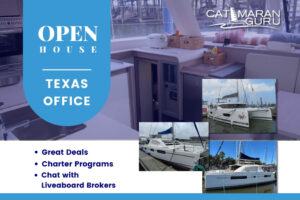
Texas Open House
Join us April 13 – 14 for our open house at our Texas office during the

For more than 30 years, we have been a part of the catamaran community and created Catamaran Guru™ to encourage and educate all the aspiring sailing out there. We understand the dream of traveling the world by catamaran and created a one-stop-shop to make that dream a reality for you.

- Stephen & Estelle
- Testimonials
Get Started
- Yacht Sales
- Used Yachts
- Charter Management
- Boat as Business Programs
- Seminars & Events

Catamaran Vs Pontoon Boat? 12 Important Facts (When Choosing)
A catamaran and a pontoon boat both have many similarities. However, they also have many differences, and there are reasons you might want to choose one over the other.
In this post, we’ll compare catamarans and pontoon boats so that you can decide for yourself which type of boat will work best for you and your needs.
Table of Contents

The Deck Space Area
Pontoon boats consist of a deck that sits over the top of a set of pontoons. This can be two or more pontoons depending on the size of the pontoon boat. These pontoons are usually made from aluminum, and the only purpose they serve is to support the deck.
Because of this, the deck sits completely over the pontoons as the pontoons will never be accessed from the deck. With catamarans, this is completely different.
A catamaran has a set of hulls that serve the same purpose in that they support the deck. However, they can also be used for storage and for living quarters.
Because of this, the hulls of a catamaran need to be accessed from the deck. This cuts down on deck space when compared to a pontoon boat that does not need to create access points for hulls.
On top of this, most catamarans will have an enclosed space that the captain can use to pilot the boat. This enclosed space can be inside the Salon area or even overtop of it.
Pontoon boats usually have a windshield and a bimini top to protect the driver. The exception would be in a pontoon houseboat where the captain might be within close quarters.
As a result of all of this, a person with a pontoon boat will have more deck space than a person with a similarly sized catamaran. However, this doesn’t take into account that often-times, catamarans are larger and wider than standard pontoon boats. This means that if you want a large amount of deck space, you could go with a larger catamaran versus a smaller pontoon boat, as the larger boat will still end up with more deck space.
The Hull Space Size
As we said earlier, a pontoon boat covers its pontoons with the deck. A catamaran also sits its deck on the pontoons, but it still provides access to the hulls.
Catamarans will often have berths and heads inside the hulls. In fact, larger catamarans may have multiple berths and heads located inside of the hulls.
Slightly smaller catamarans that lack the space for a kitchen on deck may even have a small galley kitchen inside one of the hulls. Go even smaller, and the catamaran may not have room for any living arrangements within the hull, but it will still provide access to the hulls for storage.
A pontoon boat does not offer any of these benefits. With a pontoon boat, the pontoons do not serve any additional purposes other than to keep the boat afloat. This can be good as it cuts down on weight, but it is limiting as far as space goes. It’s also limiting as far as living space goes as well.
Sailing Capabilities
If you want to go sailing, you’ll need to stick to buying a catamaran.
Sailing catamarans can be found in the form of small sailing crafts, and they can be found in the form of large ocean cruising sailing catamarans.
Some people prefer sailing catamarans over standard monohull sailboats because these boats don’t heel like traditional sailboats. Others prefer monohull sailboats because they do heel.
Some people also feel that monohull sailboats are easier to learn to sail on as catamarans do not provide instant feedback like a monohull sailboat might.
For more information on the differences between catamaran sailboats and monohull sailboats, please read my post titled, Catamaran Vs. Monohull Boat Facts .
You won’t find sailing pontoon boats at all. In fact, you’ll really only find two types of pontoon boats. The first type is the recreational type with lots of deck space. The second type is the house-boat type that you might find on lakes, rivers, and protected bays.
Do You Want To Race?

As we just mentioned, you won’t find any standard pontoon boats with sails on them. For this reason, you won’t find any pontoon boats in sailboat races.
However, you can and will see sailing catamarans raced.
These boats may not be as thrilling as monohull sailboats for racing, but they can be raced recreationally, just like any other type of sailboat. This is especially true with the smaller models known as Hobie catamarans.
The motor versions of both of these boats could technically be used for racing, but this isn’t something I’ve ever seen or even heard of. These boats sit on the top of the water so they can pick up decent speeds on calm waters, but they really aren’t designed for serious racing like a racing motorboat.
Recreational Use?
There are many recreation opportunities with both of these types of boats.
The recreational opportunities that exist will vary based on the features of the boats and the types of boats within each category.
Some of these different types include:
- Pontoon houseboats.
- Standard pontoon boats.
- Pickup truck fishing pontoon boats.
- Hobie sailing catamarans.
- Ocean cruising catamarans.
1) Pontoon Houseboats
A pontoon houseboat might have water slides and diving boards connected to it. These boats can also have large recreational areas both within and above the housing areas.
Pontoon houseboats are perfect for people looking to have large parties or for those looking to spend a weekend out on a large lake or river. In fact, these types of houseboats can often be found for rent on some of the larger lakes and rivers throughout the country.
2) Standard Pontoon Boats
A smaller pontoon boat might have built-in grills for barbecues and built-in stereo systems for cruising. These boats can be great for people looking to spend a day out on a small island. I’ve done this myself on South Carolina’s Lake Murray, and it was a lot of fun. Because the pontoon boat can penetrate into shallow waters, we were able to run it right up to the island that we wanted to swim from.
These smaller pontoon boats can also be used to pull water skiers, kneeboarders, and tubers. They are great for this because they are straightforward to get in and out of the water with. These boats are usually low enough in the water that a ladder won’t even be needed.
3) Pickup Truck Fishing Pontoon Boats
You can fish off of any pontoon boat, but the ones that can be loaded into a pickup truck are even more convenient to fish with. These boats have decks that slide in so that the pontoon boat can be reduced in width.
Once the boat is collapsed in on itself, it can easily be wheeled into the back of the truck. When the person is ready to fish with the boat again, he needs to wheel the pontoon boat out of the truck and to the water. Once at the water, he can make the deck wide again.
4) Hobie Sailing Catamarans
Hobie sailing catamarans are small catamarans that are built just for recreational sailing. These boats can be used for high-performance sailing as well as for cruising.
The nice part about these types of sailing catamarans is that they are often small enough that they can be put on a trailer.
This makes them great for recreational sailors that do not have a place to dock their boat. In fact, some of these boats are so small that you can place them on top of your vehicle.
5) Ocean Cruising Catamarans

We’ll talk about this more in the next section, but needless to say, many catamarans are large enough that they can be taken across the ocean.
In fact, many people who wish to sail the ocean via the island countries will choose catamarans because their shallow draft gives them the ability to get close to land without having to worry about hitting bottom and causing a hull breach.
Also, a large sailing catamaran’s additional stability can make sitting at an ocean dock more pleasant. This is because a catamaran will not rock back and forth as much as a typical boat might.
6) Recreational Advantages
Neither type of boat has an overall recreational advantage over the other. Catamarans are a more seaworthy design for rough weather and big waves. Pontoon boats are great for lots of room and cruising on a calm lake.
Certain types of catamarans will meet some people’s recreational needs, while certain types of pontoon boats will meet other people’s recreational needs.
Ocean Faring Is Best Done With Catamarans
As we said earlier, a catamaran is capable of cruising across the oceans while a pontoon boat is not.
This is mostly because of the way the two boats are built.
Catamarans are often built to category A status so that they can sail out into the ocean.
Also, catamarans are often built with sails, while pontoon boats are not. People looking to do long ocean voyages will usually choose a sailboat so that they are not restricted by how much fuel they can carry. As a result, even if a pontoon boat were built strongly enough to navigate rough ocean waters, it would also need a sail added to it. Do both of these things to a standard pontoon boat, and you have basically converted your pontoon boat into a catamaran, but with much worse performance.
Pontoon Boats Are Smaller Than Catamarans
One of the reasons why catamarans can go into the ocean and pontoon boats cannot is that catamarans are often built to large sizes. It is easy to find a catamaran that is over 40 feet long, but you won’t find a lot of pontoon boats that are built to these lengths.
The exception to this is with pontoon houseboats, but these boats are usually not built strongly enough to traverse the ocean.
According to Pontoonopedia , the most popular pontoon boat size is about 22 feet in length. Sailing catamarans, on the other hand, often range from 35 – 50 feet long.
Catamarans Can Be Costly
If you’ve read my post on Boat Price Comparison (a great read to get a basic understanding of different boat types), you’ll know that catamarans typically start off at a price of $10,000.00.
But they can go all the way up over a million dollars depending on the type of catamaran that you buy.
However, you can get some smaller Hobie catamarans for less than $10,000.00.
Pontoon boats typically cost between $15,000.00 to $50,000.00. However, this assumes that you’re buying a standard pontoon boat that ranges between 20 to 30 feet in length. If you buy a small pontoon boat for the back of your pickup truck, you could spend less than $5,000.00. If you decide to buy a large house pontoon boat, you could still end up spending hundreds of thousands of dollars.
As you can see, it is hard to do a price comparison on these boats as they are so different from each other. When making a financial decision, you’re better off deciding on what type of boat you need and then deciding between buying a new one versus a used one. This will help reduce costs when needed while still providing you with the type of boat you actually want for your particular use.
Maintenance Issues To Consider
The maintenance on a catamaran is usually more entailed than it is on a pontoon boat. There are many reasons for this. For starters, motor catamarans will always have two motors.
A pontoon boat is narrow enough that it can have a single outboard motor built onto the back of it.
Secondly, a pontoon boat cannot be a sailboat, while a catamaran can. Sailboats often come with more maintenance because the sails need to be examined and cleaned off each and every time you use them. This is especially true for people heading out into the ocean on a sailing catamaran. One ripped sail or damaged piece of hardware, and the person could be stranded at sea in their catamaran.
Another reason that catamarans require more maintenance is that they are made from fiberglass, while pontoon boats are usually made from aluminum. Aluminum boats can become dented, but it takes a lot to put a hole in them.
Fiberglass boats, on the other hand, can easily become scratched, and holes can form in them.
The additional space of a catamaran can also lead to more maintenance. A pontoon boat does not have living quarters inside of the hulls to maintain. Maintaining living quarters within the hulls is a bit more work than maintaining houseboat living quarters that are all built above the deck.
Resale Value And Depreciation
Typical pontoon boats seem to go down in value quickly. In fact, it is usually better to buy them after they are already a few years old as you’ll lose a lot of value through depreciation over the first three years of ownership. After this, the depreciation tends to level off, and the boats depreciate in a similar manner to most other boats.
The resale value of a catamaran is usually pretty high.
Catamarans are more difficult to find, so there is less competition in the used market. This is great for people trying to sell their catamaran on the used market but not so great for people looking to buy a used catamaran.
With a pontoon boat, I’d always recommend that you consider buying a used boat. With a catamaran, you might want to shop around before deciding between buying a new or used boat.
If you are the least concerned about the resale value of your boat, you need to read our complete guide to boat depreciation . We did an extensive study on a ton of data to give you a clear picture of exactly what to expect from each boat type.
DIY Enthusiasts? Look Here
I haven’t seen a lot of DIY catamarans in recent years. These boats are a bit more complicated to build when compared to both monohull boats and standard pontoon boats.
On the other hand, I’ve seen a lot of DIY pontoon boats.
Some people take standard pontoon boats and build houses on top of them. These people save a lot of money by doing this as they usually buy a used pontoon boat for less than $10,000.00 and are able to build a cabin on it for only a few thousand dollars.
I’ve even seen some people make temporary tent houses out of their pontoon boats, which is an even more economical way to make a DIY houseboat. This isn’t something you see with a catamaran. A catamaran is either built with an interior, or it is not.
DIY enthusiasts often build smaller pontoon boats from scratch as well. People will use 55-gallon drums, barrels, and even large pieces of PVC pipe to create their own little DIY pontoon boats. A small sailing catamaran can potentially be built in the same way, but the larger versions certainly cannot. A few pieces of PVC pipe just isn’t going to seem seaworthy to any sane person.
Other Boat Types To Consider
People considering a pontoon boat will often look at deck boats, airboats, and even Jon boats.
This is because these types of boats meet the same needs that a typical pontoon boat meets.
When a person considers buying a catamaran, they are usually comparing it to a monohull sailboat, a yacht, or a large cabin cruiser. This is because these boats match the needs that a catamaran owner is usually trying to meet.
Final Thoughts
Catamarans and pontoon boats both have their own unique uses.
If you’re thinking about buying one of these boats, consider how you might use the boat and go from there.
It’s impossible to say which boat is right for you as everybody has different needs and priorities. But it would help if you had a clear understanding of the differences between pontoons and catamarans after reading this article.
Click to share...
- Find Us On Facebook
- Find Us On Instagram
- Watch Us On YouTube
- Find Us On LinkedIn

Power Catamarans vs Sail Catamarans, What’s the Right Choice For You?
Sail and power catamarans are both great boats with distinct advantages. To choose what is best for you, think about how you will be using the boat. The good news is they both work with our Business Yacht Ownership ® program.
Sail Catamarans

- Sailboats are better if you want to follow the sun or do longer range cruising.
- With the right prop and engine, sailboats can do 9-10 knots and are very sea-worthy. They provide comfort at sea. If you just feel like laying back and relaxing, you can almost forget the mast is there. But, when the conditions are ideal, you will be able to sail. New designs and technological advancements make sail handling easier than ever.
- Sailboats are quiet and promote socialization. Generally, they can handle more guests at a time, whether they are socializing or sleeping.
- Sailboats cost less per cubic ft. of volume. The Helia 44 has as much or more room/volume than the Cumberland 47.
Power Catamarans

- They have low clearance. If your cruising plans involve a bridge with height restrictions, a power boat may be the better option.
- A properly, dedicated purpose catamaran powerboat gives significantly better speed and range than a comparable monohull powerboat.
- The Fountaine Pajot Motor Yacht offers the exceptional characterics of the catamaran platform, giving you a very comfortable ride and virtually eliminating rolling at anchor.
- The Fountaine Pajot Power cat is less expensive to run than a monohull and can compete with the economy of a trawler. The power cat also offers the efficiency of the hull, which allows you to go faster when you need to (up to 22 knots or so). This is not possible under normal conditions with a trawler or sailing cat.
Learn more about power catamarans
Senior Sales Consultant, Partner [email protected] 410-703-5655 More from Eric >> Boat Business Webinars, Videos, Blogs, Learning center and more.
Disclaimer : The information, views , opinions , and conclusions expressed in any article , blog, video, or other form of media posted or linked herein are those of the authors and do not necessarily reflect the views of Atlantic Cruising Yachts, LLC. Nothing contained herein has been approved or otherwise endorsed by Atlantic Cruising Yachts, LLC and such company shall have no liability for any content.
ESE, LLC is totally responsible for the content of this article. We are not tax advisers. You should obtain tax advice from a professional tax adviser for any matters relating to setting up a business, or tax implications .
Notice of Use of Cookies
We use cookies and similar technologies to recognize your repeat visits and preferences, as well as to measure the effectiveness of campaigns and analyze traffic. To learn more about cookies view our Privacy Policy . By continuing to use our site, you consent to the use of cookies.

IMAGES
VIDEO
COMMENTS
Cruiser vs. Catamaran. A cruiser is a monohull—a vessel with one capsule to accommodate passengers. Catamaran, on the other hand, has two hulls. Between these hulls lies the middle of the boat. The front netting and cockpit occupy the middle part of the boat. The last few years have seen an increase in the popularity of catamarans.
Lagoon 380. The long-time best-seller from the world leader in catamarans, with more than 1,000 produced over almost 20 years from 1999. With its characteristic vertical windows, the 380 and its ...
Photo via World Cat Boats. World Cat is one of the most recognizable brands in the world of power catamarans — in fact, according to the company they're the largest producer of power catamarans in the world. Their line is a mix of center console and dual console fishing and family boats ranging from 23' to 40'.
Among the most popular form of cruiser, express cruisers range from 25- to 63-feet-long. Best uses: day trips and weekend overnight cruises. Cabin Cruiser— Though the term isn't used as often as it once was, a cabin cruiser features a raised cabin with side windows. The helm is usually beneath a hardtop, and the cockpit is open.
Attach one line to each of the forward cleats and bring the loose ends to the center. Pick up the mooring with a boathook. String one line through the eye and bring it back to the same cleat. Repeat on the other side, keeping the lines the same length so the cat is centered.
Some of the best catamarans for cruising are the Sunreef 60, the Leopard 45, the Saona 46, the Manta 42, and the Antares 44i. A good cruising catamaran offers plenty of space, extended range and is optimized for comfort and safety. A cruiser is slower and less exciting to sail than a performance cat.
While the Fountaine Pajot dealer touts the superior performance of their brand, actual data shows that the Lagoon brand has won more ARC cruising rallies than any other brand of cruising catamaran. These are hardly the statistics of "just a charter catamaran that sails in 50-mile circles and lacks performance", as is claimed by this dealer.
The Outremer 4x is a stable and comfortable high-speeding cruising catamaran that performs ocean crossings and confronts any weather with remarkable ease. Named the European Boat of the Year in 2017, this 48-foot (14.6 m) bluewater cruiser sails faster than wind speed and attains maximum cruising speeds of 20 knots.. The 4x is an upgrade of the extremely popular Outremer 45, thus retaining ...
Speed. Pontoons can travel at around 15-25 miles an hour, which is more than enough speed for your average watersports enthusiast and can cruise slow enough for more relaxing boating trips. For more details see our guide: Pontoon Boat Speeds. Catamarans can travel around 11-17 miles an hour and are roughly a third faster than their monohull ...
Gemini 105M Courtesy of Gemini Catamarans. Pioneering catamaran sailor, builder and designer Tony Smith launched the first of his 33-foot Gemini 105M's (10.5 meters = 33′) in 1993, and soon after found a ready and willing stream of sailors enamored of the boat's compact size, affordable price tag, and such innovations as the nifty lifting rudder and transom steps.
Based on the successful Nautitech 46 Open sailing catamaran, the new Nautitech 47 Power redefines the aesthetic, as well as practical parameters of today's power multihulls.The dynamic Nautitech 47 Power benefits from the same streamlined design as the sailing version. The semi-displacement load-carrying hulls give the Nautitech 47 Power performance advantages over other power catamarans ...
The best production blue water cruising catamarans are the Manta 42, the Lagoon 42, the Leopard 45, the Lagoon 450, and the Prout 45. These vessels have excellent living accommodations and great sea keeping abilities. In this article, we'll cover five of the best liveaboard cruising catamarans, along with what sets them apart from similar ...
HH Catamarans emerged 10 years later, building boats from 44ft to 88ft in Xiamen, China, with the same contractor that once used to build Gunboats. And Kinetic is more recent still, with ...
Scheduled to debut at the Miami International Boat Show in February, it is an evolution of the Leopard 51 Powercat, with more than 135 of those sold, according to Leopard Catamarans. The builder projects a top speed from a pair of 370-hp Yanmar 8LV diesels at 25 knots, with a cruising speed of 17.5 knots.
The Aquila 36 is the first vessel in the builder's series with outboard power. Aquila Boats. The Aquila 36 is a departure from her sisterships in that she is an outboard-powered, express-cruiser-style catamaran, but she also adheres to MarineMax's philosophies.. With a single main living level from bow to stern and a beam of 14 feet 7 inches, the Aquila 36 is like a bowrider on steroids.
Jul 30, 2018. Original: Aug 17, 2015. Two sailboat experts argue monohull vs. catamaran. Contributed by Denison Yacht Sales. The great debate over which is better—one or two hulls—boils down to several factors, each with distinct advantages and disadvantages. The verdict usually defaults to personal preference and intended use of the vessel ...
Good - Catamarans can also be used, especially power catamarans, but are generally more expensive. Day Trips: Best suited - Perfect for short, leisurely day trips with family and friends. Good - Catamarans are also suitable but might be more than needed for simple day trips. Long Voyages: Less suited - Not designed for long or open sea ...
The debate between catamarans vs monohulls still rages, and most boaters are firmly on one side or the other. The truth is, either a catamaran or a monohull. ... This is a consideration when cruisers consider adding additional equipment. For example, a catamaran owner will have to consider the added weight of a generator and its detriment to ...
Re: Trawler vs Catamaran. A sailing catamaran might be the best solution for you. A cat will bounce and roll (a bit) in rough water and the sail will give some stabilization unlike a pure power cat. On most points of sail a sailing cat will be faster, maybe much faster than an equivalent length monohull.
Catamarans are double-hulled yachts that come in both sail and power editions (two diesel engines). Trawlers are single-hulled displacement boats powered by one diesel engine. Trawlers have better loading capabilities but cats are faster and more stable. For anyone not very familiar with boats or sailing, it can be challenging to decide on the ...
Here is another very interesting analysis Sailing into Freedom. The top 10 performance catamarans - Dazcat 1495, ORC 50, Odisea 48, Balance 526, Outremer 45, Outremer 51, Catana OC, HH 50, OC 50, Balance 482, HH44, Seawind 1370, Seawind 1600, Slyder 49, Privilege, Windelo 50. We would love for everyone to join the discussion.
Pontoon boats typically cost between $15,000.00 to $50,000.00. However, this assumes that you're buying a standard pontoon boat that ranges between 20 to 30 feet in length. If you buy a small pontoon boat for the back of your pickup truck, you could spend less than $5,000.00.
Power Catamarans. Power catamarans are also great boats, and although their benefits are different from the sailboats, they definitely have their advantages. They have low clearance. If your cruising plans involve a bridge with height restrictions, a power boat may be the better option. A properly, dedicated purpose catamaran powerboat gives ...